BLUE MOUNTAIN
Issue 29 SEPTEMBER 2023
A RIPPLE IN THE POND: THE UNIVERSAL SELF WITH ACTOR/MUSICIAN TOMMY HOWELL

Respecting and Expanding Jazz With Lizzie Thomas

ON THE HEALING PATH with JAMES FINLEY

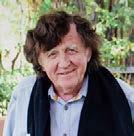
CARL PHILLIPS LIVES A LIFE ASKING QUESTIONS
ANA MARíA CABALLERO ON APETITMAL Luke Johnson : A Walk Through Life & Quiver
be drawn by the poetry of KENDEL HIPPOLYTE
Paradise & Dining with the crown
Poetry, Fiction, Essays, & Microfiction
A JOURNAL OF CULTURE
THE
REVIEW
kendel hippolyte
james finley
Lizzie thomas
TABLE OF CONTENTS INTRODUCTIOn ................................................ 1 Befriending the San Andreas by Luke Johnson LITERARY INTERVIEWS.......................................5 Ana María Caballero........................................................... 7 Carl Phillips...................................................................... 11 Denton Loving ................................................................. 13 J. Bruce Fuller ............................................................... 21 Dr. James Finley................................................................ 23 Jesse Lee Kercheval ........................................................... 27 Kaya Oakes ........................................................................ 31 Kendel Hippolyte .............................................................. 35 Luke Johnson .................................................................... 37 Sean Ferrier-Watson ........................................................ 41 MUSIC INTERVIEWS......................................... 45 Tommy Howell ................................................................... 47 Abe Partridge ..................................................................... 53 Lizzie Thomas ................................................................... 57 VISUAL ART INTERVIEWS................................. 61 Charles Bremer .................................................................. 63 Ilene Gold ......................................................................... 67 Stephanie Leonard ........................................................... 68 Nick Kelsh .......................................................................... 69 SPECIAL FEATURE INTERVIEWS......................... 73 Brian Ross ......................................................................... 75 The Crown Brasstown’s Donna Forysth, Derek Mazza & Jake Diaz ...................... 81 FASHION INTERVIEWS .................................... 87 Allen Amun .................................................................... 89 BOOK REVIEWS ............................................ 95 Cooking Tips for the Demon-Haunted by Kathryn Kulpa ............................................................ 97 The Box Must Be Empty by Marilyn Kriete .............................................................. 99 MICROFICTION .............................................. 103 Dolly, My Dolly by Suzanne C. Martinez .................................................. 105 Then-Now by Suzanne C. Martinez ................................... 106 Essays ....................................................... 109 Hana Days by Douglas Cole ............................................. 111 One Out of Two by Fay Loomis ......................................... 115 Don’t Trip by William Freeney ....................................... 117 Fiction ....................................................... 121 At Eternity’s Gate by Brent Atkinson ............................. 123 Thistle by Carissa Stevens ........................................... 127 You Had Me at Bezos by Jenna Geisinger ........................................................ 129 The Walls Came Tumbling Down by Richard Stimac ........................................................... 133 POETRY ....................................................... 135 A Cathedral is Burning in Paris by Steve Bellin-Oka ........................................................ 137

Matins by Michael Metivier ........................................... 139 Love Song for Emily by Lenny DellaRocca ........................................................ 143 The Direction Love Moves In by Caits Meissner .............................................................. 145 Station to Station by Brendan Constantine ................................................. 149 Ode to a Suitcase by Mary Morris ................................................................. 151 Dying is a Story Told to Frighten by Jared Povanda ............................................................ 153 Inside a Forest Where the Only Weather Is Rain by Jared Povanda ............................................................ 155 Scar by Alexandra Burack ................................................. 159 Cord by Ana María Caballero ......................................... 161 Snow Pantoum by Cynthia Atkins ................................... 165 To Do the Unstudied Thing by Allyson Jones .............................................................. 167 Invisible Other by Allyson Jones ..................................... 169 The Only One by Christopher Locke ................................ 173 Climate Strike, New York (Sept. 20, 2019) by Kendel Hippolyte ........................................................ 177 I Corinthians 15:51 by Kimberly Ann Priest .................................................. 179 Fevered Clove: With a Nod to BPK by Luke Johnson ............................................................... 181 Sunflowers, Sunshine, Sun by Lynne Kemen ............................................................... 185
BEFRIENDING THE SAN ANDREAS
by LUKE JOHNSON
This is not a sob fest. Do not find my email to send me your condolences or turn me into a victim. I’m no Bambi. I’m no blind, barefooted mystic with my tongue excised by birds. I’m currently going through it, but so many of you reading this are as well. See how that works?
Last Winter, as the rain thrashed and the Pacific turned its foreboding cape, I watched an abandoned boat bash against the break and felt, for a moment, like I’d witnessed God, his endless proverbial power. My daughter had begun to bleed. And as hours turned into weeks, she grew pale and paler, her sunken cheeks sad and diminished. Like that boat we began to splinter. Darkness settled in our home and fear became the quiet cello coursing through our dreams.
Therapists call seasons like these a new normal. Novelists refer to them as a plot twist. Poets? A pivot, leap or volta. That moment when a verb adds ignition and kicks the lyric through a portal into another world. The after effect is surprise, wonder, a high as good (okay that might be a stretch) as sex or sudden flotation (think Marty McFly’s hoverboard). But at the end of the day a poem is just a poem, a song a song, a story still a story. Each form is shaped by fractals of its maker, but equally individual and independent. They are the toy train colliding with a couch cushion, the snow globe buried in sand. Not real.
When a volta hits our real, mundane, flesh and blood life, we’re shell shocked, numb, in denial or emotionally avoidant. A fault line forms from a tremendous shake and our floors slant. We walk askew, but tell ourselves everything’s normal.
Cue cellos.
At some point the cellos stop though. Breath returns and our lungs stutter with fire. The sky, which seemed oppressive and near, has drawn back, and as much as you hate it is rainless and beautiful now. Birds, so many of them, swarm the trees and the wind is milk and honey. Even the sea is seamless. You feel guilty for the beauty, despise it. Guilty for that first deep breath in months. It isn’t fair, am I right? How life keeps moving forward despite our deepest sorrows?
If you answered yes to the previous questions congratulations. That yes means you’re human. It knits you to the quilt of life and adds teeth to your creations. One of my biggest triggers is when I spend hard earned money on a book or record or film that veils its truths, that tries to sound smart. It’s not sexy. In fact, to me, it’s sad. The art reflects an underbaked inner life.
What I didn’t tell you was this: as the boat bashed and the rain kept turning, the smell of apple crisp flooded the house. Each year my daughter looks forward to the holidays and their traditions. It begins the first week of September, when we go to apple country, and ends the day after Christmas. All season she plays Sinatra, A Charlie Brown Christmas and The Harry Potter soundtrack. Despite the blood, she kept living. Looked forward to festive candles in jack o lanterns, the bells of holiday cheer. Yes, she sometimes succumbed to the pain. But overall nothing stopped her, a sobering truth that was hard to swallow.
Joy, my friend (can I call you that?) is relentless. It can’t be consumed. It’s that still small flame that leaps when catching air, a stubborn song. I want to tell you the doctors found the right remedy and my daughter is all okay. But that would be dishonest. When a fault line splits the core of the earth, rivers, creeks, mountains and valleys are born. I’ll never forget the moment I stood inside the mouth of the San Andreas, the Carrizo plains in bloom. It was as if God had opened his jaw and I too was tempting fate. All I wanted was the trembling to stop. The fear.
To know a sense of peace again. In the distance, among poppies, I could hear my daughter laughing and spinning, when a bee, I shit you not, landed on my lip and grew still. The two of us twined in a dance.
1
ABOUT LUKE:
Luke Johnson is the author of Quiver (Fall 2023) with Texas Review Press & A Slow Indwelling (Harbor Editions 2024), a collaborative work with the poet Megan Merchant. Quiver was a finalist for the Levis Prize with Four Way Press, The Vassar Miller Award, the Jake Adam York with Milkweed and the Brittingham & Pollock through University of Wisconsin. His poems can be found in Kenyon Review, Prairie Schooner, Narrative, Florida Review, Poetry Northwest & elsewhere.

ALL TITLES AVAILABLE TO ORDER FROM INGRAM WHOLESALE.
FALL 2023/WINTER, SPRING AND FALL 2024 RELEASES
LOVE CHILD
RELEASE DATE OCTOBER 3,
2023
Emma Puff’s Secrets Series, Book 1
Annie Wilde
Beebe Hargrove
Juvenile Fiction: Fantasy & Magic, Family/Orphans & Foster Homes, Action & Adventure, Holidays/ Christmas
ISBN: 9781950495412 $19.99


PLEASE
Marilyn Fayre Milos with Judy Kirkwood
Activist Memoir/Medical Nursing/Social, Ethical & Legal Issues

The Inn at Verde Springs Trilogy, Book Two
Wendy Cohan
Contemporary and Western Romance/ Women’s Literary Fiction
ISBN: 9781950495436 $18.99
THE WOLF AND THE CROW Smokey River Suspense Series

Frank Michael Oliva Suspense Thriller/Magical Realism/Horror

TWIRLING IN A BEAM OF LIGHT
RELEASE DATE FEBRUARY 20, 2024
PENIS BUSINESS A Memoir

THIS
ISBN: 9781950495450 $21.99
MORE FOR 2024
Gifts and Revelations The Inn at Verde Springs Trilogy, Book Three by Wendy Cohan, 4/2/24
Waiting for Gabe A Novel by Diana Black, 5/14/24
Fragrance of a Shadow True Love and Other Legends, The Spellbound Series, Book 2 by Connor Judson Garrett and Kevin N. Garrett, 10/1/24
The Magic Purple Potion Emma Puff’s Secrets Series, Book 2 by Annie Wilde, Illustrated by Beebe Hargrove, 10/1/2024

Fanaa A Poet’s Liberation by Zaira Pirzada 10/8/2024

Sing for the Red Dress Smokey River Suspense Series by Joseph M. Marshall III, 10/8/24
The Last Prisoner of Little Bighorn: Smokey River Suspense Series by Joseph M. Marshall III, 10/8/24
Happenstance Time Binder Series, Book 2 by Andrea Faye Christians, 10/29/24 RELEASE DATE MARCH 26, 2024
3
lucidhousepublishing.com
RELEASE DATE FEBRUARY 20, 2024 RELEASE DATE MARCH 19, 2024 RELEASE DATE MARCH 26, 2024
Joseph M. Marshall III Suspense Thriller DON’T CUT THE BABY! A Nurse’s Memoir
WALKING AMONG THE TREES
RELEASE DATE OCTOBER
Judy Kirkwood Poetry/Divorce/ Parenting/Love and Loss
3, 2023
RUSTY AND EMMA’S BIG SHOCK!
Georganne Chapin with Echo Montgomery Garrett Activist Memoir/Bioethics/ Medical Ethics
AWARD WINNERS
PARADISE ROAD

Marilyn Kriete
WINNER
15th NIEA Memoir and New Adult Non-Fiction

BEA Adventure-Non-fiction
FINALIST
NIEA Book Cover Design: Non-Fiction—Troy King
ISBN: 9781950495115 $18.95
ISBN: 9781950495283 $14.99
MONEY PLAIN & SIMPLE What the Institutions and the Elite Don’t Want You to Know
Stephen J. Spence WINNER
BEA Finances
ISBN: 9781950495382 $14.99
ISBN: 9781950495382 $18.95

NEW RELEASES
ANNIE’S SONG Dandelions, Dreams and Dogs

Annie McDonnell Memoir/Writers with Disabilities/Death, grief, bereavement/Creative Fiction/Poetry
ISBN: 9781950495351 $18.99
THE RENAISSANCE SISTERS The Inn at Verde Springs Trilogy, Book One

Wendy Cohan
Contemporary and Western Romance/ Women’s Literary Fiction
ISBN: 9781950495375 $18.99
SPELLBOUND UNDER THE SPANISH MOSS
The Spellbound Series, Book 1
Connor Judson Garrett and Kevin N. Garrett
WINNER
15th NIEA Book Cover Design: Fiction—John J. Pearson
FINALIST
BEA Young Adult Fiction


SUSPENSION
The Time Binder Series, Book One
Andrea Faye Christians
FINALIST
BEA Paranormal Romance

A SEASON IN LIGHTS
Gregory Erich Phillips
GRAND PRIZE WINNER
2020 CISBA Contemporary and Literary Fiction
WINNER
16th NIEA Book Cover Design: Contemporary Fiction—Troy King BEA Performing Arts (Film,Theatre, Dance, Music)
FINALIST
16th NIEA Contemporary Fiction
ISBN: 9781950495122 $18.95
BEA - Book Excellence Awards
NIEA - National Indie Excellence Awards





CISBA - Chanticleer International Somerset Book Award
THE BOX MUST BE EMPTY A Memoir of Complicated Grief, Spiritual Despair, and Ultimate Healing

Marilyn Kriete Memoir/Grief & Bereavement/ Spiritual Abuse
ISBN: 9781950495313 $18.99
AS THE SYCAMORE GROWS A Hidden Cabin, the Bible and a .38
Jennie Miller Helderman Nonfiction Narrative/ Suspense/ Family & Relationships/Domestic partner abuse


ISBN: 9781950495337 $19.99
FROM THE PUBLISHER
All our titles are available in both print and epub form from Ingram Wholesale. Some titles are available as audiobooks and distributed by Blackstone. Our forthcoming 2023 books are currently available for pre-order as well as our February 2024 releases, and our entire 2024 list will be available for pre-order by year-end. Thank you for your support of independent book sellers and independent publishers.
4 BLUE MOUNTAIN REVIEW september 2023
DATE
RELEASE
RELEASE DATE
RELEASE DATE MAY
RELEASE
MARCH 14, 2023
DATE APRIL 4, 2023
MAY 2, 2023
23, 2023
LITERARY INTERVIEWS

LITERARY INTERVIEWS

an interview with ANA MARíA CABALLERO
 by NICOLE TALLMAN
by NICOLE TALLMAN
What does your writing life look like? Do you have a particular schedule, habits, or process?
I’m a very early and quick riser. There is an engine within me that propels me to write. Sometimes it’s an internal combustion engine—clunky, noisy, polluted. Other times it’s an electric one—sleek, efficient, promising. I try not to get discouraged when I’m burning dirtying fuel and focus on savoring the moments of proficiency. I edit, rewrite, submit in between other tasks, stealing time from my day job and domestic responsibilities.
To me, writing is purpose, escape, solace. I dive into my journals when I have a problem—it’s where I go to be honest and seek something that might feel like resolution. I value straightforward verse and love poems that say, this is it. One of my favorite quotes is by Louise Glück: Opacity is fear. When we adorn what we’re feeling, it’s often because we’re afraid of feeling it.
How do poems come to you? Do you have any specific muses?
The spark of a poem is very important to capture in the moment—while it’s still hot. The heat of inspiration doesn’t photocopy. Even if you’re just capturing broad strokes, the spark survives. I don’t take the arrival of new verse for granted; I make room for it. When the itch comes, I stop.
Your latest book A Petit Mal is out now, and it won the 2020 International Beverly Prize. Congratulations! Tell us what inspired you to write it.
My son began having seizures in 2019, and our family explored every treatment we could find, eventually marrying the worlds of alternative and traditional medicine. I furiously recorded this experience into my book.
I wrote A Petit Mal in real time. My life became convulsed, both logistically and emotionally, so I quite literally had to draft this text in bursts, in fragments, in spasms. The manuscript in both form and format represents the moment I was living.
7
Beyond the book’s more evident narrative thread, another story is told—that of how we reach for meaning by attempting to make sense of memory. Sometimes I only had time to jot down lists, take pictures, annotate doctor’s notes. These scraps of recorded experience appear in the book as such. My text seeks to embody experience itself.
My use of visual media, in the form of graphs and photographs, contributes to the ripe discourse between text and image set forth by many trailblazing authors of nonfiction, such as Anne Carson, Claudia Rankine, Patti Smith, and Lauren Redniss. I selected intimate, simple images, which hurl the reader into the experience of my child’s illness and vividly document the myriad treatments we explored to heal his epilepsy, while further humanizing our medical journey.
Although the book is technically categorized as creative nonfiction, it is very lyrical and poetic. How did you approach writing this book versus The Wish,Tryst or midlife, for example?
I wrote A Petit Mal over eight months, from April to November, after my son was diagnosed with epilepsy in early March. It took me a few weeks to settle into reality and begin writing, but once I started, I could not, would not, stop. The
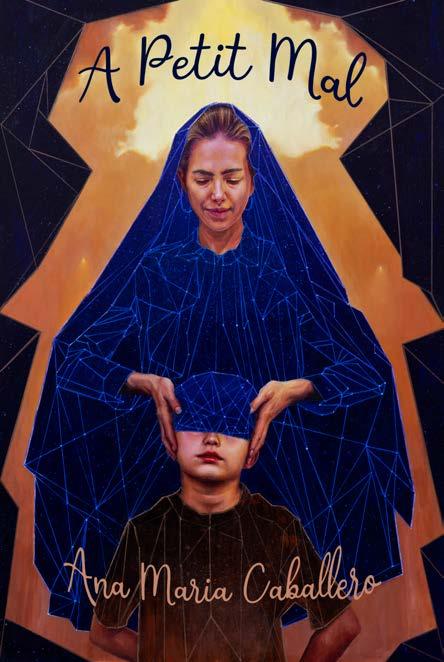
BLUE MOUNTAIN REVIEW september 2023
result of these months of furious writing is a work that takes multi-faceted stabs at the nature of emotions, of illness, of health, of faith, of loss. Stabs that elicit fresh meaning by mixing the muscle, the marrow, of words. A Petit Mal is very much a catharsis of the experience my family lived. I wrote itself into existence.

I believe our minds work in fragmentation. Our daily lives have become so heavily interrupted, too. We’re bombarded by information coming at us from different directions. Everything is image. Even on text-based apps like Twitter/X and news sites, image is what often summons the eye. I think readers relate to the fragment in an intuitive way. Readership has evolved.
As artists, we need not, nor should, cater to this, but I do believe that purposeful engagement with contemporary readers enhances their connection with narrative. The graphs I include, the pictures of my son and of the equipment used, and the screenshots of the little games he played on my phone while we went from treatment to treatment–all these visualized moments help construct the emotions of the story.
The way things write themselves within me is very rhyme-intensive. There’s a lot of internal rhythm to my prose. Meter and musicality are present. It’s something that I’ve recently allowed myself to embrace. I used to disregard my strange diction and try to dull it down, but now I lean into it. With this book, I went all out.
This is me, this is my style, my voice. This is what I’ve been working for so many years to find, this weirdness—my weirdness.
You are pretty popular in the NFT poetry movement. Tell us more about the work you are doing in that space.
I’m one of the co-founders of the digital poetry gallery theVERSEverse, which works very hard to onboard leading voices from the world of traditional publishing and pairs them with digital artists to create works that expand the boundaries of how we experience and exhibit poetry.
I also create my own digital poems and present them in thoughtful partnership with some of the world’s leading art institutions, providing context and relevance to digital verse that I hope will prove transformational for the genre and open doors for poets of generations to come.
The digital works created via theVERSEverse as well as the ones I create are rendered transactable via blockchain provenance. I believe that the ability to collect the work of a living poet in a way that reflects their contribution to culture will prove revolutionary to the craft, giving poets the power to potentially become selfsustaining artists.
What are you working
9
on next? Any preview you can give us regarding themes, form, or subject matter?
I’m working on a project that proposes a new form of literary translation, taking a seminal Spanish-language text and transposing it so that visual AI platforms might interpret it. I’m also generating images from English-language versions of the text. My aim is to explore the linguistic biases ingrained in large data models—how does AI “read” Spanish versus English? What about prose versus poetry? These are some of the questions my latest project seeks to explore.
What are you reading right now, and what poets (living or dead) most inspire you?
I’m rereading Julio Cortázar’s Hopscotch as well as Jorge Luis Borges’ The Book of Imaginary Beings (in their original Spanish versions) and reconnecting with these incredible works. I feel they are portals and am taking my time with their pages.
I’m very inspired by the poetic voice of Louise Glück, Sharon Olds, and Colombian poet María Mercedes Carranza, who I believe deserves so much more credit for her verse. I reread their work very often.
What does a perfect day look and feel like to you?
A perfect day is one spent offline and in nature with my husband and two children.
How do we keep up with you online?
I’m too often on the internet and in too many ways. Find me on Twitter/X @CaballeroAnaMa, on Instagram @ anamariacaballero and I regularly update my website anamariacaballero.com.
ABOUT Ana MaríA:
Ana María is a first-generation Colombian-American poet and artist. She’s the recipient of the Beverly International Prize, Colombia’s José Manuel Arango National Poetry Prize, the Steel Toe Books Poetry Prize, and a Sevens Foundation Grant. Her Pushcart Prize and Best of the Net-nominated work has been widely published and exhibited internationally, recently at Expanded Art in Berlin, bitforms gallery in New York, JustMAD in Madrid, Gazelli Art House in London, Galloire in Dubai, and L’Avant Galerie Vossen in Paris. Recognized as a Web3 poetry pioneer for her own work, she’s also one of the cofounders of theVERSEverse.
10 BLUE MOUNTAIN REVIEW september 2023
CARL PHILLIPS
by J.D. ISIP
Carl, thank you so much for taking a moment to chat with me. I know this whole Pulitzer business – congratulations, by the way! – has you inundated with interview requests, so I will try to make this one short and sweet.

You’ve said that you always felt a calling to teaching, even over poetry. One of the ways that Then the War seems to function is as a lesson for the country, or at least the reader. You’ve made a point of thinking about the assembly of a book (and you’ve assembled plenty); when you were composing the new poems and selecting previous works, what was the message or lesson you had in mind?
I didn’t have a particular lesson or message in mind – I did have a purpose in mind, though, which was to choose and arrange the selected poems in such a way that a reader new to my work would have a clear sense of how the work has evolved, how my thinking has evolved, across a handful of books.
And I think the only thing I’ve ever wanted to say is that we live in bodies, morality is constructed, bodies don’t easily conform to expectation, what does it mean to live honestly, instinctively, what does it mean to love in the same ways –which is to say, I have questions, mostly, and I think a life spent asking them (rather than insisting on answering them) is the most responsible way for me to live, to be human, and therefore flawed.
Building off the teaching theme, you teach poets how to be poets. Though I am sure the list changes semester to semester, could you please share five “classic” (dead) poets or collections you think will do any poet some good to know? And maybe five contemporary poets or collections?
11
an interview with
Of the dead:
● William Shakespeare’s Complete Sonnets
● C.P. Cavafy’s The Complete Poems
● Li Po’s Complete Poems
● Homer’s The Iliad
● Robert Hayden’s Collected Poems
Of the living:
● Jorie Graham’s The Dream of the Unified Field
● Frank Bidart’s In the Western Night
● Pamela Alexander’s Navigable Waterways
● Jennifer Chang’s Some Say the Lark
● Cedar Sigo’s Royals
I read an interview where they asked you how it felt to be notified about the Pulitzer. You say you couldn’t believe it, and then you say, “I walked my dog.” It was a fun answer, and it’s typical of you in interviews. You’ll talk deeply about the art of poetry, but you also seem to push against taking ourselves so seriously. Is that right? And, if so, what advice do you have for poets when we get a chance to read or talk about our work? What do you tell your students?
I knew you’d eventually ask a question that’s more than one question – this is three questions! [This is true!]
How I appear in interviews is simply how I am in real life. My poems wrestle with serious things, but my daily life involves plenty of non-serious things and/or ordinary things, like cooking, walking my dog, watching RuPaul’s Drag Race. I don’t
have advice, really, about how others should talk about their work. I guess I’d say just be yourself. Talk about your poems however you want to talk about them.
Thank you again, Carl! Please let our readers know how to get ahold of Then the War (or any of your other books) and how to follow you on social media.
You can find the books in the usual ways – go to a bookstore, or order it online. I’m @CPhillipsPoet on Twitter, @ pinestereo on Instagram, and my website is www.carlphillipspoet.com.
ABOUT Carl:
Carl Phillips recently won the 2023 Pulitzer Prize in Poetry for his collection, Then the War: And Selected Poems, 2007-2020. Then the War includes selections from many of his previous poetry collections (of which there are far too many to list here), and his lyric memoir, Among the Trees. Phillips is a Professor of English at Washington University in St. Louis.

12
let us tell yours.
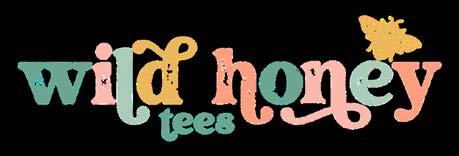
inspiring quotes.







vibrant colors.






bold patterns.
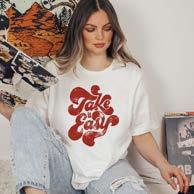

s h o p n o w a t w i l d h o n e y t e e s . c o m
e v e r y t e e t e l l s a s t o r y , wildhoneytees.com
https://www.ellijaymontessori.com
PLEASANT HILLS MONTESSORI

OFFERING A ONE-OF-A-KIND, PERSONALIZED EDUCATION FOR LEARNERS 3-12 YEARS OLD
PHMS offers a warm, supportive academic atmosphere, and sets a high level of expectation for the quality of thought, work, and mastery of content and skills.
Using an integrated thematic approach that ties the separate disciplines of the curriculum together into studies of the physical universe, the world of nature, and the human experience, PHMS consciously teaches students how to develop effective work habits and test-taking strategies.
Want to help fund a student’s top-notch education?
Did you know that the state of Georgia will give taxpayers a dollar-for-dollar tax credit when donating to Pay it Forward Scholarships and providing scholarship funds for schools like PHMS. Click the link below for more information and to request your Georgia tax credit today.

http://www.payitforwardscholarships.com/phms

14
LEARN MORE & DONATE
& Language
Mathematics
Geography
Science
Arts
Practical
Reading
·
·
·
·
·
Life Skills
an interview with
denton LOVING
by J.D. ISIP
Before we get to the specifics of Tamp, I want to say that it certainly feels like something special. It’s a collection I couldn’t put down. Themes of grief and loss are not unique, but how you handle them in this collection calls back to the storyteller poets, Levine, Komunyakaa, Hayden, or more contemporaries like Jack Bedell and Richard Blanco.
Could you share a little about how this collection came together? What goals or parameters, if any, did you have in building the collection? Since this is your second collection, were there lessons learned? Things you wanted to try or do differently with Tamp (compared to Crimes Against Birds)?
Thank you for such kind words about Tamp. As you said, the poems are mostly centered around my grief after my dad’s death. But quite a few of the poems explore the grief I was experiencing even before he died. He had suffered various health problems for twenty years. For that entire time, I was aware of how tentative his presence was. There are a few poems in my first collection, Crimes Against Birds, that explore this. One of the most obvious examples is the poem “Where I’ll Find My Dad after He Dies,” which imagines his version of heaven as his grandmother’s breakfast table. After my dad passed away, writing these poems was an important way to help me process my emotions. I never set out to write a collection about my dad or my grief. But at some point, I realized I was amassing enough poems to become a book.
The poems in Crimes Against Birds were my earliest forays into writing and understanding poetry. Those poems reflect me and my world, but the themes are more loosely connected than the poems in Tamp Tamp is also more elegiac, and perhaps it holds together in a different way for readers because of that elegiac tone.
Let’s start at the end of the collection with the piece, “The Topography of Tears.” The speaker recalls a collection of slides illustrating types of tears based on emotions, experiences. By the time the prose poem ends, he comes to the conclusion, “There’s little reliable science

15
about how emotional tears might alter from person to person or from one passion to another. But I like the idea that no single tear is like any other.”
I wanted to start here because I think it speaks to some of the work of the larger collection, an attempt to catalog loss at a distance. But just like in this piece, much of the collection features a voice continually pulled into emotion over objectivity. It’s so relatable. Does this ring true for you? Am I reading it right? When it comes to “The Topography of Tears,” what is the story behind the story there?
I love your phrase, “an attempt to catalog loss at a distance.” I think that perfectly encapsulates the pull and push of grieving. There are moments within our grief when we can be objective, and there are moments when we are profoundly lost in the depths of our pain. So often, it’s one step forward and two steps back. Acknowledging this difficult back-and-forth movement infused some necessary tension into the poems.
“The Topography of Tears,” is essentially an ekphrastic work. I was responding to Rose-Lynn Fisher’s mesmerizing art, which she refers to as “a visual investigation of tears.” I’m a very visual learner, and visual art is often a jumping off point for me. The concept as well as the physical representations of her slides fascinated me—to think that tears could be represented in visual, almost cartographic, means!
Another thing I wanted to do in Tamp was to explore ideas of mythology, both the myths that we are taught and those that we create. Some of these poems are an attempt to further mythologize my dad and our relationship. The idea in this prose poem that “no single tear is like any other” works within that thread. It’s a metaphor for saying that no loss, no grief, no pain is like any other, for saying that my loss is not like your loss, which is both true and not true.

16 BLUE MOUNTAIN REVIEW september 2023
Perhaps my favorite piece in Tamp is the poem “Remembered by Name.” I think it demonstrates some of the strengths throughout this collection—tenderness paired with brutality, gorgeous use of nature and place, a story quality that only adds to the lyrical cadence. I could go on!

This farm life is your world. How do you bring readers into that world? What work goes into finding language, descriptions and metaphors that transcend to those of us who have never, for example, named a cow or sent one off to die? These poems, though distant from my own life, seem so familiar. For your own work, what is the process?
Wow. It means so much that this poem speaks to you because it encompasses so much of the place where I live, and of my personal experience. That old saw about writing what you know has some truth to it, but I would add that it’s imperative to learn how to name what you know. In “Remembered by Name,” that can literally mean learning the names of the weeds and wildflowers that grow in the fields. But it also means finding the right ways to express emotions that are sometimes hard to name. In this poem, listing each cow with its own name is also a way of giving a name to a specific experience or memory.
There’s that other old piece of writing advice that says, “show, don’t tell,” but I once heard Michael Cunningham amend that advice to say, “show and tell.” And that makes more sense to me and to my sensibilities as a writer. Finding the right images to move the poem forward is hugely important, but relying solely on images often feels too abstract. Language, too, can’t do all of the work. In the end, it’s about finding the right balance so the poem has the greatest chance to resonate with others.
In poems like “There is a barn” and “Blue November,” you employ the trick of the sonnet, the volta, bringing the reader to a different lesson or idea than what you seemed to be building up to. There’s skill here but it doesn’t scream, “Look how clever I can be!”
17
What advice do you have for writers when it comes to construction and form? Or about borrowing from others and making it your own, as you do with “Genealogy?” Perhaps, more simply, I am asking, what do you think makes a person a good poet?
There are so many ways to be a good poet, just as there are so many different kinds of poems that are all good in their own ways.
Imitating successful poems, especially their structures and forms, has been a powerful learning tool for me. I try to always give credit where I’ve borrowed ideas—at least when I’m aware that I’m being influenced—as in my poem, “Genealogy,” which borrows a structure that was introduced to me in Major Jackson’s poem, “OK Cupid.” But again, imitating or riffing off someone else’s poem has so often been a way for me to gain insight into how a poem works. Deconstructing and reconstructing has taught me so much.
Reading widely is also crucial. I’m talking about all kinds of poems and also all kinds of writing. There have been lots of times that fiction or creative nonfiction has led me to an idea for a poem, and sometimes someone else’s poem has inspired me to write a short story or an essay. And this is where it can sometimes be difficult to know how we’ve been influenced by others. We should all strive to read so much that we absorb ideas, and then are able to pull them back up organically when we most need them.
I also want to acknowledge that although writing is so often a solitary experience, our work improves when we have good readers and editors. I’m so lucky to have a group of writers whom I can depend on to be brutally honest about my work. The poems in Tamp would be far weaker without the other writers who helped me see what was or was not working in draft after draft. I’m told that at every residency introduction at the Bennington Writing Seminars, Director Liam Rector would advise incoming students to “find those with whom you have rapport and proceed.” A good poet, or a good writer in any genre, requires finding people who understand your work but aren’t afraid to help you make it better. Maybe there are some writers who can truly do this work alone, but my work is always stronger when I allow others to help me.
Tamp is popular—soaring high on Amazon! Congratulations! If you had to guess, what do you think it is (or maybe what have you heard from others) that made thiscollection speak to such a wide audience? And how does it make you feel to have so many people embrace this work?
Perhaps Tamp has resonated with readers because the relationship we each have with our father is so foundational—even if the relationship is more negative than positive, even if the father figure is not biological, even if the father is absent. How we perceive or imagine our fathers helps inform the way we see ourselves regardless of our circumstances. Likewise, the loss of a parent—either parent—is a universal experience that I think resonates with readers.
I think back, too, to Eudora Welty who said, “One place understood helps us understand all places better.” It was always my hope that readers from Appalachia would respond to my work, but it’s been exciting to hear how readers outside of the region are connecting. A teacher in Washington State just told me about using some of my poems, including “Remembered by Name,” in her workshop with high school aged students who recognize their own rural lives within the pages of Tamp.
More than anything, I hope readers are finding resonance because they find the work to be emotionally honest. I hope.
Please let our readers know how they can get their hands on Tamp (and Crimes Against Birds). And please let them know what you are working on and where to follow you online.
Tamp is available at all the usual online locations including bookshop.org. It also can be ordered directly from Mercer University Press at mupress.org, or readers can ask their local bookstore to order a copy for them. Crimes Against Birds is still available from mainstreetragbookstore.com. After nine years, I’m still blessed that it continues to find its way into people’s hands. I’m working now to complete a third collection of poetry. I’m easy to find on social media sites such as Facebook, Twitter, Instagram, LinkedIn, Goodreads. Readers can also find more information at dentonloving.com, where I regularly share writing prompts, conversations about writing, and suggestions for where writers can submit their own
18 BLUE MOUNTAIN REVIEW september 2023
REMEMBERED BY NAME
for Lee Smith
Chocolate: half Jersey, half Angus, the color of milk mixed with magic. She was the first calf my dad agreed was solely mine, a lesson in responsibility. We bottle fed her, raised her as a pet. For seventeen years, she scurried from far pastures whenever I called. The spring after she died, I propped her sun-bleached skull on a rock wall overlooking our home in the hollow.
Abby: Chocolate’s daughter. Allergic to weeds— thistledown, sweet Joe Pye, ironweed— we could hear her wheeze before we picked out her sleek black back between those of her sisters. Sold before winter for the exact amount of four new car tires, one of Dad’s hard lessons.
Eros: a mother in troubled childbirth, heaving, too tired to scare away. My dad tied a noose around the calf’s tiny, protruding hooves. Midwifery is easier when the mother stands still, but when my dad pulled, Eros stormed. Mom and I grabbed rope, and Eros drug three of us across our eighty acres until Dad pinned a foot against a fence post, held us until her calf plopped to the ground, gained breath.
Baby: a dirty yellow Jersey, she looked like nothing more than loosely connected bones. She never learned to wean any of her calves, so sometimes, we found two or more daughters drinking all at once. My dad never saw her without wishing his Grandma Susie Baker was alive so he could give her a cow with so much milk.
Ellie: solidly, innocently white, whose lifeless body I twice chased buzzards away from. I nursed her with milk in a Ziplock bag, taught her to walk, forced first steps until she was strong enough to walk alone. She became my own child, and she loved me more than her mother, at least for one single day of our lives.
Henry Beauclerk: the gentle red giant, sire of many calves. Even my dad regretfully agreed Henry looked sad when loaded on the trailer to be sold at market. Many believe bulls are brutes, dumb and dangerous, but Henry’s eyes were soft and wet, as if he knew he would never come home again.
About DENTON:
Denton Loving lives on a farm near the historic Cumberland Gap where Tennessee, Kentucky, and Virginia come together. He is the author of the poetry collections Crimes Against Birds (Main Street Rag, 2014) and, his newest project, which we discuss in this interview, Tamp (Mercer Press, 2023). His poetry, fiction, essays, and reviews have been widely published in journals including River Styx, CutBank, and Iron Horse Literary Review
19
Latin-American
O V E R V I E W
Entrants must identify as a writer of Latinx, Hispanic and/or Latina/o descent Former students and close friends of the judges are not eligible


The entry fee is $25
No more than 20 pages of poetry A page of acknowledgements and dedication is counted in the 20 pages
Please note in acknowledgements any previously published poems
The contest is blind Please put your name and contact information in the cover letter, but nowhere on or in the manuscript
W I N N E R S
$300: 1st place and 25 copies
$200: 2nd place
$100: 3rd place
All place-winners will be interviewed in the Blue Mountain Review and on the NPR show, Dante’s Old South

Submission deadline is January 31, 2024
Winner and honorable mention announcements to be made on February 29, 2024

S e l e c t e d b y P r e s i d e n t O b a m a a s t h e f i f t h i n a u g u r a l p o e t i n U S h i s t o r y , R i c h a r d B l a n c o i s t h e f i r s t L a t i n o , i m m i g r a n t , a n d g a y p e r s o n t o s e r v e i n s u c h a r o l e B o r n i n M a d r i d t o C u b a n e x i l e p a r e n t s a n d r a i s e d i n M i a m i , t h e n e g o t i a t i o n o f c u l t u r a l i d e n t i t y c h a r a c t e r i z e s h i s f i v e c o l l e c t i o n s o f p o e t r y B l a n c o h a s w r i t t e n o c c a s i o n a l p o e m s f o r t h e r e - o p e n i n g o f t h e U S E m b a s s y i n C u b a , F r e e d o m t o M a r r y , t h e T e c h A w a r d s o f S i l i c o n V a l l e y , a n d t h e B o s t o n S t r o n g b e n e f i t c o n c e r t f o l l o w i n g t h e B o s t o n M a r a t h o n b o m b i n g s H e i s a W o o d r o w W i l s o n F e l l o w a n d h a s r e c e i v e d n u m e r o u s h o n o r a r y d o c t o r a t e s H e h a s t a u g h t a t G e o r g e t o w n U n i v e r s i t y A m e r i c a n U n i v e r s i t y a n d W e s l e y a n U n i v e r s i t y H e s e r v e s a s t h e f i r s t E d u c a t i o n A m b a s s a d o r f o r T h e A c a d e m y o f A m e r i c a n P o e t s
C a r i d a d M o r o - G r o n l i e r i s t h e a u t h o r o f T o r t i l l e r a ( T R P 2 0 2 1 ) , w i n n e r o f T h e T R P S o u t h e r n P o e t r y B r e a k t h r o u g h S e r i e s : F l o r i d a T h e 2 0 2 2 E r i c H o f f e r B o o k A w a r d H o n o r a b l e M e n t i o n 2 0 2 2 F i r s t H o r i z o n A w a r d F i n a l i s t a n d 2 0 2 2 I n t e r n a t i o n a l L a t i n o B o o k A w a r d H o n o r a b l e M e n t i o n , a s w e l l a s t h e c h a p b o o k V i s i o n w a r e ( F i n i s h i n g L i n e P r e s s 2 0 0 9 ) S h e i s a C o n t r i b u t i n g E d i t o r f o r G r a b b e d :
P o e t s a n d W r i t e r s R e s p o n d t o S e x u a l A s s a u l t ( B e a c o n P r e s s , 2 0 2 0 ) a n d A s s o c i a t e E d i t o r f o r S W W I M E v e r y D a y a n o n l i n e d a i l y p o e t r y j o u r n a l f o r w o m e n i d e n t i f y i n g p o e t s H e r r e c e n t w o r k c a n b e f o u n d a t A m e r i c a ’ s B e s t P o e t r y B l o g
S h e r e s i d e s i n M i a m i , F l o r i d a w i t h h e r f a m i l y
https://bluemountainreview.submittable.com/submit
20
P O E T R Y C H A P B O O K C O N T E S T
J U D G E : R I C H A R D B L A N C O J U D G E : C A R I D A D M O R O - G R O N L I E R
the Southern Collective Experience presents
SUBMIT YOUR WORK AT BLUEMOUNTAINREVIEW.SUBMITTABLE.COM
J.BRUCE FULLER
OF THE TEXAS REVIEW PRESS
by CLIFFORD BROOKS
How does Texas Review Press stand out? What magic did you bring when you took the wheel?
No magic, just a focus on data, and optimizing what TRP had already built over the last 40+ years. And a lot of hard work by a lot of people.
TRP is a university press, but we primarily publish literary fiction and poetry. This gives us the chance to publish great literary work and have the support of a university behind us as well as international distribution. I inherited a wonderful list of poets when I arrived and have had the opportunity to sign and work with many poets I have admired over the years. We are determined to build a diverse list of books by the best poets and writers in America.
How do you balance your own writing with your work as editor and publisher? Do the two conflate at all?

Directing the press takes a lot of time, and I don’t have as many chances to write as maybe I would like. I also have two teenagers at home still, with their own work and school schedules, so time to write in general is hard to come by these days. Like everybody else, I need to prioritize my own writing and make time for it, which is of course easier said than done.
The two conflate in some ways, I suppose. I have a book of poems coming out in Spring 2024 with LSU Press, How to Drown a Boy, and going through that process has definitely been easier since I have been working in publishing. Particularly in terms of pre-production and marketing. I do these kinds of tasks all the time with my own authors, and so I now know much more about those processes than when I first started publishing my own work. I’m not sure many of us poets are trained as well as we could be for the business side of things after we graduate. Knowing which parts of the process my authors have struggled with has prepared me for those same troubles.
What are you reading?
I’m usually reading a variety of things, lately a lot of economics and paleontology books, and lots of paleo-archaeology,
21
an
interview with
particularly about Neanderthals. I suppose I read poetry and literary fiction for a job, so reading nonfiction books in fields I’m not an expert in is a reaction to that. I still read poetry and literature for pleasure sometimes.
One major change to my reading habits in the past few years is that I have stopped buying print books and now only read eBook versions. That’s sacrilege for some, and a bit strange for a publisher to say, but the convenience makes it easier to instantly get a book I want, and I no longer have to store books. I read more often when I can read on my phone.
What does your press look for in a quality submission?
We receive several thousand book submissions per year, so I’ve started to see patterns in the layout of book manuscripts, things like similar section arrangements, similar movements throughout the collection, similar rhetorical patterns. So I find myself looking for books that “know” what they are, books that have a sense of logic and completion. I’m not sure if that is helpful or not. The poems have to be good, sure, but when you can only pick a couple of books out of a thousand you end up with more good work than you can publish. So I look for those books that feel complete as a unit, especially the ones with arcs and subjects that present themselves early and are sustained throughout the manuscript.
I am not looking for any one particular style of poetry, in fact, I think it is a great strength to have diversity and variety in your list. I want to find those voices that have a strong sense of themselves and have something important to say. I want to bring those books into the larger conversation of contemporary poetry.
How do we keep up with you online?
www.Texasreviewpress.org has links to our Submittable page, all of our contests, calls for submissions, and series info. We’re on Facebook, and you can find us on Instagram and Threads at @texasreviewpress. We also have a blog that lists announcements and news at www.texasreviewpress.wordpress.com/

About J.BRUCE:
J. Bruce Fuller is the author of How to Drown a Boy (LSU Press, 2024). He is the author of five chapbooks including The Dissenter’s Ground, Lancelot, and Flood, and his poems have appeared at The Southern Review, McNeese Review, Birmingham Poetry Review, and Best New Poets 2022, among others. He has received scholarships from Bread Loaf, the Sewanee Writers’ Conference, and Stanford University, where he was a Wallace Stegner Fellow. He teaches at Sam Houston State University where he is Director of Texas Review Press.
22 BLUE MOUNTAIN REVIEW september 2023
an interview with
DR. JAMES FINLEY
by CARMEN ACEVEDO BUTCHER
What about your developmental years created you as a writer?
When I was 14 years old, I was going to this Catholic high school, and for the first time they talked about monasteries and mentioned Thomas Merton. I hadn’t heard of either before. I went to the school library after classes and found they had one book by him, The Sign of Jonas, the journal he kept as a monk. On the first page, he says of himself, “I have but one desire, the desire for solitude to disappear into God’s face.” That spoke to me. So I got my own copy and I read it over and over. I was touched by how writing that comes from a very deep, pure experiential place can access you.
After high school I went to the monastery, living as a member of the community for almost six years. As my spiritual director, Merton led me to the teachings of the mystics like 16th-century John of the Cross. I was moved by his clarity of putting words to interior transformations like the dark night of the soul. Merton introduced me to Buddhist scriptures too, I studied medieval philosophy, and I began keeping journals. I still write five to six hours a day. It puts me into a meditative state. Going into that state to find words that might help people on their own journey is very meaningful to me.
I’m thrilled that your new book is out from Orbis. Can you tell us about The Healing Path: A Memoir and an Invitation? What do you want readers to take away from it?
I began to write The Healing Path almost three years ago as I was sitting next to my wife, Maureen, as she was dying, in house hospice. I found that immensely sorrowful moments were also interwoven with sunsets that I could see out the window and that she and I had watched together for over 30 years. I found myself weaving these patterns together.
After she died, I was really impacted by the depth of the loss. As I found my way out of it, as months went by, I reintegrated that loss into the spiritual path itself. I asked myself, “Well, how did I get this way?” How did it come to pass that at 80 I was able to see things like this? So in the memoir, I go back to my first traumas at age three and how these got worse through high school, and the spiritual awakenings that sustained me as I went through that.
I also weave in the impact of my monastery years and my 30 years as a clinical psychologist working with trauma survivors who want their spirituality to be a resource in their therapy. Sitting with them, I was aware of the endlessly varied patterns of the places where the intensity of the suffering can close off experiential access not just to the divine but to yourself, but that what’s also true is that it can open up, the light can shine through the darkness itself in a transformative way.

23
So my teaching memoir offers practical metaphors, examples, and brief practices to help the reader get in touch with that place within themselves.

You refer to “moments of spontaneous spiritual experience” in your teaching and writing. What do you mean by that?
Merton puts it this way in New Seeds of Contemplation: “From time to time we’re blessed with an inner quickening, a certain sense of the sacredness of life.” He talks about being out walking alone in the midst of nature and you turn to see a flock of birds descending, and as if out of the corner of your eye, you catch something in their descent that’s primordial, vast and true. Sometimes it’s in the presence of nature. Sometimes it’s in the arms of the beloved. Or reading a small child a goodnight story. Sometimes it’s as simple as a quiet hour at day’s end. Or it’s in the midst of giving yourself over to a community of people, addressing a need, and you’re moved by your love for those people. Sometimes it’s lying awake in the middle of the night in the dark listening to your breathing. These moments can be very intense, but usually they’re very, very delicate. They tend to be fleeting and subtle, and when they pass, sometimes we just go back to our life. But there can grow within us this longing to abide in these moments of quickening. That’s the path.

As a clinical psychologist who has helped countless people who seek healing from trauma, where does hope arise for you in therapy sessions?
When we risk sharing what hurts the most in the presence of someone who will not invade us or abandon us, we can learn not to invade or abandon ourselves. Also sometimes you can get the feeling you’re in the presence of someone who sees in you a value you’re not able to see. We begin by having faith in their faith in us. Eventually it arcs over and grows within us. We can be
re-parented in love and find our way.
In that very process, we can begin living in an underlying habitual sensitivity to the divine generosity that’s welling up and giving itself to us in every breath and heartbeat. It alone is ultimately real like this, but we’re exiled from it. The healing process can heal the exile, leading to the deepening of spirituality. This process beckons us to circle back and be present on this earth as a healing presence in an all too often traumatized and traumatizing world.
How do we keep up with you online, and what projects and programs are you working on that we should be aware of?
If you Google “Turning to the Mystics James Finley,” the podcast I do with Kirsten Oates, it offers in-depth poetic experiential teachings on the mystics down through the ages and how we can apply those insights to our daily life. You can also visit the Center for Action and Contemplation at www.cac.org, where you’ll find audios and videos that I did with Richard Rohr, plus online courses, and at Sounds True you’ll find audio sets too.
About James:
James Finley, PhD, lived as a monk for nearly six years at the Trappist monastery of the Abbey of Gethsemani in Kentucky where Thomas Merton was his spiritual director. A Core Teacher at the Center for Action and Contemplation and a retired clinical psychologist, he hosts a weekly podcast Turning to the Mystics, is author of Merton’s Palace of Nowhere: An Ultimate Identity Beyond Ego, and recently released with Orbis an acclaimed teaching memoir The Healing Path.










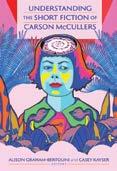
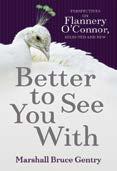

26 BLUE MOUNTAIN REVIEW september 2023 www.mupress.org Use coupon code MUPNEWS online for 20% discount off your entire order or call 866-895-1472 toll-free —Shipping charges will apply— www.mupress.org
an interview with jesse lee kercheval
by j.d. isip
I Wantto TellYouis your sixth poetry collection, an accomplishment by itself—but you have also written novels, short story collections, a memoir, and translated a long list of Spanish language poets. That’s just what I remember off the top of my head! Before we dive into this wonderful collection, I wonder if you could tell our readers about how your “drive” to write has changed over the years.
In other words, yours is the kind of writing career many only dream about. Many drop out of the publishing world because of the competition, the stress, the sometimes-minimal returns after years of work. What has kept you going? How have you been able to “stay in the conversation” in such a vibrant and meaningful way?
I think the secret is the variety—at least for me. When I am frustrated or bored, I can work on something else. When I went to the Iowa Writers Workshop in 1984, the divisions between genres were so strong it was as if poets entered through one door, fiction writers through another and mixing was forbidden. Nonfiction was—and is still—a completely different program. I was admitted as a fiction writer, but I begged my way into a workshop with the amazing poet Gerald Stern by actually rolling around on the floor outside his office tearing at my clothes and saying I could not believe I was not allowed to take a poetry workshop. Not something I would ordinarily do! But Gerry loved drama and let me in. It was the best workshop experience I had in my MFA.
So, I learned early not to pay too much attention to the idea we should live our creative lives in little boxes. I always want to challenge myself, do something that scares me. I felt that way when I moved from writing short stories and onto my first novel, The Museum of Happiness, which seemed like learning to write all over again. I was scared again when I wrote my first poetry collection World as Dictionary. Absolutely petrified when I wrote Space, my memoir. My first novel, The Museum of Happiness, is set in Paris in 1929—so, not autobiographical. Writing my memoir was when I really understood why my students were always so protective of their very autobiographic stories. Ten years ago, in my fifties, I

27
learned Spanish and began translating Uruguayan poetry. In the last few years, I have turned to writing essays, a type of nonfiction I had not done before and one that seemed very intimidating. In an even bigger change, I began drawing for the first time in my life when I was locked down in Montevideo, Uruguay, during the first months of the pandemic. I have gone on to combine those last two—publishing various essays illustrated with my art in the Los Angeles Review, New Letters, the Superstition Review, the New Ohio Review, On the Seawall, and other journals. I’m pushing the art further, doing comics and graphic narratives with only a few words that have been published in places like Anmly, Booth, Gargoyle, and Heavy Feather Review. I even got to take a class with Lynda Barry, the Queen of Comics, a life-changing experience. Lynda does not believe in boundaries at all. She would tell you words are drawing and drawing is language.
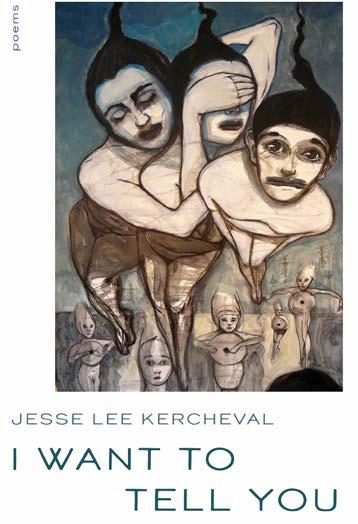
Each of these modes of expression brought its own challenges—learning the form, where and how to publish the work— but each also brought me into a new community. It’s wonderful to have friends in all these different worlds. I still work in all these forms—in turns. So, I am never short of projects.
This does not protect me from the frustrations you mention—the competition, the stress, the minimal returns. Those are real, and I have my dark days and fits of frustration. But it helps that the work is always there, in one form or other, waiting for me. The work is the reward. Everything else is in the hands of fate, or of editors or readers. At least it’s not in my hands. But the work is.
The eponymous poem of the collection, has this terrific phrase “zing/of cosmic meaning at the end.” You are talking about the writing process, specifically about getting to the end of a line, but it feels bigger. Shining over this largely elegiac collection, you seem to be pointing yourself and your readers toward a terrifying question about life and meaning. Is that accurate? You “want to tell” us
what, exactly?
Here is the point where it becomes clear I find it easier to talk about my writing life than my actual writing, especially my poetry. I Want To Tell You is an exploration of the meaning of life. Why do we suffer? How do we face grief? I imagine the book as a journey that takes you through life. Then, in the last few poems, I hope the reader reaches a quiet place, a place where we recognize and value what we have in the world. It’s an emotional, even a philosophical journey. It’s not a COVID collection, there are no poems
BLUE MOUNTAIN REVIEW september 2023
about Covid in it, but I was putting it together during the height of the pandemic and that made me braver in my writing and my selection. In the past I might have thought that I shouldn’t have so many poems about death in a book. In this one, I thought, “Well, that’s what happens. The longer you live, the more people you know are dead.” During the pandemic, people were dying all around us and we were all asking questions about life’s meaning.
One of the real joys of reading these poems is your cutting wit. I am thinking of lines like “My mother going thru a litany/of dead pets” (from “Blessing”) and in “Ice” the husband asks if there is room to store this metaphorical pie. I found myself chuckling because you continually subvert the maudlin by emphasizing how strangely the real world seems to work. Is this intentional? Maybe in all of your writing, but specifically in this collection, are you honing a tone or voice for a specific purpose?
It’s a reflection of me, in my life and in all my writing. Some readers (and editors) love that. Some object strenuously. If someone criticizes my writing, they’ll say, “I don’t think humor is appropriate in this situation.” But to me, tragedy and comedy go together, or at least ironic humor and observation. In this collection the humor is particularly necessary because of the themes I’ve already talked about but also because of the intensity of the voice. This is a very voice-driven book. I felt it was a time in the world when I could and should speak directly. As in: I Want To Tell You and I need you to listen.
One of my favorite poems in this collection is “Poem to Forget.” It’s that kind of “ceremonial” poem you can imagine folks putting in cards to loved ones at graduations and funerals. You say, “give up this pain/for which there was never a good name anyhow.” Can you share a little about what inspired this poem? Maybe how it works with other themes and ideas in the collection?
That poem was inspired by the poetry of Robert Desnos, one of my favorite French surrealist poets (and I love all the French surrealist poets). He loved a mad list! I wanted a poem that was more in the body, more in the world, full of the flotsam and jetsam of love and life. That poem marks a turn in the book, from mourning to the prickly daily considerations of life. The later poem “A House is Never Empty” is another one in that vein. The book begins to be interspersed with moments of joy as in the poem “Say the word, bliss.”
29
You write about the power of loss and grief to change our perspective, the very way we take in the world around us. Specifically, I am thinking of “House of Sleep” and “[Today, Alone].”
The more we age, the more people we lose, and the more people we lose, the lonelier we get. The surgeon general has just declared a loneliness epidemic. This collection seems to dig deep into loneliness. Would you agree? How can our work as writers help… if at all?
The older we become, the more our waking life fills with the clatter of other moments in time. I feel very connected to the people I have lost to death and to the changes of circumstance, people I no longer see regularly even if they are very much still alive. In some ways that means I am never lonely. In others, that I am always longing for someone who is not there. But if my poems say anything, it is that living in all moments at once is a richness, a blessing.
The loneliness of life in general (with or without a pandemic) and of the writing life (all those hours alone with words) is why writers (or at least this one) love writing groups, conferences, readings. We work alone on the page, but we do not always want to be alone. I am a particularly social writer and belong to a crazy number of poetry, comics, and nonfiction groups. I love to get together with other writers. I am probably on the far end of this since my happy spot is the Book Fair at the Associated Writing Programs annual conference surrounded by ten to twenty thousand other writers. I know an astonishing number of them, and I am always ready to hug.
Please let our readers know how they can get their hands on I Wantto TellYou (and any of your other works). And please let them know what you are working on and where to follow you online.
I am very lucky because all my books are currently in print and available to order at your local bookstore or any of the online retailers. Information about the books and their publishers are on my website www.jlkercheval.com
You can follow me on Twitter (@JesseLKercheval) or Instagram (@jlkerche).
I am working on many projects: a graphic memoir, a collection of essays, and translations of two books of poetry. I’m finishing a collection of fifty-two prose poems, Tattoo Alphabet, with one-word titles written in alphabetical order, A to Z then Z to A. Some have appeared already in Blackbird, the Gettysburg Review, Arts & Letters, Shenandoah, and other magazines. Should be enough to keep me busy.
About Jesse LEE:
Jesse Lee Kercheval is a writer, poet and translator. Her latest book is the poetry collection, I Want to Tell You (University of Pittsburgh Press, 2023). Her memoir, Space, was the winner of the Alex Award from the American Library Association. Her translations include The Invisible Bridge: Selected Poems of Circe Maia and Love Poems by Idea Vilariño. She is the Zona Gale Professor Emerita of English at the University of Wisconsin-Madison and the editor of the Wisconsin Poetry Series at the University of Wisconsin Press.
Jared Beloff is the author of WHO WILL CRADLE YOUR HEAD (ELJ Editions, 2023). He is the editor of the Marvel-inspired poetry anthology, Marvelous Verses (Daily Drunk, 2021), and has been a peer-reviewer for Whale Road Review since 2021. His work can be found at Night Heron Barks, Barren Magazine, River Mouth Review, The Shore, Contrary Magazine and elsewhere. He lives and teaches high school English in Queens, New York, with his wife and their two daughters.
30 BLUE MOUNTAIN REVIEW september 2023
an interview with
KAYA OAKES
BY CARMEN ACEVEDO BUTCHER
Since 1999, you’ve been a faculty member in the College Writing Programs at UC Berkeley, where you teach creative nonfiction, composition, and research writing, and you’re also a highly respected journalist as well as a social media influencer on Twitter @kayaoakes. What is it about your developmental years that created you as a writer, and what do you most hope your students take away from your courses on writing?
My parents both worked in education, so I grew up around a lot of books. As a young adult I was desperate to be anything other than a writer, because while I was good at it, I also knew writer’s lives were really hard. I tried music, theater, and painting, and was mediocre at all of them. Then I learned that musicians, actors, and painters also have really hard lives. Who knew? So I accepted that life was going to be hard no matter what path I followed, and got back on the one that made me feel the most like myself, which continues to be that of a writer and teacher of writing.
The most important things I learned as a student of writing were all about agency – that I had a voice, and that it mattered, if only to the person reading an essay. My hope is that students can come out of any writing class, even the most introductory one, and feel at least some sense of empowerment, even if they don’t feel called to be writers.

What draws you to creative nonfiction versus fiction or poetry?
My MFA is actually in poetry, but as my grad school years went on, I found myself drawn to more narrative forms of writing, starting with prose poems and then into longform essays. Around this time I also started reading James Baldwin, Richard Rodriguez, Audre Lorde, Joan Didion and other nonfiction writers whose work seemed to speak to me in a way that poetry sometimes didn’t. Poetry led me to pay closer attention to language, but nonfiction allowed me to be more expansive and to write about things that feel urgent or high stakes.
And I’m not a person who has the kind of imagination required for fiction – to me, truth is the most interesting thing we encounter, real people are endlessly fascinating, and the world has problems that I can wrap my head around best in nonfiction.
31
I’m very excited that your new book on the limits of forgiveness is coming out soon from Broadleaf. Can you tell us about The Limits of Forgiveness? What do you want readers to take away from it?
Hopefully, readers will understand that forgiveness is not a linear process, nor is it necessarily the best outcome in many situations of abuse, colonialism, or historical conquest. Forgiveness that is coerced or forced can itself become a form of abuse. Forgiveness is a beautiful idea, but demanding universal forgiveness can also hold people emotionally hostage.

Why is being a Californian such an important part of your work?
America has always been a divided country, and unlike the east coast or the south, Californians are sometimes seen as lacking in a literary culture (the midwest, according to friends there, is also thought of as lacking this). But the truth is that while we don’t have a literary culture, we have literary cultures
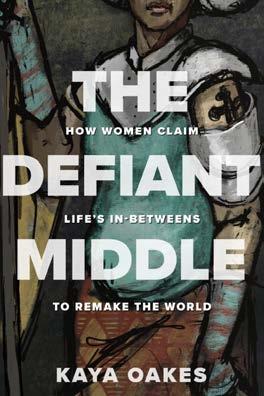
California contains multitudes. From the Bay Area you can drive two hours and be in the desert, the mountains, the central valley, and of course there’s the ocean, and on top of this the ethnic and cultural diversity here means there is room for so many kinds of writing that California literature is constantly changing and evolving.
I like that restlessness and reinvention. And it’s the place where I was born, so I’m imprinted by it.
How do we keep up with you online, and what projects are you working on or are coming up for you that we should be aware of?
I suppose I’m around for whatever future Twitter holds at the moment, and can sporadically be found on Instagram @kayaoakeswrites and at my Substack newsletter (my website is https://www.oakestown.org). I write a quarterly column for The Revealer, a publication of NYU’s Center for Religion and Media, and I’m a contributing writer at America Magazine, as well as an occasional writer for Commonweal, Sojourners, and a few other places.
In between those things teaching, hiking, and spending time with people I care about are priorities, but so is getting enough rest, or at least trying to.
BLUE MOUNTAIN REVIEW september 2023
About KAYA:
Oakes is the author of five books, most recently including The Defiant Middle. Her sixth book, The Limits of Forgiveness, is forthcoming in 2024. She teaches writing at UC Berkeley.
Are you, or someone you know on the spectrum?
Do you constantly feel out of place due to Autism? Did a late-in-life diagnosis give you some peace of mind, but leave many more unanswered questions?
Adulting with Autism
Lectures and Mentorship on How to Thrive on the Spectrum
https://teachable.sjv.io/c/3209676/1547114/12646


- About Your Instructor -
Clifford Brooks is founder of the Southern Collective Experience and Editor-in-Chief of The Blue Mountain Review. Aside from his business ventures he is also a poet. To date Clifford has two full-length collections of poetry, The Draw of Broken Eyes & Whirling

Metaphysics and Athena Departs: Gospel of a Man

Apart, Exiles of Eden is a limited edition chapbook available solely from its author. Over the last twenty years Clifford traversed the traditional route in publishing and learned how to create, sell, and market creative writing. Throughout his tenure as writer and educator, Clifford stands as an advocate for those on the autism spectrum. As board member of Autism Speaks, he is intimately aware of the need for greater community and understanding.
Here on Teachable, Clifford shares his wisdom on living the creative life and adulting with autism.
Educated Compassionate Honest Learn coping Techniques Get Inspiration Gain Confidence Learn More & Enroll Here
BLUE MOUNTAIN REVIEW september 2023 Green Writers Press , a small, Vermont-based publishing company, is dedicated to spreading environmental awareness and social justice by publishing authors who proliferate messages of hope and renewal through place-based writing and environmental activism. In the past five years, Green Writers Press has expanded significantly, publishing such authors as Julia Alvarez, Chard deNiord, John Elder, and Clarence Major. Read more at www.greenwriterspress.com


If you’d like to buy any of the books listed here, just contact your local, independent bookstore. We are located in Brattleboro, Vermont |


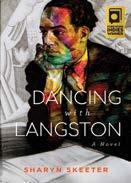




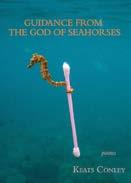


34
p poetry p literary magazine Whole Terrain p nonfiction p fiction p ya
media@greenwriterspress.com
802.380.1121 giving voice to writers & artists who will make the world a better place Distributed by IPG/Chicago green writers press } https://bookshop.org/shop/greenwriterspress [ literary collections } [ new poetry } [ new fiction } [ new nonfiction }
|
an interview with KENDEL HIPPOLYTE
by LYNNE KEMEN
Welcome! I had the great pleasure of hearing you read at Bright Hill Press’s Word Thursdays last spring. How did you begin with poetry?
I was always drawn to the sound of poetry. I was reading my older brother’s poetry books when I was seven. This is late ‘50s, early ‘60s and St Lucia is still very much a colonial territory. Poetry was very much written in set forms, in quatrains that had very, very set patterns of rhythm and rhyme. You can say them out loud and bounce along with them and jig to them and everything; they were fun in that kind of way. They connected very directly with traditional nursery rhymes. When I think back on the oral tradition in St. Lucia, I think a lot of us in our childhood just so easily made up chants. Even nicknames for people sometimes might have a little phrase attached to it, and you’d see that on a jig and a jog. And poetry for me fell into that very easily. I was reading all this stuff and reading it out loud. I never came into poetry as something you just read on the page. I read it out loud and bounced with it.
My eldest brother was in a theatre arts group called the St. Lucia Arts Guild that had been formed by the Walcott brothers, Derek and his twin brother Roddy, Roderick. I would be helping my brother learn lines for his plays. I was probably about nine and read plays like Strindberg’s Miss Julie, Shakespeare’s Measure for Measure. I could stand at the back of the hall and watch these rehearsals.
What about your own writing?
I started writing stuff probably in my teens. I’ve always kept a journal. Some of them I’ve lost, some are still around. I learned early in your journal you must never lie. And at that time, I was also a part-time librarian at the University of the West Indies Extramural Department. They had a small but very, very important library of Caribbean work that you couldn’t get anywhere else in Saint Lucia
Let’s talk about your relationship with Peepal Tree Press
Jeremy Poynting and Kwame Dawes saw me perform at a Festival in England . So Poynting wrote to me and asked would I consider doing a book with them? I love the bravery of what Jeremy set out to do and that he stuck to his guns no matter what. He gave Caribbean literature a presence on its own terms, with his own

35
taste in Caribbean literature. And the fact that he had someone like Kwame as a poetry editor with him. He also had other people around it who could keep it grounded, keep the vision grounded, and be in touch with the newest stuff happening. So I’m in wonderful company with Peepal Tree Press.

You are a poet and a playwright. Can you talk about your process with each?
Yeah, yeah. I love the work involved in creating poetry. I love the challenge. And that’s one reason I also like working in traditional forms, even though I’ll bend them. But traditional forms– I’ve done villanelles, and it’s a form I really enjoy working in because it really constrains me.
You put yourself in a box, and then you must figure out how to get out of it.
Exactly! Whether it’s traditional forms or so-called modern forms. Or you invent forms. Like T.S. Eliot said, free verse is not free. No verse is free. The poem has to be unified in some way, and you’ve got to work, you’ve got to discover or invent the principles of unity in the poem. What holds it together, and how does repetition occur? How are the links made across the poem, across the lines, if you’re not using traditional rhythm, traditional rhymes, et cetera? And I love those challenges.
I find writing plays by and large more of a task. Because you see, you can write a poem, if it works out that way, over a period of years. You can have fragments of it and go back into it a year, two years later. And once you’re in that zone, that frame of mind, you’re there, and you reconnect. For me, a play can’t sit that long in pieces. So when I’m working on plays, as my wife will tell you, I’m not nice to be around. I’m miserable. Yeah, I’m miserable. I have to put myself away somewhere to write. Because you’re seeing people in your head, you’re hearing them talking, you’re picturing them in rooms, all sorts of things that would be classified in psychiatric labels. If you didn’t have the fancy label “writer,” they would put you away somewhere. (laughter)
Thank you so much for talking with me.
I look forward to more conversations.
Before you go, where can we find you on social media?
I am on Facebook.
About KENDEL:
His poetry ranges across the continuum of language from Standard English to the varieties of Caribbean English. He has published seven books of poetry, the latest being Wordplanting (Peepal Tree Press, 2019) and his poetry has appeared in regional and international journals and anthologies. He has taught poetry workshops in the Caribbean and the UK. He has performed his work internationally at events such as the Medellin Poetry Festival and Havana Book Fair. He has been the recipient of a James Michener Fellowship to study poetry and an OAS scholarship to study theatre. He is the winner of the Poetry Prize in the Bocas Literary Festival, 2013.
36 BLUE MOUNTAIN REVIEW september 2023
LUKE JOHNSON
by LYNNE KEMEN
Welcome, Luke Johnson. I’m so excited to sit and talk with you today. Your book of poetry, Quiver, is coming out this fall. It is wonderful and dark writing.
Quiver, for me, is an exorcism. It’s me confronting many realities, not only in what was central in my life but in generations before mine. I come from a long line of fatherlessness and addiction, from men who die young or end up in prison.
I was the first in my lineage to break that ugly tradition. So, for me, to write the work I want to write and then also write the next book, I had to first confront the realities of my inner life. I’m a firm believer that brutality and beauty and/or sorrow and joy are sisters. They’re two sides of the same coin. Quiver reveals those polarities exist inside all of us.
Tell us about your job working with people struggling with addiction.
I work with men who struggle with addiction. My role is a dozen hats in one. I’m the program manager of the Central Coast Rescue Mission. Sobriety is simply not using. It doesn’t signify life change behaviorally, mentally, emotionally or externally. Recovery is realizing sobriety is just the first step and that the hard work is entirely recalibrating one’s life holistically and behaviorally. At CCRM, we are a 10-month recovery program that offers our gentleman a place to stay. All their needs are met for free. Because of that, it’s a real opportunity for them to get healthy physically, emotionally, mentally, and spiritually while receiving opportunities to learn new trades, go to school, and empower their futures financially. The staff here serve these men. We are the bridge that reconnects them to themselves, family, children, spouses, and the larger community.

What about the way you write?
When I was a little boy, I could hear the natural rhythms of rain and sleeted tires. I could hear the music anywhere. I had this keen sense of sound, syncopation and syllabics.
In college I fell in love with William Carlos Williams. He was the first poet’s poet that I began to understand from a honed craft level. No disrespect to Kerouac and Ginsburg, but there was a messiness to their work. WCW helped me understand
37
an interview with
restraint and the power of image. After William Carlos came imagists like Charles Simic and world builders such as Phil Levine and Larry Levis.
How did you and Patricia Smith find each other? What’s it like having her as your mentor?
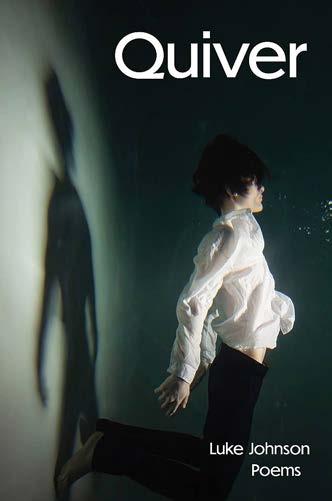
She was my mentor and professor in grad school at the University of Reno in Tahoe. I was struggling a little bit as a lyric narrative poet. My lyric impulse wanted to take me certain directions, and I was struggling with some of those directions that wanted to take me. She was the first person who gave me permission to “open the door for demons.” And that just stuck with me.
I consider myself a fringe Fresno school guy. You know, Larry Levis, Philip Levine, Lee Herrick, and Brian Turner. I wasn’t necessarily reading Patricia, I think, partly for that reason. I was so steeped in those poets.
But, of course, I knew of her. I came in hungry as a poet. I’d already been publishing a little bit, and she knew immediately, “This isn’t my normal student.” I was older in life. I had kids, and I was working. I was a grown man ready to hustle.
What else are you working on?
I have a second book recently picked up by Harbor Editions with Megan Merchant. It’s a call-and-response project, titled A Slow Indwelling.
Where can we find you on social media?
You can buy Quiver on Amazon: Quiver: Poems: 9781680033205: Johnson, Luke: Books
And through the press: Quiver
Connect on Twitter at @Lukesrant or Facebook Website: lukethepoet.com
About LUKE:
Luke Johnson is the author of Quiver (Fall 2023) with Texas Review Press & A Slow Indwelling (Harbor Editions 2024), a collaborative work with the poet Megan Merchant. Quiver was a finalist for the Levis Prize with Four Way Press, The Vassar Miller Award, the Jake Adam York with Milkweed and the Brittingham & Pollock through University of Wisconsin. His poems can be found in Kenyon Review, Prairie Schooner, Narrative, Florida Review, Poetry Northwest & elsewhere.
BLUE MOUNTAIN REVIEW september 2023

https://www.tamupress.com/book/9781680033205/quiver/
https://www.southerncollectiveexperience.com/the-blue-mountain-review/

SEAN
FERRIER-WATSON
by CLIFFORD BROOKS
Tell us about yourself, Sean?
I’m a native North Texan, born and raised in Denton, Texas. My mom’s a Texan, too, from Wichita Falls, but my dad’s from Nadi, Fiji. We’re quite a mix. Let’s just say my family stuck out in small-town Texas in the 80s and 90s. I now work as a full professor of English at Collin College in Frisco, Texas, where I teach a variety of writing and literature classes. My writing career largely focuses on genre fiction these days. I write and publish fantasy and horror pieces, mostly short fiction with occasional poetry, but I got my career started writing poetry back in graduate school in the early 2000s. I’ve also published literary criticism. My most significant publication to date is my book The Children’s Ghost Story in America (McFarland, 2017), but I am hoping to find a publisher for my short story collection Imminent Nothings soon.
Have you done any editing work?
I currently work as an assistant editor for JASAT and Quest JASAT publishes scholarly and creative pieces on behalf the American Studies Association of Texas. The journal began publishing in 1970 and continues publishing annually today. We accept peer reviewed articles on a variety of issues in the social sciences and humanities, but we also accept poetry and short fiction pieces from southern writers, much like The Blue Mountain Review. Quest is our undergraduate research journal at Collin College. We work with students submitting research papers produced in their college classes and send those papers through a peer reviewer process very similar to your average scholarly publication. It’s a great way to get students at Collin involved in the scholarly community. Our publications are available on ProQuest and Google Scholar.
What are some benefits to working at a college with a strong writing program?
I love working in the writing program at Collin College. We have a fabulous cohort of writers and professors. Our college has some impressive faculty—LaToya Watkins, JD Isip, Scott Yarbrough, and Joani Reese, to name a few. We also have some impressive publications at our college. Other than Quest, my college publishes Forces. It’s a great literary and arts magazine! We publish it once a year, featuring the creative works of students, staff, and members of the community in Collin County. The magazine has been running for more than thirty years, which is quite a feat for any arts magazine.

41
an interview with
How has teaching shaped your career as a writer?
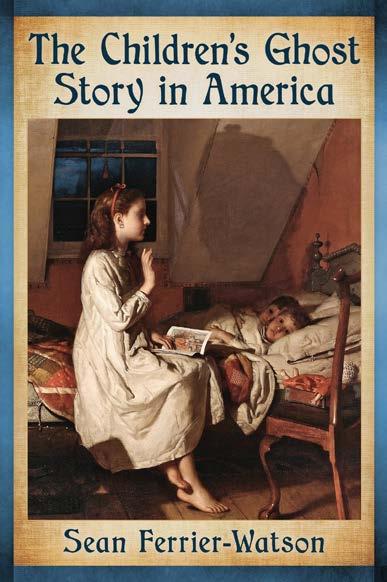
Teaching is the life blood of my writing! It keeps me reading and up to date on my craft. I can’t really imagine a better way to stay current and fluid in my writing without teaching it every semester. I would recommend teaching for anyone serious about the craft of writing.
About Sean:
Sean Ferrier-Watson writes poetry, fiction, and non-fiction on various topics and within many genres, but he especially likes to write fantasy and horror. He teaches writing and literature at Collin College in Frisco, Texas. He currently works as assistant editor for JASAT. He has pieces published or forthcoming in Lovecraftiana, Borderlands: Texas Poetry Review, Better Than Starbucks, Hawk & Whippoorwill, Hellbound Books, and Illumen. He has been a finalist in Crystal Lake Publishing’s Shallow Waters Flash Fiction Contest and in other contests. His book The Children’s Ghost Story in America was published by McFarland in 2017. Follow him at www.seanferrierwatson.com.
BLUE MOUNTAIN REVIEW september 2023
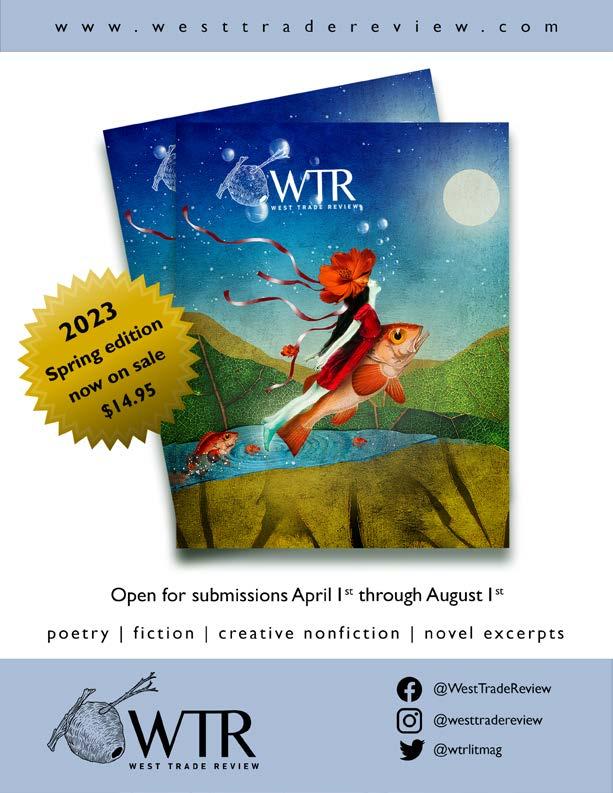
https://westtradereview.com/
the redheaded stepchild a home for rejected poems
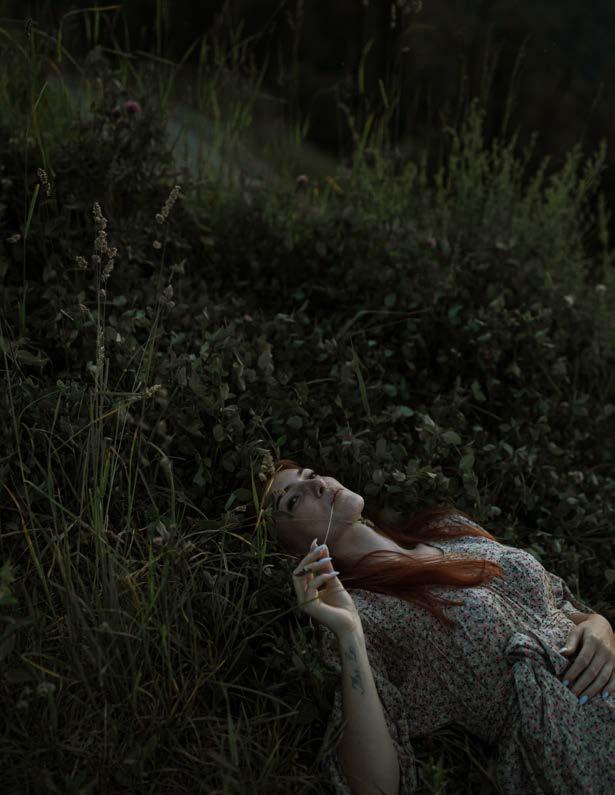
The Redheaded Stepchild only accepts poems that have been rejected by other magazines. We publish biannually, and we accept submissions in the months of August and February only. We do not accept previously published work. We are open to a wide variety of poetry and hold no allegiance to any particular style or school.
visit www.redheadedmag.com for more information & submissions
MUSIC INTERVIEWS

MUSIC INTERVIEWS

AN INTERVIEW WITH TOMMY HOWELL
by CLAYTON JONES
You have been around the block as an actor, but you’ve recorded a new album and will be playing songs from it during your new show “Backstage with Tommy Howell and Friends” at The City Winery in Nashville. Which one of your songs defines your style? Why?

Actually, “Hell of a Life” was not the first song I wrote for [my album] American Storyteller. As you know, there’s a lot of actors that come before me that are singers and most of them don’t like to talk about their [acting] career. I found that to be sort of ridiculous really, but I decided to write a song basically about my career to sort of be an icebreaker between me and the audience. My shows are story driven. We do a lot of talking and telling stories about projects and people I grew up with, whether it was something like ET or Red Dawn or The Outsiders. Whatever it may be, it tends to sort of clear up any confusion when it comes to me being open or not with the topic of discussing my own career.
A lot of people have questions about some of the lines in “Hell of a Life.” There’s a line where I said I went Back to the Future before Michael J. Fox. A lot of people don’t realize that I was Marty McFly for a couple of weeks getting ready to shoot. A movie opened for Universal real big. It was called Mask. It had Cher and Eric Stoltz in it. And all of a sudden I got the call that the studio was wanting to go with Eric as the lead in Back to the Future and I got bumped. I think it took a month of filming with Eric and they decided that it wasn’t really working out for him and they decided to go with Michael J. Fox. So people tend to ask what that refers to. I have a lot of fun being able to give a little inside information behind the scenes on different projects.
“Hell of a Life” is a fun song, really. A lot of people can relate to those projects that I was in. I was so young when I began and I think I’ve been in a lot of people’s lives since they were young. I’m 56 now and you know, back then movies were special—all red carpet events. They all had big budgets. It was an important thing. Today, you know, I mean, some movies don’t even get released. It’s just a whole different world now. So, I found a lot of joy just really putting together something that people can relate to and have fun with and that’s how “Hell of a Life Came” around.
Who played on your record? How’d you go about writing it?
A gentleman that I met that I love and respect: Roger Miller’s son named Dean Miller.
47
I worked with him getting the album done. But a couple of different songwriters helped me a little bit. A guy named Dave Kennedy and a guy named Channing Wilson helped me out a lot. He’s from LaFayette over there by Chattanooga. You know, guys like that.
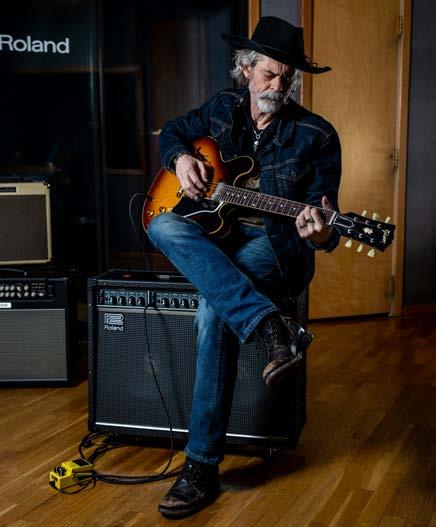
What can you tell us about your new weekly show at the City Winery in Nashville: “Backstage with Tommy Howell and Friends”?
So the concept for “Backstage with Tommy Howell and Friends” sort of originated when I was sitting around with my manager, Sam Parker, and we started talking about how my old favorite shows growing up were variety shows put on by people like Johnny Cash and John Denver and Barbara Mandrell. Those were my favorite. Just musically driven. They were always upbeat, funny, and they’d have guests come in. They do comedy sketches and talk about their careers and recordings and film and all kinds of things. And I just love that format. When I was a kid I’d been growing up in Hollywood and spent a great deal of time collecting my friends and people that I’ve worked with over the years. It just seemed like a great idea to try to present something here in Nashville that I haven’t seen done before, which was bringing guests that work in Hollywood—both, you know, currently and in the past to share their story while we supplied music to the room. So, it’s just been a great opportunity to use this platform and create this.
My version of a variety show, for a lack of a better word, sort of tells my stories through music. It’s really a great platform for storytelling and making a connection with the audience. A lot of people have fans with the Cobra Kai cast or maybe ET. And it’s a great opportunity for everybody to come and sit down and see some music and talk to people that have spent their lives in Hollywood. And they have great stories to tell. So it was sort of a whim, to be honest.
Are you really bringing the cast from ET?
The ET cast, you know? I do see these people and talk to them often. Dee Wallace
BLUE MOUNTAIN REVIEW september 2023
is a dear friend. She played the Mama in that movie and she’s a dear friend. Every once in a while we’ll get together and we’ll go, you know, to a Comic Con and to a signing and do a panel together and break some bread. And that’s really what led to this for me. It was just a real pleasure to be able to invite them all to Nashville and come have a damn good time and we’re going to. I can’t wait to show clips from the film and discuss the making of the movie. They’re all great people and they’re really excited to come, so I’m super stoked to bring them in, you know?
Did I see a picture of Charlie Sheen on the bill for the show?
Yes. I’ve known the Sheen family since I was 14 years old and of course, his brother, Emilio Estevez. I did The Outsiders with them, and then I did Red Dawn with Charlie. Just two years later, when I was 16 and when I was about 22 or so, I did Gettysburg with their father, Martin Sheen. I was raised in Southern California and we spent a lot of time together out in Point Doom and Malibu, and they were just a second family to me when I was a kid growing up. So, you know, reaching out to Charlie was easy. I think Charlie’s a bit misunderstood. You know, he was open about this, but he was a crack addict for many, many, many years. We all suffered through those times with him and prayed over him and hoped—hope to God that he wouldn’t be killed and he’d find help. We single handedly watched him self-sabotage his own career and I’m happy to say he’s been sober for five years and he’s really

49
rededicated himself to being a father and open to talking about what he went through and trying to help others that struggle with addiction, or even family members that are trying to cope with an addict in their family. I was just super pleased when he said he’d come and do the show with me because I think it’s an opportunity for us to get real personal.
You know, the more personal you can get on a platform like this, the more universal it becomes. You might think you’re the only one going through something, and as soon as you open up and share, your mind is blown at how many people are going through the same experience or how many people can relate. You know, that’s not really the angle that I’m looking for by bringing him on, but that’s just one aspect to it. Of course, Charlie is one of the funniest people I’ve ever met, and he’s literally one of the most intelligent people I’ve ever met. He’s got a photographic memory. He doesn’t forget it. And that in itself is a miracle.
You used to be C. Thomas Howell. Where did the “C” go?
Well, I gotta tell you, first of all, I’ve never really been a fan of it anyway. Everybody’s always called me Tommy. I am a junior. My father’s in the same union. He was a stunt man and we’re both in SAG. And it was either I was either gonna be a junior or tag the C initial onto my name . . . so when we came to Nashville, I just wanted to become much more personal, much more approachable, and I felt like, well, why? Why carry that C. Thomas Howell tag? I don’t even really want to ride on that. I just want to be, you know, a musician and make people feel comfortable and tell my story.
So, I just felt that. This was my opportunity to let go of the C. I’ve tried to do it in film, but the producers won’t let me anymore because I’m established and that’s how they sell their wares when I’m involved, but this was a brand new start: a fresh start with a new career. I wanted to use the name that I’m called and let people understand that I’m grounded and approachable and fun. So that’s where that came from really. And besides, that’s why I’ve only been called Tommy my whole life by everybody in my family since I was a baby and it just made a lot of sense.
What kinds of responsibilities do you have as an artist?
You know, I think there’s a big picture. I think there’s more to life than just yourself. It’s being able to reach out and affect somebody through words and through a performance, whether you’re acting or singing, and then being able to connect to them on a very personal level. You see, the more personal I can make my work, the more universal it becomes.
You know I don’t think young artists really understand that. I think it takes a while to really grip the more personal I can make something. I’m constantly blown away at how many people can relate to that, so it really reflects upon the whole, you know? We are all here on this planet and we all experienced the same things at different times, you know? So it really opened my eyes up to the collective.
What does that mean? I mean, we’re all the same. You know, we’re basically all the same. But we’re seeing things from 8 billion different perspectives. So once you tap into that, you realize we’re not so different. That I think is the most important lesson I have learned as an artist. And understanding there’s no difference between me, you, or an audience member. We’re all from the same source. We all got a heart. We’re all here hopefully trying to live and grow and learn our lessons and that to me really makes it all worth it for me, you know?
You seem like a spiritual guy. Is that part of your not just your creative process, but maybe even your approach to life? The letting of the self die and just getting out of the way of it all?
Thank you for understanding, man. Yeah, just hearing you say that moved me. That’s why we’re all here, brother. That’s the absolute truth. And I’m not wanting to try to shove it down anybody’s throat, but if I can put a smile on your heart and and not be afraid to tell somebody I love them and and thank them for being a part of this, and then they can go and do the same thing; we’re just kind of that ripple in the pond. You throw that rock in the pond and those ripples spread out all the way to the edge, you know? I’ve noticed that it’s such a gift for me to be able to share those moments with people.
50 BLUE MOUNTAIN REVIEW september 2023
Website: www.tommyhowellmusic.com
Storytellers Unite

Join Our Creative Community
“
1455 exists to connect communities, instigate discourse, and celebrate storytelling in its myriad forms. All our free programming is dedicated to this mission, and we remain proud that our work serves as a viable showcase for the type of talent and empathy on display throughout all our programs.”
Sean Murphy Executive Director, 1455

A Place for Storytelling
1455 is a nonprofit organization seeking to advance the appreciation of and passion for storytelling through programs that support expression, education, and the sharing of writing and literature. It holds events throughout the year dedicated to supporting writers of all ages and skill levels.


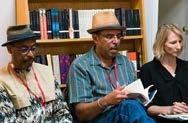

@1455litarts



Learn more at
1455litarts.org

51
Writers • Artists • Musicians • Performers
CHRISTOPHER SWANN
AWARD-WINNING AUTHOR, GEORGIA AUTHOR OF THE YEAR

BOOK 3 AVAILABLE JULY 2023!
"Christopher Swann never disappoints . . . A must read."




—J. T. Ellison, New York Times bestselling author
SHE'S A WEAPON FORGED IN THE FIRES OF HER PAST
P h o t o b y : S t e v e P e o s i
an interview with
abe PARTRIDGE
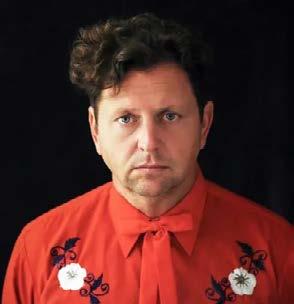 by CLAYTON JONES
by CLAYTON JONES
What’s your story? How’d you become a singer songwriter?
I left home in Mobile, Alabama when I was 18 years old. I went to four Bible colleges in four years. I got a theological degree. I married my wife Cathy that I met at the third Bible college the day after I graduated from the fourth Bible college. We started having babies. I moved up to Eastern Kentucky when I was 25 to accept the pastorate of a small church in Middlesboro. I failed miserably. When I was 27 years old, I moved back to Mobile, Alabama and joined the military in 2007. In 2015 after having written songs for nearly a decade, I began to finally perform my songs in front of people and it changed my life.
What about your visual art? Is there a connection between the music and the painting?
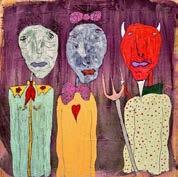

I think they’re connected in the way that they both come out of my brain. However, I do see them as distinct practices, they both come from the same place, but take entirely different forms and are created in entirely different ways.
What is the connection between God and music?
Well, I think God made music, and I think he made it in order for human beings to communicate with each other on deeper levels that is otherwise unattainable through speech alone. I think that we make a perversion of that when we use it solely for entertainment purposes.
Your music videos are on point. They’ve made it into a mainstream audience. How are those created? What’s the story there?
Well, I just dream stuff up, and then find people that are talented in areas that I am not that can help me bring those dreams to fruition.
53
If you got the opportunity to introduce an intelligent extraterrestrial to music, what album would you play for them? Why?
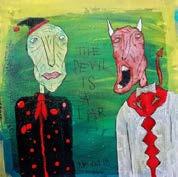
Probably the Anthology of American Folk Music as compiled by Harry Smith that was released on Smithsonian Folkways back in the 1950s. The reason I say that is because it captures very raw, emotional recordings of music long before commercialism was given much thought in the recording process. That is what I believe makes our music great and that is what I would be sure to convey to the intelligent extraterrestrials.
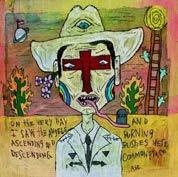
What can we expect from Abe Partridge in late 2023? What about 2024?


My new album, Love in the Dark, came out in May of this year and I will continue to tour my album throughout the remainder of this year. I [went] to Europe in June and July. I got my first international art show at the Metropolitan Museum in Tilburg, Netherlands. I’ll be playing shows and festivals through the end of the year and also showing my art.
In 2024, I’ll probably still be doing what I’m doing now. I’ll be painting a lot, writing songs, and playing shows. I’ll also be working on Season 2 of my podcast, Alabama Astronaut, with my co-producer Ferrill Gibbs.
Website: www.abepartridge.com
BLUE MOUNTAIN REVIEW september 2023
NEW POETRY
ONE THOUSAND SHEETS OF RICE PAPER: POEMS
 by Kevin Cantwell
by Kevin Cantwell
“Kevin Cantwell’s masterful poems are built for the ages...”
Frank Bidart, winner of the Pulitzer Prize for Poetry
BOX OFFICE GOSPEL: POEMS
 by Marissa Glover
by Marissa Glover
“These poems help us all see the world as it is—with its broken hearts, its tumors, its ugly politics, its war. From Bond and John Wick to Deborah, Queen Esther, and other warrior women, each page here offers us the saviors our fragile world needs today. Most importantly, these poems make us know we can be right there with them in the fight. And I can’t think of a more valuable gift a poem, or a poet, could give us in these times.”
Jack Bedell, author of AgAinst the Woods’ dArk trunks
IMMORTAL STUFF: PROSE POEMS
 by Cathryn Hankla
by Cathryn Hankla
“Sometimes reflective, other times, philosophical or perplexed or tongue-in-cheek about the existential vagaries of what we call life, this narrator always achieves a certain wisdom that only a seasoned poet like Cathryn Hankla can bear witness to. We can always expect the unexpected and original from Hankla.”
Peter Johnson, author of old MAn hoWling At the Moon and shot
TAMP: POEMS
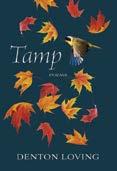 by Denton Loving
by Denton Loving
“Each poem in tAMp is a world in its own right: each a timeless praise song to the earth, to solitude, loss, and love. With bucolic sensitivity shared by few, Loving has crafted the most convincing wake-up call—gentle, surefooted, hypnotic, and insistent. Tamp is a rare trove of honest, measured assurance, a blessed reminder of what matters most.”
Shawna Kay Rodenberg, author of kin: A MeMoir
55 www.mupress.org
Use coupon code MUPNEWS online for 20% discount off your entire order or call 866-895-1472 toll-free —Shipping charges will apply—


Tell me about being a woman in jazz.
an interview with LIZZIE THOMAS
JAZZ SINGER
by AHNA PHILLIPS
Being a woman in jazz has some really wonderful, positive aspects, and then also jazz is really that last relic of “It’s a man’s world, baby.” I have to always be on my best game and believe I have to work harder. I’m a big believer of “What you give is what you get.” I really try to give respect, honesty, humility, and to be professional with all my bandmates, contacts at clubs, and so forth. Honestly, if I don’t get that in return, I won’t work with you.

And you’re in a unique position in that you’re not only a female jazz musician but you’re also the bandleader.
Correct. One of my things as a female bandleader is I like to work with – Sorry, guys, but my first call for my bassist is female, Noriko Ueda. We’ve been playing together for fifteen years. She is a part of [Blue Note Records supergroup] Artemis, so she is quite busy, but I feel a real camaraderie and respect between us, plus I just really like spending time with her! I do as a female really like to have other females around me.
Also, I was brought up with an older brother, so you’ll find that most of my band are seasoned, professional men. I feel very comfortable with them. I enjoy looking to them as mentors, as well. When I speak with John Di Martino on piano, or Neal Smith on drums, I say, “I really want to do this tune. I think arrangement-wise it could go this direction. What do you think?” There’s a lot of conversation before we get to the rehearsal, the gig, or the recording studio. They have incredible knowledge of music and jazz, and have played with the best in the business.
For instance, next month I’m going to record with them some holiday tunes with some of my originals. This is really a new avenue for me. I’ve written for a long time, but as I mature I feel like I’m tuning in to more creativity. I feel like a vessel that can channel more creativity. Being able to share these original songs in a public forum has become very important for me.
Do you write jazz songs? Is that your personal style when you write?
I’m an improvising jazz musician. I’m not set to a set structure or form. Probably most of my tunes are going to fall into pop, but we’re playing them within a jazz framework. The listener is really going to determine – if there’s a need to deter-
57
mine – if it’s pop, jazz, or whatever it is. The experience of the song is more important than the category. We shall see! (laughs)
You’ve been open on your social media about a season of personal loss that you’ve been in, and you posted a song that maybe came out of that. Do you want to talk about that?
Yeah, sure. My mom passed just, gosh, six weeks ago, and I guess as musicians, as artists, as creative, empathetic people –which I believe I’m all those things – sometimes the best way we communicate… you’re getting me emotional…
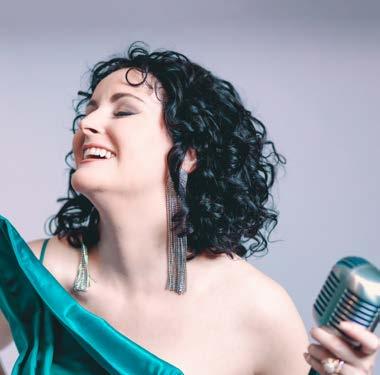
That’s perfectly fine…
I mean, it’s an emotional thing, right? A great way for me to release, express, heal – really a lot of healing for me has been through writing songs. One of the originals I recorded this summer is a song about dealing with the loss of my mom and healing through that. I would say that most of my songs come from a place of experiencing healing and I honestly want to share that. My art is to share and to help others heal and move through their own process of living this life as humans. It can be hard sometimes.
Tell me about your recent move from being an independent artist to signing with a label.
It was a move that for a long time I didn’t want to make because of the old way of record labels – basically, they owned your life. They owned your schedule, your image, what tunes you should sing…all of that. I’m a very independent, autonomous artist. When Dot Time [Records] came to me, they said, “We love the concept of [the album] Duo Encounters -- the raw, intimate nature of it. We really respect that you’re an independent artist. We love your image, voice, who you collaborate with, and that you understand the business of music.”
They’re based in Germany, with offices in NYC, and they wanted to help with exposure, and launch my music in Europe. They also work alongside PR mogul Lydia Liebman, whom I wanted for Duo Encounters, so it sounded like a win-win. Before then I had taken my career as far as I could on my own. I got to the point where I really needed the partnerships offered through Dot Time. So I said yes. Duo Encounters was released on Dot Time in late March ‘23. Vinyl will release in September ‘23 and I have my very first European tour in October ‘23 and into 2024. This will help me catapult my career to the next level.
I wanted to ask you about your background as a music educator. You owned your own piano studio, teaching piano for a number of years in Nashville. To what extent is your show an experience of music education for those audiences that might be newer to jazz?
I’ve learned that it’s important to talk about the songs throughout the live set.
BLUE MOUNTAIN REVIEW september 2023
I’ll give you an example. I do the tune “‘Round Midnight.” It’s on Duo Encounters. I actually play the duet with a cellist. Cello is a classical instrument. This enables me to talk about an expanded idea of what Jazz can be and how to adapt instruments that may not ordinarily be used in jazz and show they can contribute big ideas and new sounds. So “‘Round Midnight” is a Thelonious Monk tune that has multiple versions with different lyrics. Jon Hendricks, Bernie Hanighen, and Babs Gonzales all wrote lyrics.
This gives me a chance to say, “This is a Thelonious Monk tune. I’m actually going to do two sets of lyrics. I want you to hear the original Bernie Hanighen lyrics, which will be in the middle, but I’m going to start and end with the Jon Hendricks, which follow the intro and ending that Dizzy Gillespie added to Monk’s tune.”
So yes, I choose to share the information, bring the audience into the tune and the depth of the experience. And yes, this is important to me. I think this also helps the listener understand a little more about the song – where it came from and how important the music really is.
Right. Well, and so much of jazz’s origins and the greats are people of color, and you recognize that you’re in a tradition -- that you are inheriting this amazing legacy and you want to build on that, if I’m hearing you correctly.
Absolutely right. I mean, the truth is that in the American Songbook, most of those tunes were written by Jewish men. But also, Jazz music is Black music – it’s Black American music. And as a white female in the legacy of jazz, I honor them. I respect it by talking about it, sharing the background of the song, its richness and depth of emotion.
My icons, my influences, they’re all Black women: the great Betty Carter, Nina Simone, Carmen McRae, Sarah Vaughan, Billie Holiday, Ella Fitzgerald. And you know, I’m not saying that white women can’t be part of jazz, because that can’t be true. As a white woman in jazz, I want to acknowledge, respect, and honor this wonderful tradition. Music can convey these ideas, but only Jazz could give you the lived experience of these iconic people.

Yeah, I love that. Is there any last thing you want to say that I did not ask you about yet?
I’ll share the inspiration about Duo Encounters and why I was moved to do this very different album. It really came out of Covid, after we had been silenced in our apartments – I was in NYC– and I remember the time we came out of lockdown, and we were able to enter the room with one other person. I called my pianist and said, “We’ve got to get together.” And John [Di Martino] was like, “Totally!” In my apartment building there was a common area floor that had a grand piano, which was just heaven for me, so after – gosh, was it 3 to 6 months of being by yourself or just being with your spouse?
But not being able to express was torture. And with jazz, for me, it’s always with someone. I write at the piano, but it’s not as interactive. So I remember this moment of first singing with John at the piano, and the level of intimacy –musical intimacy – of freedom, just an explosion taking place. And I told myself, “When you start doing gigs again, you don’t have to have these huge bands, there’s something really special about this duo, this duet connection. Remember this moment.”

www.lizziethejazzsinger.com
VISUAL INTERVIEWS

VISUAL ART INTERVIEWS
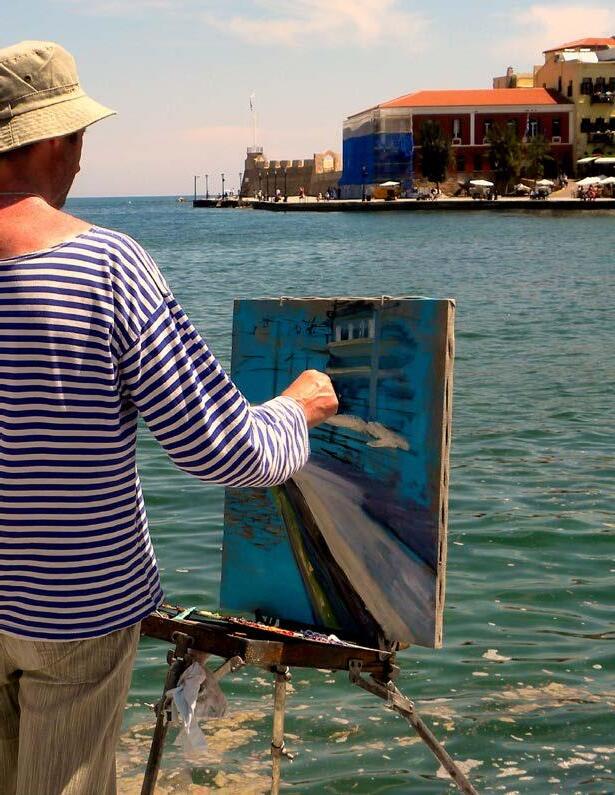
an interview with CHARLES BREMER
 by LYNNE KEMEN
by LYNNE KEMEN

Welcome, thanks for sitting down to talk. You have such a wide range of interests in the arts. Tell us about some of them.
At this moment photographic art is my focus … but it also involves some mixed media and painting. For many years I worked in experimental sound, building instruments and sound sculptures, as well as performing. In my earliest years I did photography and ceramics, fell in love with figure drawing and designed and built playgrounds. The playground work eventually led me to three decades working with sound. Figure drawing eventually led me full circle back to my photographic work today.
One of the pleasures of art is that so much of it starts with the skills of working the material. This is true with every art form. It’s the raw materials. When you command those, you can explore humanity, emotion, and who we are. Our senses of sight and sound, imagination and inspiration, that’s the center. Creativity is in all our senses but those two orbit one another. Throughout history artists have had the potential to change the world with only a pencil or brush. In our paint box today we have the tools by which light and sound are transferred through electronic signals, but our humanity is always the central core.
How did you get started with art?
My parents loved art. My father was a college chaplain, before that he was a forest ranger at Yellowstone Park. Nature and art and spirit were always important. Each year when school ended we would spend most summers traveling and camping, sometimes all around the United States. We would visit the national parks, native communities, sacred locations, art museums, places of beauty … we would go there.
63
This was the very early sixties, roads were often undeveloped and few people traveled and camped.
I remember my mother giving me pastels and paper. I was nine and sitting on a log at the edge of Teton Lake looking up at the majestic mountains. I had this experience when I drew where I suddenly felt like I was floating in the air before those mountains. It just took me out. Drawing and art, it was a tool that I found, “I can do this. This is good.” And then the music part of it, the drumming and the rhythm was also a pathway for me. My wife Martha and I put together our first element show; Art on the Wind in 1988. I worked with Aeolian harps and built wind activated instruments. Later we put together several group exhibitions based on water, fire, and earth. The natural elements are so much a part of living here in this part of the world, wind and air, spirit and inspiration.
How has your art changed over time?
It is always changing. I had times when in the discipline of figure drawing I would spend 7, 8, 9 hours a day with graphic hand work. You get to a spot that your mind is just like whatever you’re looking at, you can record it and you can report it back. Then you get into another phase, and your creativity is based on something completely different. At a certain time in life, you had a certain brushstroke or a particular way of handling something. Now the brushstroke is different. And it’s the same for all of us in the arts, musicians, dancers, writers, even their choice of words. You know, our neurological systems are age oriented. And in my 70s now, it’s a whole different thing.
I want to ask you about your encaustic art.
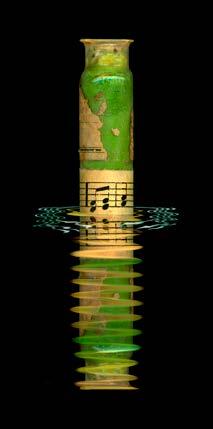

I first learned about photographic darkroom developing when I was seven. Later, as a teenager I developed printmaking skills, and became very proficient in black and white photography. I wanted to follow that into the future with digitization because there are things that you can do with digital tools in terms of the quality of the image, light, and shadow that surpass darkroom chemistry. But my questions revolved around longevity, the physical durability of material, and presentation. I realized that beeswax, particularly encaustic wax- beeswax infused with some damar resin and carnauba wax- answered my need. There are ancient artworks done with wax that are 2,000 years old, often needing very little museum conservation. I find such a remarkable relationship between photography, lampblack carbon pigment, and beeswax. For me, after many years of working with classic photographic methods, it is a pleasure to create a new pathway for printmaking with a new digital environment and then saturate it with the encaustic wax in a way that the durability and the long-term stability is off the chart.
Where can we find you on social media?
I tend to use social media very little, but you can find some of my recent work on instagram at: @briarcreekstudioandgallery
texasreviewpress.org


www.midwayjounral.com
ILENE GOLD
BE NICE SOUP
ABOUT THE WORK:
Be Nice Soup is a collage, created entirely from National Geographic magazines.

About Ilene:
Ilene Gold creates collages using only National Geographic magazines. Cutting thousands of pieces of paper and assembling them into a new image. The collage idea started by recreating famous paintings made entirely from National Geographic magazines. As this medium evolved, a new collection started with the re-creation of Ilene Gold’s award winning photographs, still using only National Geographic magazines. Look closely and you may find a hidden phrase or words within some of her pictures. She tries to capture a painterly quality with each collage. It seems she is almost painting with paper.
Her photography from the US, Europe, and the Middle East has won her awards, and has been published in national magazines. Prints of her collages have been sold in New York, Paris, Nice, Maryland-The Baltimore Museum of Art, The Baltimore Museum of Industry,VA,West Virginia, Rehoboth Art League,Arizona, CA, and Florida. Juried art shows: Brooklyn Waterfront Artists Coalition(BWAC), Recycle Art Juried Show 5/2016 & Color Show 7/16, Maryland Federation of Art’s 39th Annual Art on Paper Exhibition 2016, Howard County Center for the Arts 2014-2018, Women’s Works
2018-Old Court Arts Center (IL), Tubac Center for the Arts (Arizona) 2018, Descanso Gardens (CA)2019,The Delaplaine Arts Center,The Arts Council of Wayne County (NC),View-Center for the Arts (NY). Solo exhibitions:The Hoffberger Gallery, Morgan Arts Council (WV), Howard County Center for the Arts 2018. Featured on PBS Artworks and CBS Sunday Morning. Cover story on Spotlight News Magazine 2020. Sold original collage to OliviaDru Cares organization.
67
STEPHANIE LEONARD
About Stephanie:
Stephanie Leonard is an artist and writer living in Brookfield, Massachusetts.
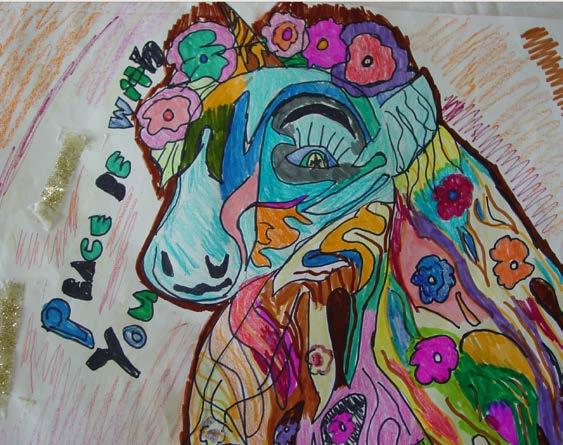
She graduated from Quinsigamond Community College with a degree in Human Services and a certificate in vet assisting she volunteers with service dogs in her spare time and helps animals.
Stephanie advocates for mental health and those with disabilities. She writes:
I do abstract artwork with lots of colors, and in my own unique way, I use art as a healing tool.
I like spending time with my nephews and animals.
68
an interview with NICK KELSH
by LYNNE KEMEN
Welcome, Nick Kelsh. Why photography?

I’ve had an odd career. In high school, I wanted to be a war photographer. I spent a year in Belfast at the height of the troubles working for the Belfast Telegraph newspaper. Long story, and then later, I became a guy that taught mothers how to photograph their babies. The common thread through everything I’ve done is that I always wanted to make something beautiful. And I still feel that way. I get a feeling in my body when I put a camera to my face, and I go to another place in my brain, calculating and feeling what I’m trying to do with my camera. All photographers do that, even if they don’t admit it.
I was diagnosed by two serious attention deficit disorder (ADD) experts when I was 40 years old, and both laughed at me when I said, Well, do I have it? One of them answered: You are the poster child for it.
But he also said, “Fortunately, you have the perfect job for somebody with ADD. Photographers get to play with cool toys, run around in the country and then in the city and places in between, and meet different people, and it’s a visual existence. Perfect for someone with ADD.” And my whole life was explained to me at that moment. It was all true. Right from the start, I was wired to be a photographer.
What is your favorite photograph you have taken?
Decades ago, I was in China working on a book called A Day in the Life of China with 200 other photographers worldwide. Some of them were childhood heroes of mine.

69
Anyway, I was sent to inner Mongolia, and I went to the maternity ward of a hospital. I photographed a little baby who was about two hours old. Several weeks later, I got a call from the editor, who told me I had the book’s cover. I could not imagine what photograph I shot that would be on the cover of this book. And the very idea that it was a picture of one baby they had chosen to represent a country of 1 billion people. I always look back on that as my favorite photograph ever taken.
In addition to being a photographer, you are also a writer. Tell us about your books.
I’m the photographer and author of nine books, including Naked Babies and Siblings (co-authored with Pulitzer Prize-winning writer Anna Quindlen) and three how-to books for amateurs, How to Photograph Your Baby, How to Photograph Your Family and How to Photograph Your Life. I illustrated Rachel Carson’s classic The Sense of Wonder and wrote and photographed two gift books: How to Be Santa Claus and How to Be Dad.

When did you catch the photography bug?

My father came home from World War II with an old Leica camera. (Many GIs did.) That camera documented the entire Kelsh family history for decades. My dad didn’t exactly teach me photography, but he knew that I had some kind of bug (And he had the bug, too, or he wouldn’t have brought the camera back from the war.) Anyway, in high school, my dad told me to get into the car, and we drove 50 miles from our house to a drugstore with a little photography section/camera section. There was a beautiful modern Leica, and my dad bought it for me for $250, which was a huge deal because we never had any money.
Advice for photographers who want to work in journalism?
I can only advise photographers based on what has worked for me. Shoot clean images (bold, simple, with subject and background separate).
Shoot storytelling images. Be easy to work with. Pay attention to the words that are going with your photographs. Having said that, I don’t know where photojournalism’s future is going. Of course, it’s on the Internet, and it’s digital. The new wave of photographers must be creative and innovative with how to use the Internet. If you’re good enough and lucky enough, you need to get yourself associated with some institution that has lots of money to send you places where real life is happening. Good luck.
Please tell me about the iPhone workshops you teach.
I love my iPhone, and I love teaching other photographers how to use it. The opportunity to express yourself creatively with technology at any given moment and then share it is profound and unique in the history of photography. That’s why I teach iPhone workshops.

Photographers whose work has influenced you?



My favorite photographers’ most inclusive characteristic is that they all shot in black and white: Richard Avedon, Irving Penn, Cartier Bresson, Robert Frank, and Dorothea Lange, among many others.
How do we find you on social media?
Website: www.HowToPhotographYourLife.com
Facebook: How To Photograph Your Life

www.HowToPhotographYourLife.com
SPECIAL FEATURES

SPECIAL FEATURES

BRIAN ROSS
of ELLIPTIC ARTIST MGMT
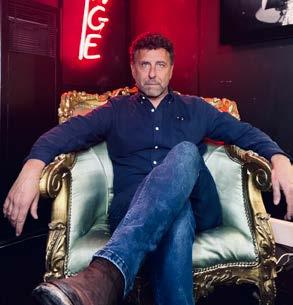 by ALICIA BLUE
by ALICIA BLUE
As a music artist manager, can you talk about all the changes in your actual role in the industry since the age of social media and streaming music services? It seems to have affected everything from the creative aspects of actually making records to how to promote and publicize artists. How do you keep up with it all and stay relevant with all these changes in the digital age?
The industry has gone through vast and profound changes since I moved to the industry side in the early 90’s. In those days, we were selling physical products, primarily CD’s, working radio, touring, videos, advertising in print publications. PR was king and everyone was fighting for that big feature in one of the tastemaker music publications, because, in those days, that could actually move the needle and change everything. Same with radio and MTV. That could make all the difference then, so we were hyper-focused on how to put all of them together into one cohesive plan in order to move the needle. All that began to change with the growth of the internet and downloaded music and much of the industry has fought to keep up.
Without going into a dissertation about the changes and re-education of our jobs, I can say that we’ve moved into an age of primarily promoting, marketing and positioning through social media. Moving the needle through vast radio campaigns is virtually non-existent, and especially in the genres in which I’ve been focused as of late. Most labels rely largely, if not exclusively, on metrics when deciding to sign an artist. The days of sending an artist’s demo to a label and getting signed solely on the quality of the music has pretty much gone the way of the buffalo. Now it’s incumbent on us to do the work here first to build an artist’s audience, on social media, DSP’s and sometimes through touring. Then labels will start paying attention.
We rely so much on pitching digital service providers to hopefully add our artists to editorial playlists for exposure, with around 100K songs being uploaded every day, and with the major labels controlling about 80% of editorial ads...at least on Spotify. This has given the DSP’s immense power to control what artists will be heard. So, we have to create savvy social media campaigns to build our artists through advertising and help guide them to create compelling content on all platforms. I sometimes tell them this is the new touring. You have to be just as good and creative at it as you are at playing live.
75
an interview with
And if we as managers do not keep up with the changes and stay ahead of what’s coming next, we will fall behind and not be able to serve our artists as well as they deserve, which is the most important part of this for me. The old model still holds in certain areas, i.e. touring, for which you can never replace that connectivity. But, to get there, you have to stay ahead of the changes or else you’ll be spending more time playing catch-up than doing the best we can for our artists.
It also helps for me to have really smart younger people on my team, ones who grew up only knowing the newer model and don’t need to adjust their thinking. I’m not too proud to pick their brains and get their perspectives on how they see the industry and how they and their peers accept marketing in this digital age. When press and radio barely move the needle anymore, showing minimal actual conversion, you have to understand all of this or else you’ll be at a standstill wondering why you’re not gaining any ground. If we don’t grow with the industry, we are not doing our job and our artists would be right to look elsewhere.
What do you look for in an artist before taking them on as a client? In looking through your roster, I noticed it was pretty diverse (which I love). It goes from Thievery Corporation to indie rock to Nashville-based Americana artists. Is there a direction you tend to look for or is it broader than that?
I look for greatness. I look for star quality. I look for an artist with something to say, one who knows how to connect with people through their words, their performances, their images, their recordings and how they present themselves to fans and potential fans. I learned early in my career the power of star quality. It comes in different forms, but it has to be there if you want to work with artists who can move the needle. I’m less concerned about particular genres than I am with those qualities. I love so many different genres of music that my focus is just on things that move me.
What year did you start Elliptic Artist Mgmt and what keeps you working independently versus joining a larger management company?
I started Elliptic as a new company in January 2015, but I had operated as Ross Artist Mgmt since 1995. For many of those years I had been a music supervisor for feature films and only managed one artist. So, when I stepped away from music supervision, I decided I should rebrand myself and start a new company, hence the Elliptic name.
I’ve continued to work independently with my own team because, to be honest, I like to be in charge. It just works best for me that way. I did a couple of years as one of the founding managers of a collective called Faction Entertainment in 20162017, working with some really talented managers with whom I thought we could do great things.
But it sadly fell apart, not because of the managers, but because of one person who initially put together the investors for the company and came to think he knew more than this team of experienced and savvy managers. Ultimately, people left the company one by one until no one of note was left standing. I was one of the last ones to leave because I felt I’d put so much into it. That experience has made it harder for me to consider teaming up again. That’s not an absolute perspective, but rather something that would need deep and thoughtful consideration.
What do you believe to be your single most important job as an artist manager? Do you have any sort of code you work/live by to keep you grounded in this competitive ever changing industry?
The most important job for me is to do the best I can for each artist. That may sound simplistic, but that’s really what it comes down to. The logistics are the easy part. What’s more important is to understand your artist, know how to communicate effectively with them, know who their audience is, and help guide them to reach people in the most compelling way. The rest of it, touring, recording, PR, etc, that all comes easy to me. But understanding the artist is key to all of this.
76 BLUE MOUNTAIN REVIEW september 2023
I did some research and saw that you were nominated for a Grammy as a music supervisor for the film and soundtrack for LADY BIRD. I love that movie and so does pretty much everyone else I know! The scene with Dave Mathews’ “Crash Into Me” is really powerful and everyone talks about it. Tell us about this experience and your time spent as a music supervisor.
Yeah, pretty much every young woman I’ve ever met, and pretty much everyone else, loves that film. It’s the one film I’ve done out of 39 that my daughter loves to tell her friends I worked on. Ha. Everyone talks about the “Crash Into Me” scene. They love to ask how I came up with that. But, in truth, Greta Gerwig wrote it into the script. She knew what she wanted since before they began shooting, so I can’t take credit for that. My job was to get the song on an indie film budget, which was a great challenge and pretty fun, actually. It was Dave Matthews’ manager, Coran Capshaw, who suggested to me that Greta write a letter to Dave explaining why the song was so important to her and why it was to this film. She wrote this great and compelling letter and I delivered it to them. He is a huge fan of film and apparently was pretty impressed, because they helped us license it for a very fair fee and the rest is history, as they say.
I loved being a music supervisor for many years. I loved being part of the process of making some really great films. The industry went through some changes as the music industry changed and it just began to not make as much sense to me anymore. So, that’s pretty much it. I wouldn’t change those years for anything, but it’s not something I do anymore.
What’s one thing people don’t know about your job that you wish they did, especially artists?
That sometimes, perhaps on special select weekends or holidays, we’re actually trying to take a day off! <laughing> I laugh about that, but there is a bit of truth to it. I take being there for my artists very seriously, and I am basically at all waking hours. But, sometimes, perhaps like in the middle of Thanksgiving dinner or something, it’s nice to not get any texts with business questions. Not saying that my clients often do that, but there are those times when you’re trying to relax and decompress and you get business questions when the decompression is key.
Jared Beloff is the author of WHO WILL CRADLE YOUR HEAD (ELJ Editions, 2023). He is the editor of the Marvel-inspired poetry anthology, Marvelous Verses (Daily Drunk, 2021), and has been a peer-reviewer for Whale Road Review since 2021. His work can be found at Night Heron Barks, Barren Magazine, River Mouth Review, The Shore, Contrary Magazine and elsewhere. He lives and teaches high school English in Queens, New York, with his wife and their two daughters.
77
Since 2010, 1700+ high school and college students, experiencing foster care or homelessness, have graduated ODBI‘s proven coaching model and curriculum!
Program participants define and create a comprehensive plan for their education and life success. Program graduates earn a fully loaded laptop, certificate, and orange duffel bag...becoming lifelong members of Team Orange.




ORANGE DUFFEL BAG: A JOURNEY TO RADICAL CHANGE

MY
By Sam Bracken and Echo Garrett
Abandoned at age 15, Sam Bracken battled homelessness, poverty, and abuse to successfully earn a full-ride football scholarship to the Georgia Institute of Technology. When he left for college, everything he owned fit in an orange duffel bag. This award-winning illustrated memoir is a road map to personal transformation.
My Orange Duffel Bag Award Highlights: 2011 Outstanding Book of the Year in Young Adult/Children’s from the American Society of Journalists and Authors, the first self-published book in the organization’s 60-year history to win an award.
www.theODBI.org
78
ODBI 501c3 EIN 27-1845671
“How Fires End is a raised fist of a novel, one filled with men’s brutal tenderness and tender brutality. It is both a subtle and powerful indictment of the silences between generations and a poignant testament to the bond between sons and fathers of all kinds. A blazing debut by an important new Italian-American voice.
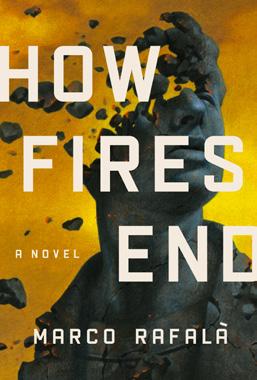 Christopher Castellani, author of Leading Men
Christopher Castellani, author of Leading Men
“ Beautiful, mesmerizing, consoling, and under immaculate control, Marco Rafalà's How Fires End is a powerful novel about the religion we create for ourselves as we face that which perhaps even God has not imagined for humanity.

—Alexander Chee, author of Edinburgh, The Queen of the Night, and How to Write an Autobiographical Novel
Marco Rafalà “
“Marco Rafalà’s debut novel, How Fires End, avoids Mafia tropes for a moving depiction of multi-generational loss and love, grief and gratitude, heartbreak and hope.
-Kirkus Reviews


“
“
introducing
purchase
BookClubPick First SCE purchase your copy here
your copy on Amazon
https://www.amazon.com/Things-Wish-Could-Tell-You/dp/1736230603/ref=sr_1_1?crid=1E48KFS5F4S5B&keywords=things+i+wish+i+could+tell+you+casanova&qid=1694635524&sprefix=things+i+wish+i+could+tell+you+cassanova%2Caps%2C88&sr=8-1
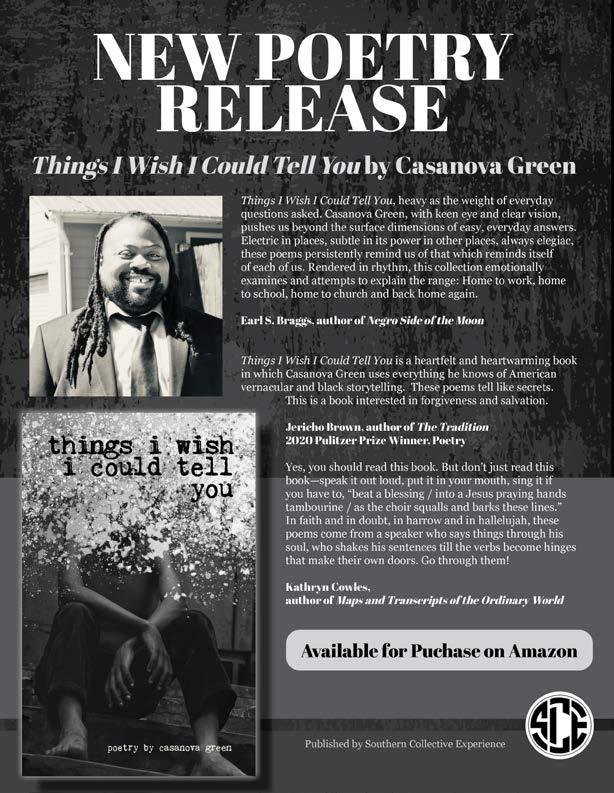
an interview with OWNER, Donna Forsyth,
THE CROWN BRASSTOWN’S HEAD BARTENDER, jake diaz & Executive Chef, Derek Mazza
BY CLIFFORD BROOKS
Who are you, Donna Forsyth? How did art first find you?
It’s interesting how life helps us to figure out who we are if we allow it. The easy answer is that I’m a wife, mother, grandmother, aunt, and friend. I’m also an artist and restaurateur; I love flower gardening, baking, reading, traveling, and hiking. I’m an introvert and enjoy being introspective. A woman who loves community, art, and family. I enjoy growth and learning who I am and where my life purpose is meant to take me, which, in itself, is a constant life-long learning process that fascinates me.
Art found me when I was going through life changes in my 40’s. I joined a beginning sculpting class, which eventually led me to learning about lifecasting: an art form that combines molding, casting, and sculpting to create life-like sculptures, which became my work for 15 years. I often say that art saved me and I truly believe that. Art, whether written, visual, performative, or otherwise, can help us find out who we are and lead us to our purpose in life. It can connect us to ourselves, bring deep joy, and show us threads of hope and insight that heal us.
How did life lead you to The Crown?

Community was the catalyst that led us to opening The Crown. I began visiting Brasstown in 2007 and it was my first real experience with being a part of a close community. My (now) husband, Robert, was a member of the Brasstown Morris Dancers, an artist and folk dance community that centers around the John C. Campbell Folk School. A complete stranger coming in, I was welcomed with open arms and felt immediately like I belonged.
Spending time with our friends and community became our favorite pastime and we loved hosting potlucks, parties, and celebrations, so serving and entertaining our community seemed to come naturally. When we were given the opportunity to purchase the property where The Crown now sits, it became clear that opening a restaurant was our future. Having a beautiful place with amazing views and really great food and drinks is where we start, but welcoming and building community is what keeps us going.
81
The Crown offers a deliciously specific brand of menu. What inspired you to only serve gluten free food?

My gluten free journey started in January of 2008 after spending the previous several months undergoing a barrage of medical tests. I was unwell: extreme fatigue, short of breath most all the time, had skin rashes, and blood tests showed that something odd was happening within my body. After every test, including a bone marrow biopsy, came back negative, my doctor recommended that I go off gluten “just to see if anything changes”. I’d been tested for celiac disease, and it was negative, but she’d been reading some things about gluten intolerance and thought it was worth a try.
It completely changed my life. Within 3 weeks, my energy started coming back, the shortness of breath faded, rashes disappeared, and blood

tests eventually normalized. I couldn’t believe how a food I was eating had created such a storm in my body and to my well-being. Going gluten free was never difficult for me once I started feeling better. When we were contemplating opening The Crown we had concerns that being a gluten free restaurant would be stigmatizing, but we decided to move forward with the plan. Understanding the complexity of gluten cross-contamination and how even the tiniest amount of gluten could be a health risk to those with celiac and gluten intolerance, we felt it important to provide a safe place for people like myself to enjoy a meal out. It has also challenged us and given us the ability to be creative in our menu planning and to learn different processes and ingredients in our recipe development.
We initially kept it quiet so that we wouldn’t be categorized before anyone tried our food, but now that the word is out we’re immensely rewarded by the folks who show up from near and far to visit us and enjoy what we have to offer. We’ve gotten so good at it that no one misses the gluten in any of our food, even non gluten free guests.
There’s a gorgeous Airbnb a stone’s throw away from The Crown. Tell us about that?
The Cottage at The Crown is a sweet 1940’s cabin that we renovated when we purchased the property in 2017. It’s cute, rustic, comfortable, and has amazing views, especially from it’s lovely screened porch. Two bedrooms and one bath, it sleeps up to 4 people.
82
Donna forsyth
What do you want folks to take away from their visit with you?
We want every person who visits us to feel welcomed and to feel like The Crown is a place where they belong. Our goal is to create an experience for our guests with excellent food, drinks, and atmosphere, and for everyone who comes here to feel like they’re a part of our beautiful community, just like I did when I first visited Brasstown.
What makes you, you?
Jake: My family and life experiences growing up in Southwest Florida are a big part of who I am. Originally I started serving at a beautiful country club called Olde Cypress in Naples, Florida and it gave finesse to the hospitality I had already been practicing my whole life. I love to take care of people, it’s the reason I’m in the service industry. The ability to either introduce somebody to something new or create the best version of their favorite drink is what drives my passion to create beautiful cocktails and experiences for my bar guests.
Derek: I’m from Virginia, about 30 miles outside of Richmond in a town called Powhatan. It’s very much like here but without the mountains. It has quick access to a large city with a plethora of different cuisines. I’ve been in the industry for as long as I’ve been working in some shape or form with a couple breaks in between. Cooking and creating has always been a passion ever since I was a kid sitting in-front of a T.V. watching Emeril or helping my parents in the kitchen.
What flair do you bring to The Crown?
Jake: I believe that I bring a wealth of drink knowledge and history to The Crown along with a very big personality and presence. I have a great desire to learn any and all fun facts, I love history in particular. When pertaining to cocktails and drink ingredients I’m always fascinated with the cultural and historical influences on drink styles and eras. From Classical Roman punches to modern style cocktails, you’d be hard pressed to ask me or my fellow bartenders about a drink that we don’t know about.

Derek: I’d like to think my flair I bring to The Crown is simply the composition of the plates, from the flavor combinations down to how it looks. Every ingredient on a plate has a point and is there for a reason, to try the elements on their own and then combine for the full effect. My goal at The Crown is to educate our guests, expose them to different cuisine and flavors, because variety in this area is scarce.

Why do you adore your vocation?
Jake: I adore my work because I believe I bring a very exciting and innovative vibe to The Crown. Working with the kitchen and guests themselves is the best way to create an unforgettable experience for the guest, and I strive to do so every day. Anybody and everybody are welcome at The Crown’s bar. It’s so magical to see people from all walks of life come together and have a great time creating such an awesome vibe that reverberates throughout the restaurant.
83
Jake Diaz
Derek Mazza
Derek: I don’t view my job as a job, vocation is a great word for it. It is my passion and I put love into the menu. I absolutely love putting smiles on peoples faces or maybe making them realize that they do actually like something that they once thought they didn’t.

What are you reading/ listening to now?
Jake: At the moment I’m reading Mountain Spirits by Joseph Earl Dabney, it chronicles the story of corn whiskey from The Scotch-Irish of Ulter to Appalachian Americans. Recently I’ve been listening to alot of Kodak Black and early 2000’s alternative music, but honestly I listen to everything. My grandmother instilled a love for Colombian music and 70’s disco to me, honestly I love any and all genres of music.
Derek: I don’t really read for story or entertainment necessarily. I have plenty of culinary books that I constantly have my head in. At the moment, “The Flavor Matrix” paired with “The Food Lab” is a great resource to me.

84
What other passions in your life keep you going?

Jake: I am the father of 2 beautiful daughters named Alexandra and Isabella, I love them so much and they inspire me to really think out of the box with everything in my life. Along with their support I also just have a natural instinct to give people good service. I always say that I just give the service I expect when I go out to eat and it’s worked for the last 10 years I’ve been doing this. My friends, family, and Brasstown community remind me everyday why I love doing what I do.
Derek: Other than all things food, I absolutely love music. I was in drumline way back in high school and I still mess around on a kit. I’m a very rhythmic person, I need music to function and to keep me on pace with most things. I listen to anything, classical, pop, rap, rock, metal, alt. It may sound ridiculous, music brings serenity and structure to my life.
85

86
FASHION

FASHION

an interview with ALLEN AMUN
 BY JAY-DE ROBINSON A.K.A. MR. CLASSIC EDITED BY NICOLE PARRY
BY JAY-DE ROBINSON A.K.A. MR. CLASSIC EDITED BY NICOLE PARRY
Each culture, country, state, and even town has its own significant style, whether that might be slag, music, food, or wardrobe. Oftentimes, you can pinpoint where a person is from based on these few tells. For instance, the Southern Gentleman: classy, functional attire, a businessman, a family man, and always dressed for the occasion but not afraid to get his hands dirty when needed. In my eyes, he is one of the great voices of southern class and charm, and the most fitting to be interviewed for this article.
Today, I not only have the honor and privilege of interviewing who I consider the epitome of what a southern gentleman is, but also my mentor, uncle, and dear friend, Mr. Allen Amun. Amun and I met in 2017 upon my arrival back to the states from Jamaica. We spent an evening enjoying cigars, scotch, and good conversations. Amun is a merger and acquisitions specialist and business tycoon.
Amun, what is a southern gentleman?
I feel a southern gentleman is a man who represents traditions, family, etiquette, duty, and style. Tradition has always been a large part of the south, expressed in food, faith, etiquette, style, the arts, and community service. The American experience is steeped in southern traditions: Jazz from Louisiana, Blues from Mississippi, Rock’n Roll from Arkansas, and many more artistic expressions have enriched our nation, and the world, and they are southern-born and bred.
Family is the cornerstone of southern values. To provide, protect, and serve your family and community is first and foremost to a southern gentleman. He is nothing without them. He is the embodiment of where he comes from, be it a great city like Atlanta, Georgia or a small town like Camden, Arkansas. The experience of the neighborhood or natural environment he grew up in makes him resilient and strong, yet cordial and humble. He feels a sense of personal improvement and duty to family, community, and country. The civil rights movement was started in the south based on the value of not judging a man by skin color, but rather his character.
Although styles have changed, and in some ways for the worse, in my option, a true southern gentleman always concerns himself with his appearance. He represents his family, community, and brand. In the past, southerners were the best-dressed people in America.
89
After work, you put on your best dress when going to dinner, church, social events, or gatherings. My grandfather and father’s clothes were always pressed before leaving the house. Most of my uncles never wore street clothes as men. This is what I grew up seeing so this was what I emulated as a young man. The clothes maketh the man. Looking back on your life growing up, did the men in your family set an example for you?
Yes, my grandfather, father, and uncles left a big impression on me. They were always “clean,” meaning, “well-kempt.” My mother also set a standard in the home that we represented the family, so we needed to look presentable. She was the first person to teach me formal etiquette. As I traveled, I picked up more style education from places, like Bahrain where I first saw custom suits while in the Navy.
I couldn’t afford what I wanted as a young man, so I took a job at Nordstroms. This is where I bought my first suits for work, off the rack and re-sized to fit. I also received a first-class education on designer brands and professional style while working there for four years while in college. When I entered the business world and traveled to New York and Boston, I saw high-end Italian custom-made suits and began to craft a style that pieced together Southern conservative class with a little flare.
Sounds like you had the right type of lessons, not only of style but also how to conduct yourself. Since it’s been mentioned, I might as well ask: How does your business affect your wardrobe when it comes to your style? Do you find that being in that work fits well for the style you have?
In business, banking, and politics, your clothes are the first thing people notice, even before they really see the person wearing them. I’ve had people come up to me and remark that the sleeve on my suit was of Italian fashion. The custom buttons, the type of watch, or the shoes

BLUE MOUNTAIN REVIEW september 2023
I was wearing, was not a bourgeois observation, but an awareness that this man knows how to dress. He understands quality over trends, substance over brand names, and it makes a statement.
As African American males, we are constantly belabored with stereotypes heaped on us via Hollywood, the music industry, and sports, as though these are the only occupations we can excel at. I can barely dance, and I don’t run a ball - I run a bank!
Very well said. So, as a southern gentleman, do you find it necessary to continue that level of class even today, in a society where dressing up as a thing of the past?
Yes, it is a requirement of a gentleman, southern or otherwise. If tomorrow Hefty bags are the “it” style, you will not see me following the masses. People vote for presidents and prime ministers who wear suits. Lawyers, doctors, and favorite actors are clad in suits. Even if it’s not professional or formalwear, every society has its standard of dress for men of high affairs, be it Kente cloth in Ghana, the Thawb in Arabic culture, or Kimonos from Japan. Clothes set a standard societally and individually.
For me as a southern gentleman, that standard is confirmed when my daughters see me dressed for work or going out, and they smile and say, “Papa, you look sharp!” I carry on the traditions that were passed down to me. I set the standard for the men in my family, present and future. I’ve never seen someone elected to office in Air Force Ones or overalls. If or when we do, it’s a great indicator where your society is headed.

Talking to this new generation of style trailblazers, what advice would you give in regards to creating their own style while still paying homage to the classics?
Hmm - to be yourself, but with the education of what you’re representing. I see a resurgence of the classic
style but it’s still very trendy. It’s a “here today, gone today” fad. A gentleman is subtle yet stylish. His clothes, demeanor, and attitude fit in any environment and situation. He is confident, and dare I say, manly - a term that is skirted around these days.
Suits were designed to make a man feel strong and commanding, as they grew out of military uniforms. They were adapted for the battlefield of business and politics. But whatever your style, craft it from the better parts of your character and traditions.
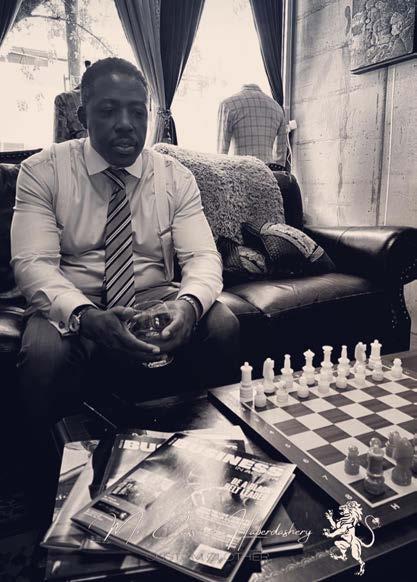
Final question: What is a favorite quote of yours that you would like to leave us with?
If I may, I have one quote and two mottos I live by: “There are no secrets to success. It is the result of preparation, hard work, and learning from failure.” - FMR US Secretary of State Colin Powell
“Semper Fortis” (meaning always courageous) - US Navy motto
“Carpe Diem” (seize the day!)
Always be courageous, seize the day, and don’t be afraid of failure on your path to success. Thank you for this opportunity.
92
Amun, it was a pleasure. Stay classic, my friends!

93
ARTISTS CHESTNUTREVIEW.COM Accepting submissions 365 days a year
Chestnut Review FOR STUBBORN

www.autismdelaware.org
BOOK REVIEWS
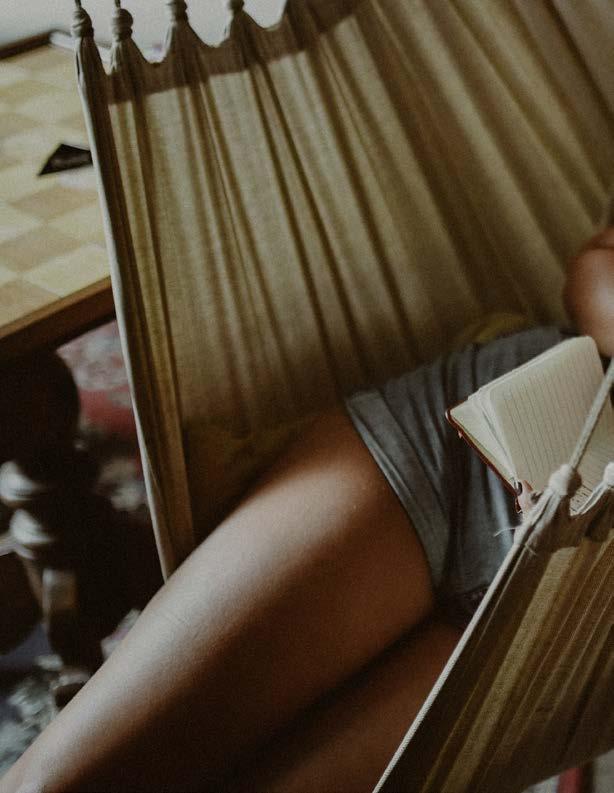
BOOK REVIEWS
 KATHRYN KULPA’S
KATHRYN KULPA’S

COOKING TIPS FORTHE DEMON-HAUNTED
 REVIEWED BY LYNNE KEMEN
REVIEWED BY LYNNE KEMEN
Publication Date: May 1, 2023
Publisher: New Rivers Press
Price: $10.00
ISBN: 978-0-89823-418-3
Number of Pages: 58
Binding: Paper
Categories: fiction, fantasy, flash, stories
To Purchase: contact nrp@mnstate.edu or https://www.kathrynkulpa.com/publications/
Kathryn Kulpa’s book of flash fiction has plenty of cooking-related works, but it is also full of dead people, ghosts, and ghost-hunters. Most of her writing uses a child’s perspective, and she does this voice convincingly. Her opening piece is the title of the book and leaves us not knowing if the young person is experiencing something real or imagined. Horror flash and the supernatural are threaded throughout the book.
Other titles are “Bricolage” ( the Oxford Dictionary defines this “as (in art or literature) construction or creation from a diverse range of available things.” “A Vocabulary for the Haunted” , “Happy Meal,” and “Potato Eyes.”
This is an extremely entertaining book and can easily be read in a single sitting or parceled out in delicious bits.
Kathryn Kulpa was a winner of the Vella Chapbook Contest for her flash fiction chapbook Girls on Film (Paper Nautilus). She is a librarian and a flash editor at Cleaver magazine and also leads writing workshops. Her stories are published in Five South, Monkeybicycle, Smokelong Quarterly, Pithead Chapel, Women’s Studies Quarterly, and Wigleaf. Her work has been chosen for Best Microfiction and the Wigleaf longlist and nominated for Best Small Fictions, Best of the Web, and the Pushcart Prize. Find her at www.kathrynkulpa.com or @KathrynKulpa
97
BOOK REVIEW
https://brooks-sessions.teachable.com/p/the-working-writer


BOOK REVIEW
MARILYN KRIETE’S
THE BOXMUST BE EMPTY
A MEMOIR OF COMPLICATED GRIEF, SPIRITUAL DESPAIR, AND ULTIMATE HEALING
REVIEWED BY JUDY KIRKWOOD

Time does not heal all wounds. Although it may take the edge off the pain we feel when slain by grief, when stacked against the most complicated aspect of the human condition—death—time comes up short.
Marilyn Kriete’s beautifully written first memoir, Paradise Road, introduced readers to an intrepid 14-year-old runaway who lands herself in a Catholic home for troubled girls, is emancipated at age 17, and then falls in love, after a five-year friendship, with an older grad student Jack. Cramming in adventures between hospital visits, the love of her life is dead in 24 months from cancer. Thinking the best way to keep Jack alive is to complete the last leg of their crosscountry bicycle trip, young Marilyn mounts up and pedals her heart out. The book ends with Kriete, much to her own surprise, finding a spiritual family that includes her future husband, Henry, and a mission for her life.
Kriete’s no less beautifully written second memoir, The Box Must Be Empty, unspools a journey of another kind. Her “complicated, catastrophic, cumulative grief” over the loss of Jack two decades earlier plays out against the backdrop of Marilyn and Henry’s leadership roles as ministers in the faith community of the International Churches of Christ (ICOC). An interesting choice for a child of the freewheeling 1960s with self-described hippy tendencies, ICOC is a conservative family of churches located in 147 nations. Its method of enrollment is aggressive proselytizing and intense daily mentoring of members, called discipling. With every hour of every day held to account and strict obedience to senior leaders’ decisions of where their services were needed, the Krietes had moved sixteen times in seventeen years at one point. Switching back and forth among countries and coasts, leaving homes and friends and vibrant new-to-them cultures behind in itself might have contributed to Marilyn’s emotional breakdown.
Curiously, Kriete’s tsunami of grief over the loss of Jack is triggered by a viewing of the movie Titanic when she realizes Rose, now an old lady on the prow of a ship, is still mourning her young love Jack, who died as the unsinkable boat disappeared into the ocean. Although Kriete was not the only woman crying in the theater at the end of the film, she may have been the only one who could not stop for the next several years—to the point she could no longer fulfill her mission as a faith leader for ICOC.
99
Throughout confusing and contradictory counseling by a therapist member of ICOC, and doubts about whether their church was basically going to hell in a handbasket, both Marilyn and Henry deal with loss, guilt, and shame, and, for Marilyn, finding a new path for her life. Her grief does not subside, despite a whirlwind of therapeutic modalities, until she happens on The Grief Recovery Handbook in the library: “a tested, proven way to process, release, and alchemize grief into something bearable, wearable, like a dainty cross on a gold chain, rather than the heavy, splintered, wooden version crushing my soul.”
By doing the multiple-step exercises spelled out in the second half of the handbook, Marilyn finds resolution to her emotional turmoil. Equally important was finding her voice through writing and sharing her shame and anguish with others. A fourth element was memorizing chunks of the Bible and reciting them every day as she moved through her activities. This brought her joy and a different type of spiritual connection after leaving the fellowship to which she had dedicated her life. Perhaps the most important thing she learned was that active grief cannot be buried in a box in the ground—the box must be empty in order to recover.

BLUE MOUNTAIN REVIEW september 2023
https://www.visitathensga.com/athens-beer-trail/



Atlanta & Nashville CREATIVE CRAFT COCKTAILS & CIGARS PROGRAM IN A 1920’S SPEAKEASY ATMOSPHERE www.redphonebooth.com
MICRO FICTION

MICRO FICTION

DOLLY, MY DOLLY
by SUZANNE C. MARTINEZ
My father’s mother was crazy, but I loved her. She lived near the steel mills, and everything was covered with a flimsy grey blanket of silt that rose and fell when the wind stirred. She subsisted entirely on grapefruit. I think she was crazy. She tried to burn herself because she loved my father too much, my mother said. He was her only child, her only love. She called herself Dolly, dyed her hair red, and curled it. There was a mole near the corner of her mouth that danced when she spoke. Mystery paperbacks filled her house and birdseed from her parakeets. She would hold a seed in her lips and her bird would gently retrieve it. My mother said she pushed her blind mother down the steps. Dolly wore cloth flowers soaked in perfume that left a trail wherever she moved in her daylong battle against the dust. My mother told me half stories about her that led me to finish in my mind as terrible as I could imagine. She had no right to try to make me hate her too, to let me doubt her love. Dolly, let me sleep in the little room in the big brass bed by the window where the breeze spars with the curtains and the clock in the hall counts the seconds. She had a heavy iron elephant painted yellow that, by turning its tail, a single cigarette would drop from its belly. She broke her hip falling down the steps rushing to escape the fire. They took her to a nursing home, and we didn’t go to Indiana to visit her any more. When she died seven years later my mother didn’t tell me. I was away at school, and she didn’t tell me. I always wanted red hair.

THEN-NOW
by SUZANNE C. MARTINEZ
My thirty-year-old son sits across from me in the diner. His hair is thinning at the front, and it’s too long. He needs a haircut. At six months old, he had a head of hair so thick it looked like an old man’s toupee.
I stumble into the emergency room, directed to a body strapped to a gurney, the face covered in blood, one leg splayed out at an unnatural angle. Why am I here? Who is this?

He smiles at a little joke he’s told me, and I see his straight, even teeth, so different from his mouth as a two-year-old with skinny milk teeth like a tiny comb.
A bloody hand reaches out to me with the tapered fingers and long thumb of a pianist. I shrink away from it, but I know this hand well.
He butters his toast and tells me about his week at work. His eyelashes are as long and dark as they were at birth, and they brush his cheeks when he smiles.
A neck brace prevents his mouth from moving, but I hear a voice whisper, “I’m okay mom, don’t cry.” It’s as if it’s come from a ghost.
I worry that he works too hard at his new job, striving to climb the rungs to the next level, make up for lost time. As a toddler, he never sat down to eat; he always had a project, a mission.
I need to cradle him, to count his fingers and toes, and run my finger over his ears, his nose, his mouth. But they come and take my baby away to the O.R.
I squeeze his grownup hand gently, and let go before he does. As a boy, he wouldn’t hold my hand to cross the street, but I held it anyway.
ABOUT SUZANNE:
Suzanne C Martinez’ fiction has appeared in Vestal Review, The Citron Review, Flash Fiction Magazine, and The Broadkill Review, among others and was nominated for Pushcart Prizes (2019, 2020), The Best of the Net (2020), and Best Short Fictions (2022). She received Honorable Mention in the Saturday Evening Post 2022 Great American Fiction Contest. She lives in Brooklyn.
BLUE MOUNTAIN REVIEW september 2023
Kissing the WOUND
here’s the scoop
In J.D. Isip’s second full-length poetry collection, KissingtheWound, readers are asked to look at “this long life” through a multiversal lens, to consider how our lives and our loves, our traumas and our triumphs, fold in on one another, how we are all connected to and reflected by one another. Isip crosses genres and poetic styles, nods to X-Men and Star Wars as well as Shakespeare, Tolstoy, and the Bible; he shows readers what wonders we miss between breaths and days. “When you pay attention,” Isip seems to tell us, “You just might find the healing you were looking for.”

If our memory could shatter like glass and be reassembled with no regard given to time, it would look like these poems: a shimmering window of stained glass whose patterns and glow create unexpected resonances of the many lives one voice can be given. As identities—familial, sexual, spiritual, amicable—intersect and intertwine, time folds in on itself. Everything can and does happen at once. Kissing the Wound is expansive, enveloping. With cross-genre bravery and unfettered honesty, J. D. Isip’s collection examines, at its core, a question of love: for each other, and for ourselves.
- Charles Jensen, Author of Instructions between Takeoff and Landing and Nanopedia
There is a palpable struggle against powerlessness in J.D. Isip’s Kissing the Wound, and in its expertly crafted poems, the path to victory in that struggle always originates from within. Although its external expression varies from poem to poem (telekinesis, immense empathy, razor-sharp wings, conquering love), Isip shows us that the greatest power we have is our ability to remember, to render, and to navigate the “mess of lights and music” that is the human experience.
- Gustavo Hernandez, Author of Flower Grand First
J.D. Isip is the author of Pocketing Feathers (Sadie Girl Press, 2015) and several other works of poetry, fiction, and theater. His second full-length poetry collection, Kissing the Wound will be out in January 2023 from Moon Tide Press. He is also a full-time professor in Plano, Texas, and a contributing editor to The Blue Mountain Review.

107
new poetry release from J.d. ISIP & Moon Tide Press
receiving rave reviews Now available for Pre-Order Here https://www.paypal.com/cgi-bin/webscr?cmd=_s-xclick&hosted_button_id=BL9WWTM76EBM4
https://www.amazon.com/Something-Kindred-Nicole-Tallman/dp/1736230611/ref=sr_1_1?crid=3SYG5S1YZJXIG&keywords=something+kindred&qid=1694636144&s=books&sprefix=something+kindred%2Cstripbooks%2C115&sr=1-1

ESSAYS

ESSAYS

HANA DAYS
BY DOUGLAS COLE
Island Mind
On such a journey you dream you will remake your life, acquire the soulful wisdom of the world traveler, return with new orce strong enough to withstand the shocks you think would have destroyed you. Paradise can fool you this way—the only way to make this happen is to never leave…never leave—
We decided that there were two kinds of days: Kapalua days and Hana days. Kapalua days were those that in their nature resembled our physical trip to Kapalua. Reported to be one of the most beautiful diving beaches on the island, we arrived expecting nothing less than wonder. And it opened to just that: golden sand, green waters pearling into turquoise rolling into white surf. And when we swam out we encountered manta rays, needle fish, morays, angel fish poking out of shadows, sliding over multicolored coral beds as the sunlight swept down in shimmering rays. We atomized in warmth, swam for hours, no worry about time or where to go. We moved in that slow motion the traveler dreams of, mindless and mindful at the same time, aware of the way light reflects off of water, lulled and drifting with the waves seething into the sand and saturating as if the beach itself were breathing. Beautiful emptiness full of energy. Glory. As Suzuki Roshi says in Zen Mind Beginner’s Mind, “The World is its own magic.” We learned later that Kapalua is a holy place, but at the time, beauty was our only expectation and beauty is what we encountered as we becalmed, as the soft clouds floating overhead, pulling their rippled shadows across the cove. And so this became a kind of template, Kapalua, for an unexpected entry into paradise.
Now this is not to say that Hana is not a beautiful place or that it is in any way a natural and opposite contrast to Kapalua. It is simply that Hana eluded us. On our drive down the Hana highway, we did stop at Haipuana Falls where we climbed up through verdant growth so huge it looked prehistoric, towering ferns, banana trees, palms…and then a waterfall two hundred feet high cascading down a black rock face polished to shining, water pulsing in a rainbow as it poured out into an emerald pool surrounded by a natural amphitheater of hanging vines and smooth gray stone and the rich blue sky and sun overhead. Paradise. To be healthy, awake and alive in that space was to feel divinity in everything even you, and to enter that pool of water as we did was to feel cool purity, to swim across and ourselves standing on a submerged stone as the water fell around us (almost painful in its striking), to touch the stone of the wall behind the waterfall…this was to feel a kind of baptism, a cleansing down to the spirit. To feel it, to know it! And I did say a little prayer, there, for I did feel graced and grateful in that space, in that moment.
They both sound like such beautiful, even powerful moments of tropical wonder, again, the sort of vision you might receive of paradise if you were inclined to pay attention to such things in church or mythology…a place away from the place where you really are: I think of mid-west dwellers carving the snow off their cars; of travelers stuck in airports in January as a storm blows through, stranded for days in the terminal… A place you can mostly only imagine or die to, a place where you are always warm, where food is always fresh and delicious and never makes you sick, where the water makes you, if only in feeling, young and strong and golden; yes, alchemically it changes you to the god or goddess you are beneath the job, the woes, the daily striving, negotiations with partners, neuroses that writhe inside us from histories that if written out entire would read as annex notes to the book on love and exile.
So what is the difference between a Kapalua day and a Hana day? First of all, we never reached Hana. That’s the defining feature. One of the kids got car sick. Time pressed in upon us: we had to meet friends at the Kaanipali Royal Lahaina… So, we turned back. Whatever Hana was in our imaginations, it never materialized in our reality, and so the only image I have of it now is a collection of guidebook impressions of rustic thatch buildings, a dirt road, and seven sacred waterfalls laced with seven sacred pools that, had we entered them would have surely provided the purification, the baptism I glimpsed in
111
the pool of Haipuana. But all of it, all I could imagine and all that might have been real dissolves before my reaching hand. That is the image I see. And that is what I mean by a Hana day.
Had we made it to Hana, there is no guarantee that it would have been the divine experience we imagined. Expectations are rarely satisfied. The awareness of this dissonance lies behind most depression, broken marriages, suicides…awareness of something that dissolves before a reaching hand. And what is left? Letting go.
And Kapalua? Kapalua is the other half. It provided, in general, what was promised: beautiful diving. Nothing more was expected, so there was room for discovery. Learning later about its reputation as a holy place only confirmed what we discovered on our own. So the difference between a Kapalua day and a Hana day, it seems to me, is one of stance—expectations. We entered Kapalua desiring simple beauty and received a blessing. We sought Hana desiring something divine and the place eluded us. Of course, along the way it seemed we caught a glimpse of what we could have found, making the image of Hana all the more amplified and acute.
The Zen mind would say that the only difference between the Kapalua day and the Hana day is in the mind of the one experiencing them, that, essentially, the vision of paradise is open to us in any moment and in any place, even the Chicago airport in winter. As Alan Watts says in his “Lecture on Zen,” “The fish of reality is more like the water.” And that sort of lesson makes sense to me as it leads me to what I think is the critical meaning of the two days. In a pedestrian way, but not altogether unhealthy, the Kaplua day represents a way of seeing that is most open, least clouded by desire or expectations, and hence most likely to provide a doorway to whatever blessings, divinity, what have you, we might encounter. We sought no great revelation, no rapture. Thus is being. Or, if we expect less we receive more? Perhaps, and yet the Hana day also contains the pool of Haipuana, and who can say that the journey to Hana did not bring Haipuana and that Haipuana was not what Hana would have been all along? Only the vision of Hana, the projection from the imagination could eclipse that moment. But only if we are not open to seeing that what the imagination wonders after can, indeed, come unexpectedly somewhere else along the way. Kapalua—the mind seeks beauty and finds wonder. Hana—what dissolves beyond the reach of the hand may never have existed at all, or it’s right here in front of you. What is, is all we really have. We stopped briefly at a little cove before heading back to Lahaina. It wasn’t a good swimming beach—the current was too strong, and the sand was coarse and full of sharp rocks. But we stopped there to eat some sandwiches before the long, winding drive back, and we met three men coming back from a day of fishing. One of them spoke to us. His name was Pete, and he was retired and had come to Maui to be with his extended family. He talked as his brother and nephew pulled the boat in. While they were doing this, he showed us the fish he caught—two coolers stacked full—and he pointed out one of the fish and said, “The state fish of Maui: Humuuhumuu-nokuunokuu-apuea. An ugly fish, and a strange choice for the state fish.” What a beautiful word. I found myself saying it, memorizing it, forgetting it, saying it wrong, remembering it… Someone later told us what it meant: fish with a pig snout that makes a nest. A fish that built a nest underwater—and it did have a blunt, pig snout and lumpy mottled flesh. The fish. The state fish. Ugly, pig-snouted nest builder. This was our other encounter—on the day we never reached Hana—unexpected, not quite a divine moment of paradise…not even an echo of the guide-book description of a beach north of Kaanapali that’s supposed to actually live up to expectations and then exceed them. But we weren’t there. We were here. And for a moment I forgot what to hope for, what to expect. There was nothing dissolving before my hands.
Haipuena
We strike for the falls and leave nations, roads, and all hurt behind. The green water gives from its depths such purification as no word, no desire, no ceremony can offer, and after we climb the trail from the lower shelf up through kukui, halo, ulu and the royal palm, we re-enter a garden of wonder and cascade, black rock and white spiral water falling, falling back to the world’s beginning.
112 BLUE MOUNTAIN REVIEW september 2023
ABOUT DOUGLAS:
Douglas Cole published six poetry collections and the novel The White Field, winner of the American Fiction Award. His work has been anthologized in Best New Writing (Hopewell Publications), Bully Anthology (Kentucky Stories Press) and Coming Off The Line (Main Street Rag Publishing). In addition to the American Fiction Award, he was awarded the Leslie Hunt Memorial prize in poetry, the Editors’ Choice Award for fiction by RiverSedge, and has been nominated three time for a Pushcart and seven times for Best of the Net. He lives and teaches in Seattle, Washington. His website is https://douglastcole.com/.


thefabulous.co
ONE OUT OF TWO
BY fay loomis
For the most part, Mom’s cooking was as dull as ditchwater, except for lemonade and pancakes. I used to chalk it up to the fact that she prepared food for seven children and a demanding husband. After we kids flew the coop and she was down to cooking for two, her culinary skills didn’t improve.
Dad sometimes criticized Mom’s cooking; however, he was emphatic that she made the best damn lemonade. I always thought her secret was to put the rinds in the drink; however it doesn’t work for me. Too bitter. My brother says her key was tons of sugar. Doesn’t work for me, either. Maybe it was pure and simple mother love.
As for her cornmeal pancakes, they were a breakfast staple. She stood in front of the wood stove cooking lacey cakes until the batter was gone. Even though food was rationed, our cows didn’t know there was a war. We always had plenty of butter to slather on the delicious flapjacks.
Sometimes we had maple syrup, if the weather co-operated. I remember gathering small buckets of clear watery liquid in the cold spring mornings before heading off to school. When we were through collecting, we put the sap into a large iron kettle in the back yard. I loved to watch the crackling fire boil the liquid down to glistening reddish-brown syrup. In between, we used thicker Karo Syrup; the years have pulled me far away from that choice.
I still take pancakes seriously. No overmixing, a not-too-hot cast iron skillet, and coarsely ground cornmeal. Absolutely no patting down the puffy rounded circles.
My husband did that once when my sister Phyllis called in the midst of preparing pancakes. I turned to pick up the phone and looked over my shoulder to see Evarts flattening my perfectly risen cakes with a pancake turner.
Horrified, I yelled, “Stop.”
Phyllis humphed back, “What in the hell is going on?”
“I was cooking pancakes when you called, and Evarts is at this moment decimating them with a pancake turner.”
“Tell him you don’t mess with Millers and pancakes.
Evarts never repeated that error.
Pancakes I have down. I doubt I will ever master lemonade. I’m ok with hitting the nail on the head half of the time.
115
ABOUT fay:
Fay L. Loomis was a nemophilist (haunter of the woods) until her hikes in upstate New York were abruptly ended by a stroke. With an additional nudge from the pandemic, she lives a particularly quiet life. A member of the Stone Ridge Library Writers and the Rat’s Ass Review Workshop, her poems and prose appear in a variety of publications, including pieces in Green Silk Journal, Bindweed, and Kaleidoscope.

DON’T TRIP
BY WILLIAM FREENEY
“Trip the light fantastic”? Does that refer to catching one of those classy transcontinental trains? No. It refers to the earliest usage of trip as a verb and refers to ballroom dancing, originating in John Milton’s poem, “L’Alegro” (1645), which includes the lines, “Come, and trip it as ye go, On the light fantastick toe.” So, to trip is to dance nimbly. Or it was. This is not the trip to which I am prone – the lurch forward as I stub my toe on some unseen obstacle. In the book of Proverbs it is said that “Pride goeth before destruction, and a haughty spirit before a fall.” Maybe, but my personal experience is that a trip goeth before a fall. I have scars to prove it.
George Etherege, a playwright born twenty years after Shakespeare’s death 1 introduced a denotation for “trip” beyond its use as an intransitive verb meaning tread lightly and/or dance. Etherege’s use of “trip” referred to that thing we do every summer (“Disneyland” is not the correct answer, but close) – to take a trip, to go on a journey.
And we did, every summer, my two parental units and I. The trip was a gauntlet comprising thousand-mile endurance races staged between towns that had relatives we could stay with for free, punctuated by the actual stays with those relatives. 2 Inevitably there were nights where we needed a motel room – my father, especially, after ten- to twelve-hour days of driving.
But there was a protocol to be followed. First, we could not even pretend we were considering stopping in a given town until we got there. If we were in your town near sunset, watch out; we were about to scour motel row for the best deal. And I’m not sure my parents would have cared if it were a Sundown Town. They were confidently if cluelessly “white.” No worries of sundown for them. There were also no cell phones, so stopping to call ahead would have been as time-consuming (finding a phone booth, with a phone book for a city at which we hadn’t yet arrived could be difficult, for instance) as pulling up in the drive-through driveway/breezeway in front of the motel office and sending dad, the dutiful driver, in to inquire about availability and prices.
“A queen size bed with a rollaway for sixteen dollars,” dad would inform mom on his return.
“Too expensive! We can’t afford that. Let’s keep looking,” mom would retort.
And so it went, from one motel to the next, with some passed over (no blood on the mantel, just cockroaches in the breezeway), and as the number of locations left on motel row dwindled, the number of “No Vacancy” signs lit in inverse proportion. I was relegated to praying to myself (by myself, for myself, but ultimately, apparently, to myself as well) that they would come to their senses and go back to that sixteen-dollar queen and a rollaway (with a pool!). They never did. I think twelve dollars was the baseline my mother was using as her lowball demand. A four-dollar difference doesn’t seem like much now, except that it was a 33.3% increase then. And just a few years later, when I went on my first honeymoon in Florida in 1973, capitalism had worked its magic in the hospitality industry. For our honeymoon in St. Augustine, we had a choice between 8 Days Inn and Motel 6. Those were not random numbers they chose. That was the price of one room for one night. Alas, my years of backseat summer incarceration stretched across the Sixties and Motel 6 was just being founded by two guys from Santa Barbara in 1962, when I was in the fifth grade – still fully captive, in the house and in the car. Those two guys did so well though, that in three short years they were opening their fifteenth location – their first location outside California. By 1968, as my driver’s license arrived and my matriculation to college approached, those two guys were already selling their company to an investment group. Apparently, it wasn’t Bain and Company because they’re still in business. Thriving, actually.
Thriving despite the fact that they agreed to pay $7.6 million to settle a lawsuit brought by immigration attorneys in Phoenix regarding two local Motel 6 locations where the desk staff were notifying ICE of Mexican nationals on the guest register. $7.6 million despite a corporate protestation that this was an anomaly promulgated by rogue local employees with no knowledge of senior management. The suit was brought in 2017 and the payout made in 2018. Then, in that same year (2018), the state of Washington brought a suit against Motel 6 for providing the names of thousands of motel guests to ICE agents. The settlement was not reached for over a year, but set Motel 6 back another $12 million.
117
Don’t trip? I’m tripping – and not in a good way. Not in a vacation peregrination way, either. Obviously, it is not safe for a Mexican national to stay at Motel 6, but where is safe? How will you know until you hear that hammer-fisted door-pounding, that too-loud-even-for-the-stage voice. And the real tripping block, what has me tripped up, is that corporations or their employees would volunteer information to ICE from their paid guests. Sure, they already have their money, and tomorrow’s a new day – another sucker to bed and bounce. 3 But why, really? Where is Motel 6’s quid from ICE in exchange for the quo - disloyalty to their earnest, innocent customers? The only explanation, regardless of level of complicity, is just pure, simple, racist hate. 4

At least one night (out of fourteen, maximum vacation time), dad just kept on driving. Finally my mother slumped to the side against the passenger door and I luxuriated in the back seat, surrounded with luggage on the floorboards – like the baby Jesus in His manger, if the manger had wheels and AC and FM radio. And Dad, for once in his vacation duty –swooshing along across wheatfields and desert plateaus, under obsidian skies, thinking whatever he wanted to – got a little bit of peace.
1 But most definitely not his reincarnation.
2 For a lifelong Californian, visiting the wilds of Iowa and Wisconsin, and the national parks and monuments of the Southwest did constitute a summer learning module. What I learned did not prompt any fantasies of running away from home to go there. Despite Gertrude Stein’s pronouncement regarding Oakland having “no there there,” there was more than enough there there for me – and in the adopted hometown of my childhood, San Jose. More there than anywhere else. So there.
3 Although that may refer more directly to one of the auxiliary activities that sometimes occur at Motel 6.
4 Not fear, or they could have just refused them service, or called the local police – but no crime had been committed.
ABOUT WILL:
An etymological consideration of “trip” in its modern meaning(s) and a historical narration of the author’s pursuit thereof.
Will Freeney is a 2022 graduate of the Fresno State MFA program in Creative Writing
BLUE MOUNTAIN REVIEW september 2023

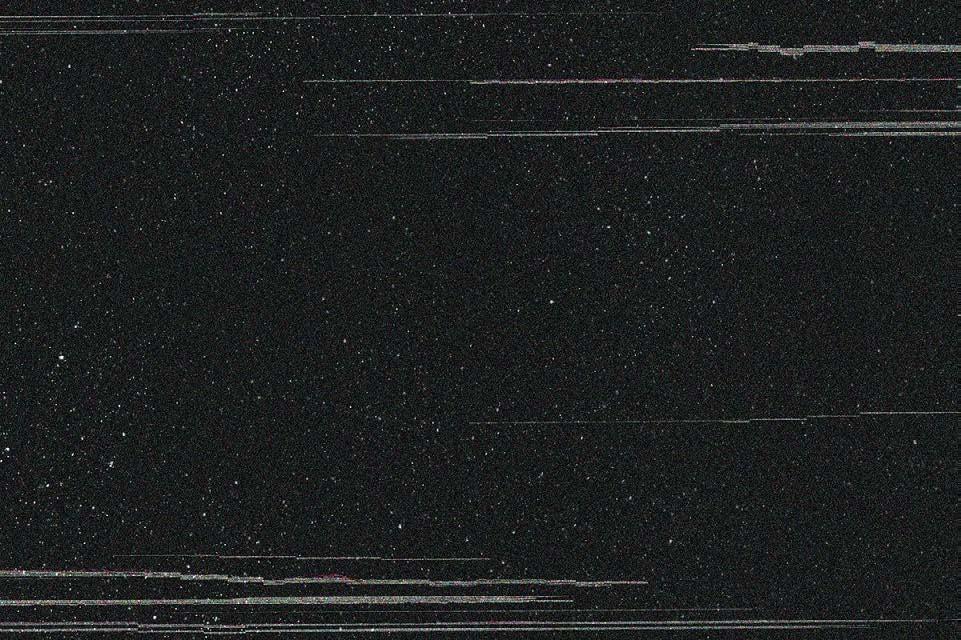





January 19 April 13 May 4 May 18 June 15 11:11 Press Visit us at 1111press.com https://1111press.com
Go from passionate to published.
Benefit from top-tier writing instruction. Our instructors and students have won Emmys, Oscars, Tonys, Pulitzers, and more. Choose from open-enrollment courses in fiction, poetry, nonfiction, screenwriting, and more.
Study in person or online uclaextension.edu/writing-journalism

120 BLUE MOUNTAIN REVIEW september 2023
FICTION

FICTION

AT ETERNITY’S GATE
BY BRENT ATKINSON
The first time I remember seeing my mother die was twenty-two years ago. I was seven. It was a Wednesday morning, and my younger sister and I had fifteen minutes before the school bus arrived.
“Mom,” I said. “Mom, wake up.” The bedside alarm clock had been going off for what seemed like an eternity, but it had probably only been emitting that rhythmic, cracking scream for maybe twenty, thirty minutes.
Aaaeeehh, aaaeeehh, aaaeeehh…
I stood at her bedside, staring at her face. Her eyes were closed, mouth hanging open, a rattling snore coming from her. A stream of drool trailed out the corner of her mouth, settling in an off-white wet spot on the pillowcase.
“Mom.” I raised my voice and reached out, shook her shoulder. “Mom!”
She continued snoring.
I kept shouting her name, rocking her back and forth with both hands clasping her arm. The more I shook her the faster my heart seemed to beat. My throat tightened, as if some invisible hand were closing around it.
“Why won’t she get up?” I hadn’t heard Mandy, my five year-old sister, enter the room. I turned, noticed her expression go from confusion to fear as we made eye contact. She started to cry, burying her face in her hands, blonde hair falling forward. It was at that moment I realized that I was crying, too. Seeing my face was all Mandy needed to understand that something was very wrong.
I glanced at the nightstand. A pill bottle and three empty beer cans sat next to the alarm clock that continued to blare.
Years later Mom would tell me that it was Dad who’d gotten her hooked on the sleeping pills. He’d been in the Army and seemed to have access to an endless supply of prescription meds through the VA. So he introduced her to sleeping pills, Adderall, and oxycodone, among others. When she tried to detox from the pills that she shouldn’t have been taking in the first place, she developed symptoms that caused her doctors to write prescriptions for many of those very medications. She couldn’t handle the withdrawals and didn’t want to tell her doctors what was really going on, so she went ahead with the prescriptions and continued using. She still takes a smorgasbord of pills to this day. I check on her once a week where she lives in a little apartment on the old north end of Missoula by the railroad tracks, barely scraping by on disability benefits. Dad moved down to California for a private security job years ago. I haven’t spoken to him since he left.
Mom would take the sleeping pills after Mandy and I were in bed, chasing them with beer or wine. Then she’d force herself to stay awake, wandering around the house like a zombie, saying and doing things she didn’t remember in the morning. I’d wake up to her in my room sometimes, standing over my bed like a statue. Her eyes were always open, but she was never really there. She’d say strange things like “there’s a coyote in the freezer,” or “cheese doesn’t grow on trees,” then she’d shuffle out, leaving my door standing open, light from the hallway spilling into my room.
Once, as a teenager, I heard her talking in the hallway. I cracked my door open and saw her standing a few inches from a poster print of Van Gogh’s At Eternity’s Gate that hung on the wall. She was speaking to the old, sobbing man in the painting. She kept telling him, “I can’t see myself. I can’t see myself. I can’t see myself.” It was as if she was a vampire, searching for her reflection in an empty mirror.
These midnight highs were the one time of day she had to herself. No kids to bother her, no husband to scream at
123
her. She would escape to some different world, some altered state of consciousness where Dad couldn’t tell her what she was doing wrong, that she was fucking up the family, that she was a bad parent. And even if he did show up and scream at her she wouldn’t remember it anyway.
As I got older, there was something I always wondered. It was a theory. I wondered if, while in that zombie-like state, she did have memories from the night before. Not memories she’d remember when sober, but memories from the last time she was high. Kind of like some fully-immersive video game. I wondered if things would pick up where she’d left off the previous night, as if the pills and the booze were a portal to another world, another dimension where she lived a completely separate existence, the two states of consciousness both distinct and complete, the memories from each never to cross over with the other. I’ve never asked her what she thinks about this theory. I probably never will.
Anyway, back to that morning.
She still would not wake. I took a great, shaking breath, cocked my seven-year-old arm back, and punched her in the nose. A hot flash of pain registered in my hand, radiating up my arm. I turned away and continued to cry, bending over, holding my hand between my knees.
“Mark!” Mandy ran over, looping an arm over my back, getting her face as close to mine as she could.
“It hurts,” I said between sobs. “It hurts. It hurts.”
I finally turned back to look at Mom. It was as if nothing had happened. She continued snoring, drool running from her mouth. The only change was the trickle of blood that began to seep from her left nostril.
It was at that moment I was sure that Mom was dead. Even though she was still breathing, still snoring away, I was convinced that she was gone. I don’t know how much I really knew about death at that time, but my understanding was that she was never going to move again, never going to wake up, never going to kiss and hold me again when I was sad, never going to scratch my back under my shirt, never going to have another screaming match with Dad when he came to pick us up for the weekend.
She was dead like Dinky, my cat that had been hit by a car a few months earlier. I’d been the one to find her sleeping at the edge of the road, bubbles of dried blood around her nose. We’d buried her under a cottonwood in the backyard. I wondered if we’d bury Mom there, too.
Honk! Honk!
I went to the window, cradling my right hand as it continued to throb. The big yellow school bus was sitting out front. I ran through the house and out the front door, Mandy yelling and crying, chasing me.
I stopped at the bottom step and screamed to Louie, the bus driver, “My Mom is dead! My Mom is dead!”
That was the first time my mother died, and when she came back to life she told Mandy and I that she was sorry. She told us she didn’t die, she was just very sleepy, and it would never happen again. But it did. It happened again and again. At some point I stopped trying to revive her. I’d just walk into her bedroom and turn off the blaring alarm. I’d help Mandy get dressed and comb her hair, fix pop tarts or cereal for the two of us. I’d make sure we were at the school bus on time.
I was seven years old when I became the man of my mother’s house, because she did her best to kill herself every night, to escape the pain and the pressure and the insults from Dad, insults which were seething and vindictive and laced with rage, a rage that needed an outlet, and that outlet was Mom.
I’ve inherited that rage myself, but I don’t let it out. It’s bottled and stored deep in my midsection, which continues to grow. I topped three hundred pounds this year, and most of that weight is made of rage. It sits just below my solar plexus. It’s not soft, not flabby, but dense and round, like a bowling ball that’s been lodged in my midsection. And that’s ok. I’d rather it was stored there, safely, than being let out to destroy something, or someone.
The memory of striking my sleeping mother that day still haunts me. I see her face from that morning in my dreams, the blood dribbling from her nose, settling on the pillow. I sometimes feel the pain in my hand. The panic and fear
124 BLUE MOUNTAIN REVIEW september 2023
in my chest. Some nights I wake in a state of hyperventilation.
I spend most of my time alone since Mandy got married and moved across the country. She was my only true friend. I work as a computer programmer from my apartment. I read books and watch movies and play video games with the curtains closed. My skin is the whitest white you’ve ever seen. I take 3,000 IU’s of Vitamin D everyday. I don’t allow anyone to know me. How could anyone know me? I’ve been trying not to become my parents for so long that I don’t know myself. But amid all that trying, I fear I’ve failed. I carry my father’s rage in my body. I am my mother wandering around her home, talking to no one but herself.

Or maybe I’m just the man in Van Gogh’s painting. The world is moving by me, through me, past me, but I close my eyes to it all. Maybe I’m nothing more than a face buried in a pair of hands.
ABOUT BRENT:
Brent Atkinson is an emerging writer, focusing on literary fiction. He holds an MFA in Writing from the Vermont College of Fine Arts. He has published stories in Wild Roof Journal and Tumbleweird. Atkinson broaches topics relating to the working class, mental health, neurodivergence, landscape, climate change, and the environment. He strives to share an original, rurallyfocused voice to the literary community having grown up in the socioeconomically poor, rural southeast Washington state. He resides in the countryside of Pasco, Washington.
https://teachable.sjv.io/c/3209676/1301476/12646

THISTLE
BY CARISSA STEVENS
The Wednesday edition of the County Times hits Mamaw’s porch at 9:30. She’s waiting on it today, gazing through her screen door, and I try to imagine what the delivery boy must see: her round, watery eyes sizing him up through her thick bifocals.
Mamaw’s outside within seconds. She’s only wearing her threadbare housecoat and two strategically placed hair rollers: one in the front, bolstering her whispery gray bangs, and one in the back, lending her enough volume to cover her bald spot. When she returns, she’s retrieved the paper and a few weeds she plucked from her flower beds. She hands the paper to Papaw and throws the weeds in the kitchen trash.
Papaw doesn’t thank her. He just spreads the paper out on the table, being careful not to knock over his mug of coffee or upend his plated egg. It’s over easy and extra runny, just as he likes it. He pretends to look at the headlines on the cover, but quickly thumbs over to his favorite section–the obituaries.
“You want me to take care of these dishes, Mamaw?” I ask. I’m at the other end of the table, picking at my toast. Mamaw doesn’t use a toaster–she butters white bread and places it on her cast iron skillet, and the toast I’ve already consumed sits like a medicine ball in my gut.
Mamaw doesn’t respond, just waves me off, which I take as a no. She pulls up a seat beside Papaw.
“Who’s in there this week?” she asks.
Papaw grunts, but he doesn’t take his eyes off the paper. “A Noland. One of Donald’s boys, I bet. He’s always had his nose in pills.”
Mamaw tuts.
“These are friends of yours?” I ask.
“Nah,” Papaw says. “Donald works at the Dollar General. Edith Brown’s in here too. Sure hate to hear that. Nice lady.”
“Eat up with cancer,” Mamaw says. She looks at me and shakes her head, as though we were both close personal friends of Edith Brown’s and now must grapple with the injustice of her death.
“Sad,” I say. I poke my toast with my index finger and grease rises to the surface.
“You know, all the people me and Papaw went to school with is about gone,” Mamaw says. She points at the paper, still firmly in Papaw’s hands. “Won’t be long until our obituaries are in there.”
“Hopefully you still have some time left,” I say, but her comment doesn’t rattle me. Mamaw and Papaw’s demise–as well as the demise of their relatives, neighbors, and casual acquaintances–is perhaps their favorite topic of conversation.
I’d shown up nearly a week ago, fighting to keep the desperation out of my voice as I talked with Papaw on the porch. There were no bites from the job applications I’d filled out, my bank account was overdrawn, and gas was nearly four dollars a gallon. I needed a place to stay, and I knew Mamaw and Papaw’s magnolia-patterned sofa pulled out into a bed.
“I’m sure we can find things for you to do around here for a little pocket change,” Papaw drawled around his toothpick. And he had–they both had. While I dusted Mamaw’s knick knacks–Precious Moments figurines and glass bowls of candy surely past its expiration date–she listed the items she was bequeathing me and my cousins. While I set their television on the right channel and placed masking tape over any buttons on the remote control they might accidentally mash, Papaw told me about his uncle who hanged himself when Papaw was only a boy. While I refilled Mamaw’s hummingbird feeder, she told me that Papaw stopped breathing in his sleep the night before, and for a few terrifying minutes, she thought all the sand in his hourglass had trickled to the bottom.
“Listen to this,” Papaw says, now, still stuck on the obituaries. “‘In lieu of flowers, Edith’s family asks that you make a donation in her honor to the American Cancer Society.’”
“That’s nice,” I say, still staring at my toast. I hear Mamaw hum her agreement.
“That ain’t all of it,” Papaw says. “It says, ‘There will not be a traditional funeral service. Immediate family will scatter Edith’s ashes at New Smyrna Beach in Florida.’”
I think of waves lapping at a shore, of my feet sunk into soft white sand until they’re ankle deep. Vacations,
127
relaxation—it all seems as foreign to me as Edith Brown herself.
Grandma shakes her head again, and the roller attached to her bangs looks precariously close to jumping ship. “Well, I’ve heard it all now,” she says.
“What?” I ask. “Did Edith hate the beach?”
“Edith was a God fearing woman,” Papaw says, turning the page. There’s nothing but classifieds in the back, though, so he folds the paper and hands it to Mamaw. “I can’t imagine that was what Edith wanted.”
“Is it evil to have your ashes scattered on the beach?” I ask.
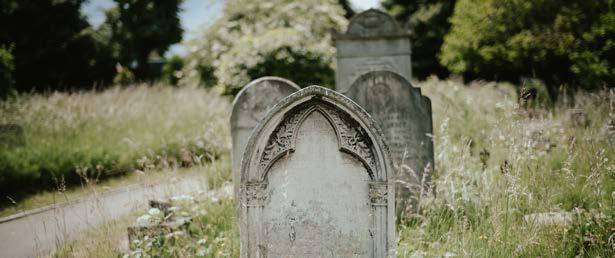
“I can tell you ain’t been to Sunday School in a few years, Sarah,” Mamaw says. Her chin is pointed up, and her bifocals sit so low on her nose that she looks like a disappointed secretary. “It ain’t right to be cremated. It ain’t normal. Your soul won’t get to Heaven that way.”
A laugh bubbles out of me. But Papaw and Mamaw aren’t laughing. They aren’t smiling. They’re looking at me like they did the day I attempted to clean Mamaw’s skillet with dish soap.
“It’s a personal preference, isn’t it?” I say. My voice feels too loud. “I mean, I’ve always thought I’d like to be cremated. It’s better for the environment. I even saw this story on the news where you can put your body in a tree pod and in a few years, you’ll sprout a Sycamore or—”
“That’s enough!” Mamaw interrupts. She points one long, wrinkly finger in my direction, and I notice how hideous her hands are. They’re covered in age spots and burn marks, tallies from years of cooking and scrubbing and having babies and sending them off to the coal mine or to cook and scrub and have babies of their own. “I know you young people got some big ideas, but as long as you’re here with Papaw and me, you’ll stop with that foolish talk. Understood?”
I open my mouth to say something–to tell her that there is a big wide world outside of these hills, ideas and beliefs she and Papaw would never dream of. But I need to stay in their good graces, so instead I duck my head.
“Okay,” I say. “I’m sorry.”
I try not to meet their eyes as I stack empty breakfast plates and carry them to the sink. ***
It’s evening, and I’ve made my way to the front porch rocker. Mamaw and Papaw are inside and, through the screen door, I can hear the canned laughter of their favorite sitcom. They’ll sit side by side in the living room, and Mamaw will repeat every joke to Papaw, even though his hearing is better than hers.
I’m not really listening to them, though. I’m focused on the lightning bugs circling the overgrown front yard. I’m gazing at Mamaw’s trellis, vines winding through the aged wood. I’m feeling the weight of humidity on my shoulders and around my neck like a fancy mink shawl I could never afford.
I know that somewhere in the distance, Mamaw and Papaw’s property bows into the slope of a meadow. And I know in the middle of that meadow sits the family cemetery; generations of my ancestors, some of their tombstones deteriorated from weather and time. And I know, too, eventually Mamaw and Papaw will join them. And my mother. And, despite all my big ideas, me.
I hear a barn owl screech in the distance. I hear Papaw snort out a laugh inside the house. And I feel heavy enough to sink through the wood planks of the porch and into the earth. There is a weed growing inside of me, one of the stubborn, spiky ones Mamaw has to wear gloves to pull.
BLUE MOUNTAIN REVIEW september 2023
YOU HAD ME AT BEZOS
BY Jenna Geisinger
Jud promised himself last time was the last time. Yet, he found himself again settling into his spot on the couch— the cushion cratered from all of his sitting—firing up his laptop. Despite living alone, he checked over his shoulder as if someone new might be standing there, judging, but was greeted instead by the succulent Mia convinced him to buy. She said his apartment was all different shades of dark neutrals and would it kill him to get some life in here. Sometimes the plant made him smile to himself, the nostalgia trapped in the grooves of the little green leaves, and sometimes it made him so sad, he went to bed instead.
A shame creeped up his neck. He tried to rub it away with his palm, then took a swig of beer. Mia left before Jud realized he was in love with her. They’d agreed to be casual. She had a semester left of school and he was bartending through grad school. The best part about grad school was people fell in love with your potential. They could forgive messy apartments, debt, late payments, splitting the bill, all because you had the potential to be more—they just had to wait out this in-between. Jud always used that to his advantage. You could blame a lot of things on studying. You could seem so noble while being cruel.
Neither wanted to get too involved, but their lives connected in all the convenient ways. Jud lived closer to campus and it made sense for Mia to have a drawer of clothes and a toothbrush so she could jet out at 7:50 for her 8:00 class. Their lives were roots reaching further into the soil, more impossibly intertwined as they grew.
Jud scrolled through Mia’s Amazon account with the gritty taste of beer on his teeth. The account was the last link he had of her—their last shared thing. She’d reclaimed her Netflix with a new password, taken her toothbrush, emptied her drawer. All he had left was her Amazon Prime password.
At first, it was accidental. Jud went to buy cleaning supplies in bulk and realized he was still logged into her account. He was going to log out—he wasn’t a snoop, and he shouldn’t waste his money on Bezos anyway, but—but he couldn’t let go, not yet. Losing this, the Amazon account, was official. An end. A period. He couldn’t; he needed more closure than that. Jud scrolled through her orders, looking for signs that she loved him too, that she could not move on. She had blocked him on all of her social media, as if their breakup actually warranted such drastic measures. He just wanted to know how she was doing, if she thought about him. Her cart held new lounge pants and cotton bedtime shirts. A stay-in purchase. An I-Miss-Jud purchase, right?
He felt itchy all over after snooping through her orders, a peeping Tom, but he warmed at the sight of the cotton. He remembered how soft it felt against him as he fell asleep next to her, smiling to himself at her loud, cartoonish snore and the puddle of drool she wiped away with her shirt before (she thought) he noticed. He slept in the glow of the memory, soft around the edges. He hated himself when he woke up, pathetic, but unable to stop.
The next time, after some internal grumbling, he found romance novels in her Saved for Later cart. Mia read Dover Classics in paperback on campus. She always sat cross-legged on a bench in the quad, the front cover bent back so she could hold the book in one hand—a casual reading of Middlemarch or The House of Mirth. He was even a little— jealous? That she devoured classic literature, and he would fall asleep if he tried to read any of those books outside of a class. He read This Side of Paradise and could only point to a quote he liked. As the cover closed, he could hardly remember the protagonist’s name, but he referenced the quote in class once to sound superior to his cohort. When Jud slept at her apartment the first time, he saw the stack of romance novels stuffed under her bed—her secret—and he liked that he knew this side of her, this unrefined part she hid from everyone else. Seeing them in her cart, he felt like he still knew her best. He promised himself that was the last time. But that wasn’t the last time, or the time after that, or the time after that.
And he was just fucking sick to death of himself. His phone buzzed with texts from the girl at the bar where he worked. She had purple hair with brown-gray roots and no freckles. Not like Mia. Mia’s were constellations right there on her cheeks. He liked that the sun left the stars printed on her face. He told the girl from the bar he had to study. He chuckled at her jokes as he refilled her glass. His friend nudged him to go, but he held up his hands in surrender, surrender to the test he didn’t have and the hours he’d spend searching Mia’s orders since he couldn’t have her anymore. Mia hadn’t ordered nearly as much, or he checked too often. Maybe she knew he was watching. Maybe she just— didn’t need as much as she did. She was more complete—or distracted, distracted by someone new, perhaps? A new suitor. It was times like these he wished she didn’t block him from Instagram, but then again, he wouldn’t need Amazon if she
129
hadn’t blocked him.
The second, third, fourth beer in quick succession were settling in, making him just drunk enough to feel invincible, to feel so sure that nothing could go wrong. She missed him. She had to, it whispered, urging him. Or maybe, he could make her remember. He could conjure for her the memories that dogged him daily, that made it impossible to move forward.
Jud added a romance novel with a half-naked man wearing the same shoes as him to her cart. He imagined how Mia would rest her head on his lap while she read, and he’d twist her hair around his fingers, the sun spinning red in her brown curls. Jud could hear the repartee they’d have—he’d say he looked just like the model, and she’d say the comparison stopped at their chucks. He could almost feel her laugh against his thigh, the whisper of her breath on his jeans. He drank more beer. He wondered what would be quintessential Mia—the big romantic gesture that she couldn’t ignore. That she would associate with him. That would make her come back.
He added green pens to her cart, remembering how she used them to edit her senior thesis. The many nights he found her curled on the recliner, half-asleep, editing her tenth printed copy. He coaxed her back to bed, in love with her droopy lids, the green smears on her palms.
Then he added a beanie with giraffe silhouettes and a blue pom pom. He had one from high school he wore when he shoveled snow—a beanie he hoped no one ever saw him wear—but she thought it was cute. She stole it for her walk to class, never prepared for the weather. He added a black sweatshirt in his size, hoping she’d think about being tucked up in it when she stayed over, when the oil heat took too long to warm up. He added a box of flossers because she complained he had regular floss that cut off the circulation to her fingers. He added and added the random tokens of their relationship. Fossils of themselves.
Jud closed his laptop, another self-satisfied swig of beer. Mia always said Jud could never show how much he cared. She said his words were empty. There. She had an Amazon cart full of him showing he missed her. Another swig of beer. He imagined how her resolve would crumple when she saw the Amazon cart. She’d call him. He’d feel warm when he saw her name on his phone again. Mia octopus emoji. He missed its purple tentacles and cartoon smile. He imagined Mia stumbling over her words, trying to regain lost ground with him. She’d be at his door when they hung up.
Jud speared the empties with his fingers and carried them to the recycling can, then ignored the rattle of bottles past—of bottles he should’ve dragged to the curb weeks ago. When he was with Mia, he would hide the bottles so she didn’t know. Or he would drop them in the neighbor’s can as he drove to class or to work. As he looked at the collection of his bottles, he figured this was the spiral end of Act II, when all seemed lost. He used to watch romantic comedies with his mom and he knew he just had to wait it out—they were both pining right now and their reunion would be so much sweeter because of it. He imagined the third act to come, scooping Mia up, kissing her in the hall. Suddenly, everything smoothed over, fixed. Nothing could stand between two people in love, right?
Jud filled a glass with water and chugged it over the sink. It dribbled down his chin, blotting his shirt. As if this one glass could erase the four beers. He filled another, forcing it down, his stomach painfully bloated. This was part of the change—the montage of healthy behaviors he adopted to win her back. He was Danny Zuko in a letterman’s sweater.
Jud had taken Mia to see romantic comedies after he learned of her secret inclinations to trashy romance novels. On Tuesdays, he paid full price to see the classics back on the big screen: Grease, Jerry Maguire, Dirty Dancing—even if that one was more rom than com. They filed out of the theater with the other five people who paid full price to see a movie older than they were. She walked with her arm snaked around his waist—her head on his arm—to the coffee shop in the same plaza where all the middle school kids with beanies and penny boards sipped seven-dollar candy bar lattes waiting for their parents to pick them up. Jud and Mia sipped theirs by a pop art print and held hands across the table, watching each kid in name-brand jeans and designer T-shirts act cool as they climbed into their parents’ minivans. Mia was maybe the only person he knew who rooted for Johnny to be with his dance partner. She thought they made more sense together—the two people who knew each other best, but Jud and Mia both agreed that Johnny’s cousin deserved better than Baby’s annoying sister.
Jud hustled back to his couch, the water sloshing in his belly. He opened his laptop, aiming to add Dirty Dancing to the cart. Maybe she just needed to know they were Johnny and Penny. Baby’s were summer blips, but Johnny and Penny had legs—they were the real deal.
For the first time in a long time, he was prompted to log in. He typed her password and watched the screen shake its head, an emphatic no. He typed it again, slowing down, sure to hit each letter, number, and symbol: Marvin61514! Her dog’s name and birthday. The screen shook again. The third act dream was spilling through the cracks of his cupped palms.
Jud desperately pecked each key, the water cramping in his stomach. He held the shift key for an extra beat and then 1 to ensure an exclamation point. This was his comeback. His moment. He couldn’t win her back if he didn’t show her how much he loved her. How much he could change. The screen froze, and he leaned so far forward in his seat his nose practically skimmed the screen—his breath blooming over the home page—his future strung up in the pause. The screen shook, asking if he forgot his password. But who could forget something like that.
130 BLUE MOUNTAIN REVIEW september 2023
ABOUT JEANNA:
Jenna Geisinger is a fiction writer from South Jersey. She has an MFA in Professional & Creative Writing from William Paterson University and her fiction has been anthologized in Masters Review and Philadelphia Stories.

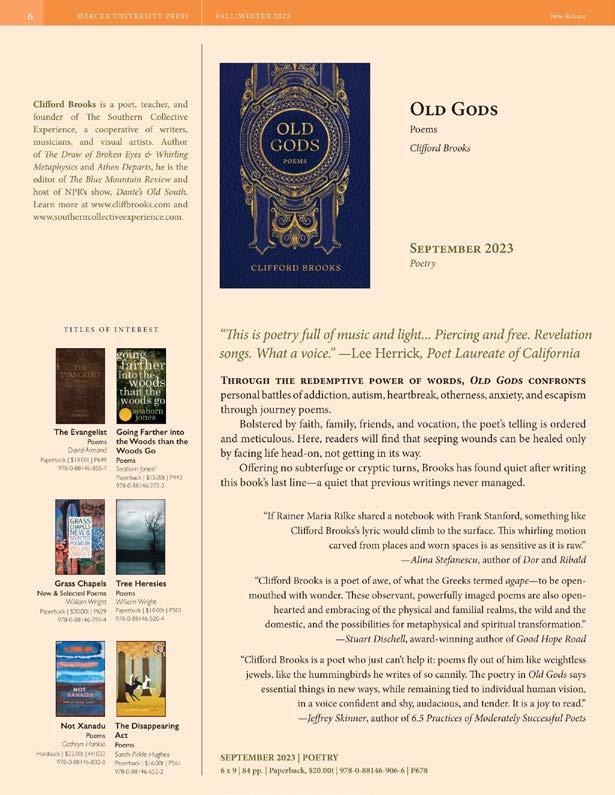
www.southerncollectiveexperience. com
THE WALLS CAME TUMBLING DOWN
BY RICHARD STIMAC
Joshua razed an entire street of houses. Walls, roofs, windows, rooms, memories, all succumbed to his hand. He had brought Monopoly houses outside with him and set them in a row. With the tip of his finger, he smoothed the road of a subdivision and then placed the green houses up down the curb. His tiny fingers gripped the even smaller plastic bulldozer that crawled through the brittle gray dirt along the concrete driveway. By the end, all the green houses were pilled one atop another.
“We need to build a highway,” Josh said. “You people gotta move.”
As the straight blade of the Mattel toy began to clear the tract houses, the boy who himself lived in a tract house, enacted a pantomime, giving separate voices to each character.
“But we got nowhere to go.”
“Not my business.”
“We’ve lived here for years.”
“I own this land now.”
“We want our kids to grow up here.”
“This land is too valuable to waste on kids.”
By the time that Joshua was done, the entire neighborhood was gone. He carefully placed the red hotels where the green houses had been. Here a supermarket. There a big box department store. A gourmet wine shop. A DIY home improvement warehouse. Townhomes. Apartments. A larger park.
“Where will all the people go?”
“They’ll find somewhere.”
Off to the side, a Lego family gripped luggage.
“What will you do?” the mother said.
“Damnit, woman,” the father said. “What do you want me to do?”
Joshua took the child and put him off to the side.
Maud, his mother, watched from the back door of their home. She had kept a few dishes and other kitchen utensils unpacked for one last meal before Nun, Joshua’s father, loaded that last of what they chose to take with them. They were leaving a great deal behind.
Joshua sat at the linoleum kitchen table. Maud put a bologna sandwich and glass of milk next to him. Then she sat, too, and looked out the window at the backyard of mostly dirt with patches of crabgrass.”
“Go on,” she said. “It’s the last time you’ll eat in this house.”
Joshua made loud smacking noises while he ate and rolled his head from side to side. Him mother laughed. When the bologna sandwich was eaten and the milk drunk, Maud took the dishes to the sink, washed them, dried them, then set them on the counter. She looked at them, just looked at them, there, on the counter, on her counter. She wiped her eyes before turning to her son.
“Collect your toys out back. Put ‘em in the bag I set on the steps.”
She took the dishes and put them in the last open box on the floor.
In the backyard, Joshua put the bulldozer, dump truck, land mover, and other big earth machines in the brown paper bag him mother left on the steps. He kicked the green houses and red hotels across the dirt. Finally, he took the squat plastic family to the base of a gray tree and dug a small hole to bury them.
“We gotta leave,” he said to them. “But you can stay here. We’ll come to visit.”
He smoothed the dirt. No one would know that the family was there.
“Come on,” Nun called from the front of the house. “It’s three hours to grandma’s and I don’t wanna be drivin’ in the dark.”
Joshua listened to the adult talk from the front of the house. House doors, car doors, a trunk, opened, then closed. His mother appeared at the corner of the house.
“Got your toys?” she said. “Take the bag. It’s time.”
Joshua took the bag of machines he had used to prepare the backyard for development. His mother took his hand.
133
Just before they left the backyard, for good, he turned and smiled at the small indentation at the roots of the gray tree that seemed to bent forward, like an old man.

As they drove away, Nun white-knuckled the steering wheel. He honked and cussed at other drivers who waited too long at a stop sign. At those who waited too little. At those with blinking turn signals. At those who took quick turns with no warning. At drivers too slow in front of him. Or those too close to the rear. The entire world encroached on him. He struggled to breath.
Maud sat in the backseat with her son. She held his hand and whispered again and again, “It’s going to be alright. Everything will be alright.” She would hold her breath, without purpose, and squeeze the boy’s hand until he had to shake it lose because of the pain. Then she would release a trembling breath, retake her son’s hand, and wait, wait too long, to breath again. A tear, here, there, rolled down her check.
And Joshua, too small to see over the car door, Joshua, he saw the trees that lined his street stand up when the car passed. They turned to him, smiled as only trees can smile, and waved a leafy goodbye. A few times, a house sat higher than the street. The windows blinked and the front door tried to smile, but a sadness held back a bitter joy. Within weeks, this would all be gone, the broken concrete of the curbs and potholed asphalt of the street included. Joshua looked up. His future was a cloudless sky.
BLUE MOUNTAIN REVIEW september 2023
POETRY

POETRY

A CATHEDRAL IS BURNING IN PARIS
BY steve bellin-oka
Forgive us our trespasses numerous as broken umbrellas on April asphalt. Forgive the sakura blossoms their infinite silk confetti clogging the gutters. Forgive our trust in permanence. The thing about a burning cathedral in Paris is I never thought stone could burn. When the spire collapses in slow motion, the ziggurats of Babylon feel again their old wounds, muscle memory of torn mortar and broken bones. We begin in dust and after the smolder return to dust blanketed by dandelions. Even the sun will consume itself in fire— some pray for it and think it cannot come soon enough. Forgive us our weariness: the problem is not feeling nothing; it’s feeling everything. Over a doorframe you wipe away a spider’s weeks of fine-wrought lace. Elsewhere in the world another exquisite stone building collapses. In the ruins, against reason, the spider sets her legs, starts to weave.
137
ABOUT Steve:
Steve Bellin-Oka’s first book of poems, Instructions for Seeing a Ghost (University of North Texas Press, 2020) won the Vassar Miller Prize. He is also the author of four chapbooks, most recently Tell Me Exactly What You Saw and What You Think It Means (SCE Press, 2021), winner of the Blue Mountain Review LGBQT+ Chapbook Prize. He has held fellowships from Yaddo, the Virginia Center for Creative Arts, the Vermont Studio Center, the National Parks Arts Foundation, the University of Missouri-St. Louis, and the Tulsa Artist Fellowship. He lives in Tulsa.

MATINS
BY michael metivier
for William
There is a river beneath the river that fed your escape. I felt it upon waking once, my mind caught off guard still wrestling night’s ancient code through the hourold dawn. I was miles away from the Haw’s cold mirror, in Durango, Chicago, Oquossic with my wife still unmet, my children yet to be born (and then met, born, the more my eyes opened). I saw the spring of its headwaters, Lord, I thought of everything, how, how.
The democratic impulse at six bells, the dam at eight. Give us this day or we take it, daily. There is a river beneath the river that fed the Fear you plied with oar to freedom, Lord, the way those words sound coming out of my mouth. You came out near to the Frying Pan with your fellows in the morning, in the morning, and five days later wrote of “things in Dixie” with Dixie behind you yet like a hellhound, Hell.
139
//
//
Our way led through the sea, our path through the great waters. Through the subterranean waters, though fog and percolation, upwelling and brackish, all of it cleansing, cleansed, each rivulet a liturgy. There is a river beneath the river no one has devised a name for yet, let us praise it, Lord, give us this river in the morning when my children wake up happy and step outside to push their toes through the dew and I sing deeply into the ground, grow.
ABOUT Michael:
Michael Metivier is a writer, musician, and lexicographer from Vermont. His work has appeared in journals including Poetry, Kenyon Review, Northern Woodlands, EcoTheo Review, and African American Review. A split-chapbook with the poet Erín Moure was published by Columba in 2022.

BLUE MOUNTAIN REVIEW september 2023
https://www.uclaextension.edu/writing-journalism/editing-and-publishing/course/grammar-editors-writing-x-4524e


https://www.sweetwaterfamilydentistry.com/
LOVE SONG FOR EMILY
BY LENNY DELLAROCCA
The two of us sat in a clover patch. Your uncle brought a bowl of wet peaches. The scent alone made us hunger, and we took them up to our tongues. We glistened. A jar of bees tingled at my knee like angry guests at a party they could never leave. We didn’t know that your uncle’s loud music was Miles Davis, that horn turning summer so gold. You stood and cartwheeled across the lawn. You thought you danced for no one. Then we dressed up in your aunt’s room. I, in make believe top hat, you trying to walk in stilettos found in a dusty pink box. Girl, we were made of old curious jazz that sometimes hums in young bodies when nobody’s looking. What is love at ten years old. Friends with cool but silly eyes, wild pals who itch for all the innocent Saturdays of life.
143
ABOUT LENNY:
Lenny DellaRocca is founding editor and former publisher of South Florida Poetry Journal. He’s the author of five poetry collections, and his work has appeared in One, Slipstream, Nimrod, Seattle Rev., Gulf Stream, Laurel Rev., Fairy Tale Rev, and others. Poems forthcoming in Cimarron Rev and North Dakota Quarterly. He was interviewed by Grace Cavalieri for The Poet and The Poem on NPR and has been nominated for a Pushcart Prize. He has invented the Epoem, a new form on display at his new poetry journal, Witchery, which is embedded online at South Florida Poetry Journal.

THE DIRECTION LOVE MOVES IN
BY Caits Meissner
To believe in someone so much you become hard in the places they are soft
To protect the boy inside the man who is still running towards the water with his brothers or his sisters or his cousins trailing shirts like flags bare-skinned & gunning towards that cool slip of freedom trusting the water will surely catch him— the man made of sea oh salt oh sweat of stars so am I and so —how can I too turn
that loving eye on myself?
I wipe the lens of myself clean Myself oh how I asked myself & asked everyone for that slice of peace to slide into my mouth & then it came & I became careful for fear that with each moment I take selfish & quiet another parent somewhere dies— wings pulled off & out of sky
I have learned how to bury a mother To mourn
To pray: finally, after these/before these suns I’m not going out like that I will risk it all
I’ve left myself the scraps of pity
145
no more will I surrender god cover my womanhood in disguise layer it on so I can walk undisturbed along the water the song of what-if raps on the skull ticks time backwards & cuts the tape different this time & I am glad the water is & isn’t mine & the night is & isn’t honest & so am I & neither am I

ABOUT CAITs:
Caits Meissner’s poems, comics, nonfiction and curation have appeared in The Creative Independent, The Rumpus, [PANK], Harper’s Bazaar, Adroit, Literary Hub, Split This Rock, Bust Magazine, The Normal School, The Guardian, and Oprah Daily, among others. As Director of Prison and Justice Writing at PEN America, Caits edited The Sentences That Create Us: Crafting A Writer’s Life in Prison (Haymarket Books, January 2022), of which the Mellon Foundation funded 75,000 copies to reach readers in United States prisons free of charge. Her latest project is Flowers For Linda: A new audiozine (some call it “podcast”) about creative relationships, giving the living their flowers, and the surprising lessons of grief.
BLUE MOUNTAIN REVIEW september 2023
147

STATION TO STATION
BY BRENDAN CONSTANTINE
Lovers light their faces in the night
One plays mahjong with a thumb The other watches a lion eat wedding cake
You up?
You alone?
You a hotel burning down?
Pretend the blanket is grass and I am a fallen fence post
or you’re a romance novel left on a train endlessly crossing Kansas
Funny how a room gets smaller around a bed
but vanishes around a phone
To almost touch is to not touch at all To send a picture of where we want to be touched is a postcard from a made-up country
According to the rules, one lover falls asleep first The other stays awake to review the transcript
And between them, all dark fields must roll and all dark hills must roll and all dark seas lay perfectly still
149
ABOUT BRENDAN:
Brendan Constantine is a poet based in Los Angeles. He is the author of several collections and his work has appeared in many standards, among them Poetry, The Nation, Best American Poetry, FIELD, Tin House, and Poem a Day. He currently teaches at the Windward School and, since 2017, has been developing poetry workshops for people living with Aphasia and Traumatic Brain Injuries (TBI).

ODE TO A SUITCASE
BY MARY MORRIS
Dear valise, holy roller, packed carryall, my little Alhambra— cracked leather stitched like a wound. Origami of shirts folded to fish and bird.
Towed on back, hoist & heave, hauled nomadic in lines long with weariness, lugged from mountain town to airport, crossing an ocean toward distant continents.
I unfasten your teeth, open your jaw at Customs under fluorescent and starlit airports in Oaxaca and Serengeti where we have both been searched for
forbidden apples and illicit drugs, X-rayed, patted down by swift hands, sniffed by wolf-sized German shepherd. Haunted. Haggard. Sea salt gathered.
Scent of Andaman. Shirt fragrant with smoke of banyan, curry, cilantro, lavender, cinnamon. Scarf and hat possessed by musk, coffee, cardamom.
Sifted with red dirt, black sand, Jamil’s address. A seashell, empty. Blue pashmina, stamped postcard flamingo, lone silver drachma
at your depths. A peso, a euro forgotten in a pocket, you have been lost, found, unpacked, packed again, snapped shut.
151
ABOUT MARY:
Mary Morris has published poems in North American Review, Poetry, Massachusetts Review, Poetry Daily, and Verse Daily. She is the author of three books of poetry: Enter Water, Swimmer (runner-up for the X.J. Kennedy Prize), Dear October (Arizona-New Mexico Book Award) and Late Self-Portraits (selected by Leila Chatti for the Wheelbarrow Book Prize). A recipient of the Rita Dove Award, Western Humanities Review Poetry Prize, New Mexico Discovery Award, and National Federation Press Women’s Book Prize, Morris has been invited to read her poems at the Library of Congress, which aired on National Public Radio. Most recently, Kwame Dawes selected her work for American Life in Poetry from the Poetry Foundation. www.water400.org.

DYING IS A STORY TOLD TO FRIGHTEN
BY Jared Povanda
And I’m afraid, so I chomp a grape and watch the swollen porch simmer. Pale sticky lips, sangria in a Solo, fruit flies playing tag with my hands. Waxwings singing the mountains blue.
I watch a mouse, narrow as a mitten, get gouged by a fox this peculiar shade of September, pinched fur stepping back the way she crept after telling me
Life is knowing what’s coming and enjoying the day while you can.
153
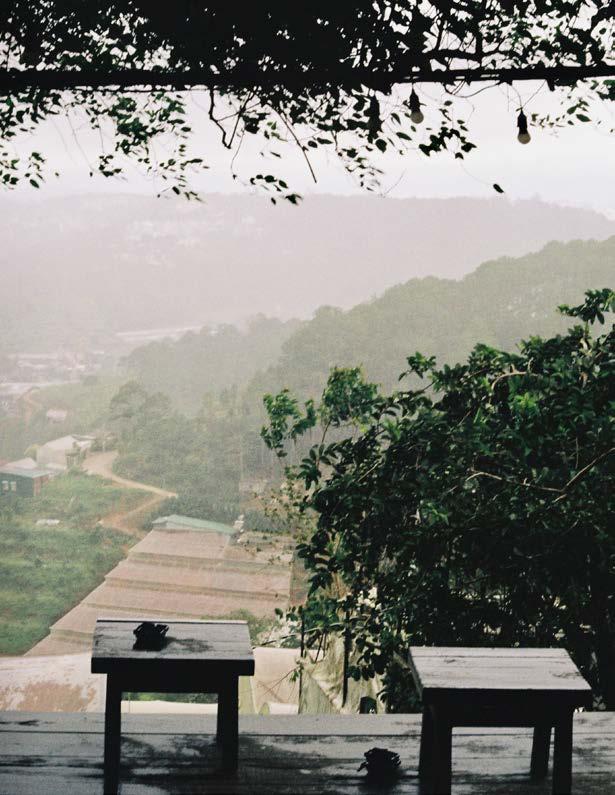
INSIDE A FOREST WHERE THE ONLY WEATHER IS RAIN
BY Jared Povanda
Hindsight is twenty-twenty. Green spreads. Rot masticates. A leaning of ferns looses scent like memories: outward, everywhere, all at once. Sudden clarity is water cupped on the tongue. That lightning strike, that
Oh, that’s why my life is broken—
I broke it.
I broke that hind leg, and now I’m limping to the finish. I’m not faultless. I can admit it here. How my skin soaks against my bones and I rain onto dying leaves and slugs so small they’re dreams of slugs and frogs with croaks like doors closing on rusted hinges. More similes for hurtling headlong into truths perfectly understood only after reaching the end.
155

in Wigleaf
The Citron Review, and Stone Circle
ABOUT JAred: Jared Povanda is a writer, poet, and freelance editor from upstate New York. His work has been published
,
Review among numerous others.
https://www.pendleycreekbrewingco.com
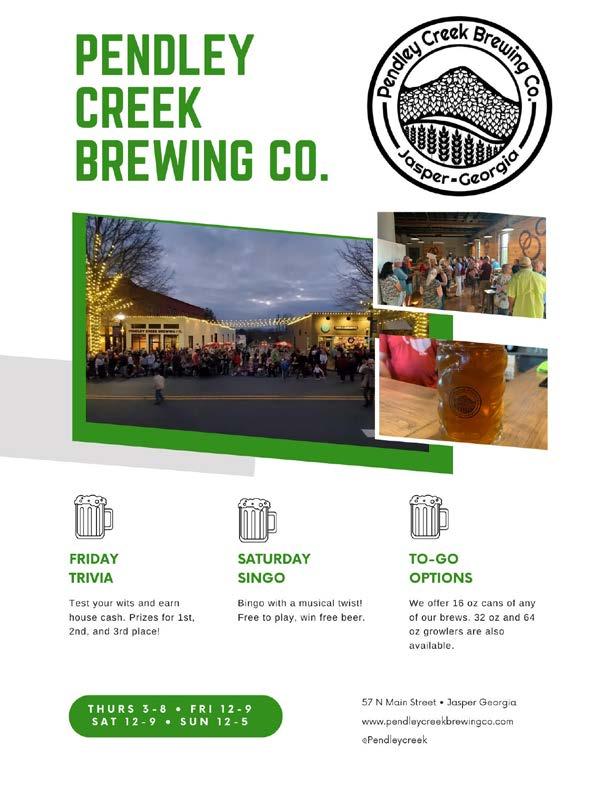
https://www.libertytrusthotel.com

SCAR
BY Alexandra Burack
I live alone on a crescent of red clay that slopes to open water, where uncountable white petals quiver on the tide. Tend the land when gales subside, dust a path with stiff fronds of a broom, leave yellow fibers bent and keloid in the clay. I believe plain places should be made rough, rock struck against rock, like work in the quarry of the heart. In the village, furtive women wait to unfurl from men like wild iris. I know it is easy to give up desire for the expected. My want for wind and sea-spray lifts with the birds held by the sky. We both, invisibly held.
159
ABOUT ALEXANDRA:
Alexandra Burack is a Pushcart Prize-nominated poet, author of On the Verge (Plinth Books), editor, and Adjunct Professor of Creative Writing at Chandler-Gilbert Community College (AZ). A Poetry Reader for The Los Angeles Review, her recent work has been published online in $ Poetry is Currency, Poetica Magazine, FreezeRay Poetry, and Ink & Marrow. She is the Founding Editor of Lumina/Lumina Journal and Invert, and the recipient of poetry grants from the CT Commission on the Arts, and the Ludwig Vogelstein and Haymarket Foundations.

CORD
BY Ana María Caballero
It’s tricky to understand the relation between the boy that rockets my days and the baby that balloons my midsection.
Between the father who falters in a distant location and the brother who deliberately strays. Between the push of the conduit, the live construction
inside, which feeds a fetus after conception, and the pull that sucks meconium away. These links so tricky but not like, I think, incantations
such as precede red scarf, white bird transmutation— no gloved, swift, skilled hands at play. Only, once everyone inside tied—intimate communication:
now, everyone outside untied—yet roped by correlation. Your daughter, sister, mother. Your covey. Yours as in federal, wide rights, packed implications.
For my baby to exit my womb, I’ll require a c-section— gloved, swift, skilled hands will fray a literal cord, an umbilical connection. What remains is so tricky, fabricated words of relation.
161
ABOUT Ana Maria:
Ana María Caballero is a first-generation ColombianAmerican poet and artist. She’s the recipient of the Beverly International Prize, Colombia’s José Manuel Arango National Poetry Prize, the Steel Toe Books Poetry Prize, and a Sevens Foundation Grant. Her Pushcart Prize and Best of the Net-nominated work has been widely published and exhibited internationally, recently at Expanded Art in Berlin, bitforms gallery in New York, JustMAD in Madrid, Gazelli Art House in London, Galloire in Dubai, and L’Avant Galerie Vossen in Paris. Recognized as a Web3 poetry pioneer for her own work, she’s also one of the cofounders of theVERSEverse.

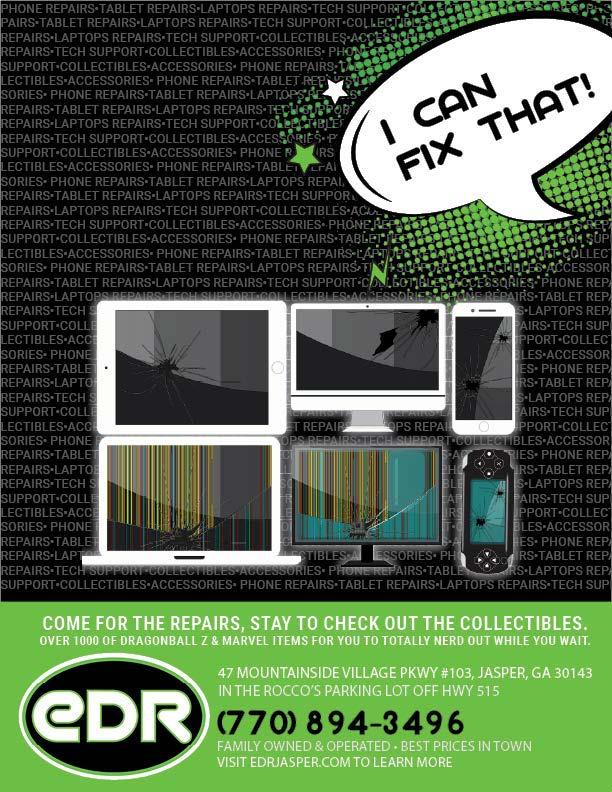
https://edevicerepair.com
will work with nonprofits for donations to advertise.
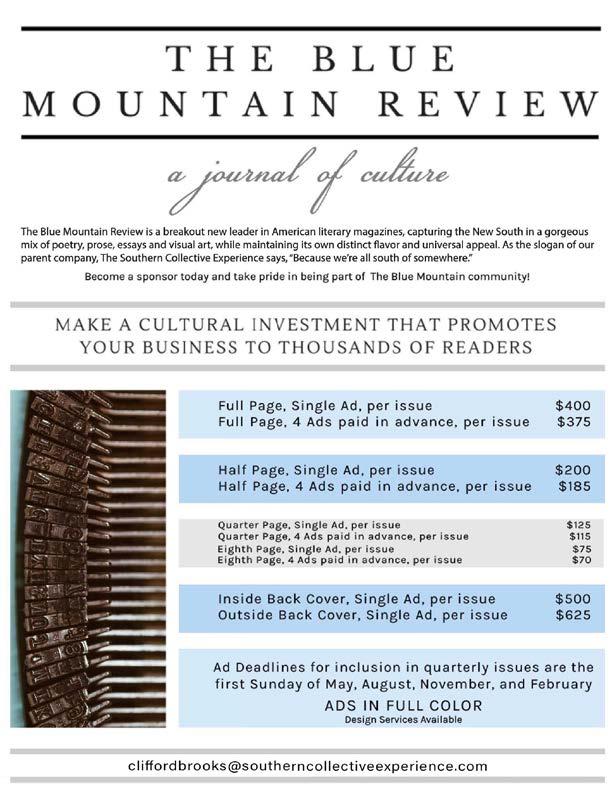
Full-Page Ads: Single Ad, per issue.......................................................$400 4 Ads paid in advance, per issue...................................$375
Half-Page Ads: Single Ad, per issue.......................................................$200 4 Ads paid in advance, per issue...................................$185 Quarter-Page Ads: Single Ad, per issue.......................................................$125 4 Ads paid in advance, per issue...................................$115
SNOW PANTOUM
BY cynthia atkins
My father wore a leather coat, played 8-tracks in the car. Bill Withers ear-worming through the snowy roads. When flakes fell, it pushed our dad’s manic dial. We hooked arms in the backseat, as he sped 90 mph.
Bill Withers ear-wormed through the snowy roads. Our father’s jacket smelled of leather. We hooked arms in the backseat, at 90 mph. The music repeating, I know, I know, I know, I know.
Our father’s jacket smelled of leather. Hearts of trust leapt out of the car. The music was made of I know, I know, I know. When flakes fell, it pushed his manic dial.
Our hearts of trust leapt out of the car. Music made of discord and I knows. Bill Withers ear-wormed the snow. When flakes fell, it pushed his manic dial.
165
ABOUT Cynthia:
Cynthia Atkins (She, Her) is the author of Psyche’s Weathers, In The Event of Full Disclosure (CW Books), and Still-Life With God (Saint Julian Press 2020), and a collaborative chapbook from Harbor Editions, 2022. Formerly, Atkins worked as the assistant director for the Poetry Society of America, and has taught English and Creative Writing, most recently at Blue Ridge Community College. She is an Interviews Editor for American Micro Reviews and Interviews. She earned her MFA from Columbia University and has earned fellowships and prizes from Bread Loaf Writers’ Conference, Virginia Center for the Creative Arts, The Writer’s Voice, and Writers@Work. Atkins lives on the Maury River of Rockbridge County, Virginia, with artist, Phillip Welch and their family. More work and info at:
www.cynthiaatkins.com.

TO DO THE UNSTUDIED THING
BY allyson jones
To make minimals of graces
To cut paper deeply into the night
To trim wind snaps and bows and cupids
To stand on the breast of your lips, proud defiant
Witness to the train track and river Witness to the lonely places
You felt the warmth of their faces after the crash
The blood gushing so briefly, cheeks suddenly indifferent, cold. Wind-scraped prairie. Our humble prayers. Our little house in the big big woods.
Woodsmoke. Deer trails. Danger. Domesticity.
When you’ve pillared a porch, you’ve found love. When you’ve dug a well, you’ve known loss. Marry your children together in the orchard. Bind their hands with soft webbing, forget the misery.
It will come. It will know brief cellars. Fragrant barrels. Memories and memories. That corked up ache.
167

INVISIBLE OTHER
BY allyson jones
I stand you in the kitchen Oil pleasant in the pan. Listless skirt.
You kiss hands that crack on water Describe the line of my shoulder meeting the cabinet.
You’re not there
When I’m ugly Deportment is so important to you
Minutes are time won A kitchen clock drooping Heavy water
Presence is the only difference between god and the devil Time won
The center of the earth draws us we picture dinosaurs ranging
Or instant incineration Resolution, forward or back.
169
ABOUT Allyson:
Allyson Jones is a writer living in Denton, Texas. Her work has been published in journals such as The Rumpus, Bluestem, and the Bayou Review



171 The BLUE MOUNTAIN call for SUBMISSIONS The Blue Mountain Review is accepting new submissions of Poetry, Prose, and Visual Art. The Blue is a Southern publication, but we draw no boundaries or borders on that interpretation. “Southern” is a soul more than a spot on a map, and everyone is south of somewhere. We seek pieces that boldly create something new from the ether of the timeless, works that go beyond sparking interest to ignite something that smolders. Works that matter today and will still matter tomorrow. Visit our submissions page at www.southerncollectiveexperience.com/the-blue-mountain-review Review
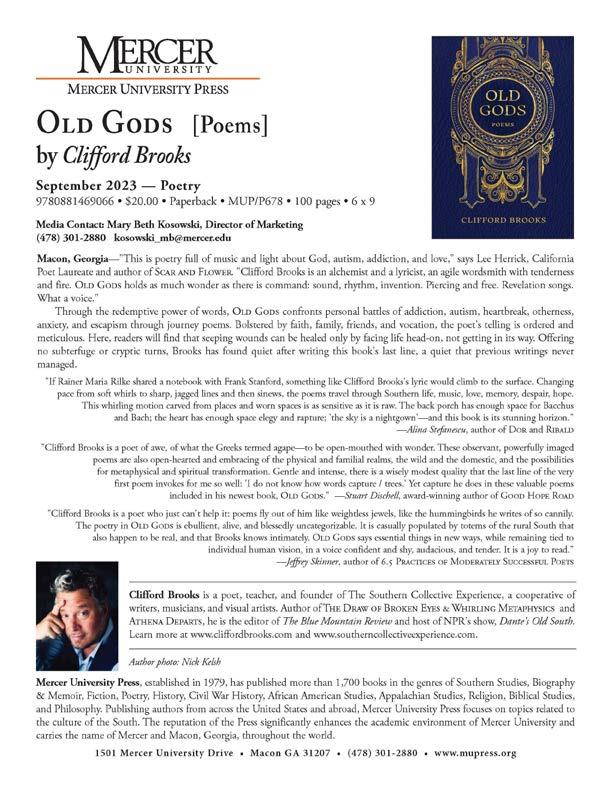
https://www.mupress.org
THE ONLY ONE
BY CHRISTOPHER LOCKE
It is not enough to be alone, though I am. Not enough to stand before a second story window blown open in June, perfumed wrists of small lilac grubbing up through daylight thrummed sticky and green, brief winds carrying a judgment of sweetness—proboscis and honey as the flowers ooze complaints from their many licked ears. Not enough to commiserate, complain about lock down in phone calls with my brothers and my parents, but not my sister, someone I refuse to this day, her life tangled in deceit and rage, another silence to add in my continuing orchestra of loss. And it can’t be enough to have my youngest daughter weep in my arms last night that she’s afraid I don’t love her anymore, that her sister is the only one I notice. Nothing to be said but sweetheart, no, no, no, until she finally quiets, and then stills, and the whole of our house leans into the glittering dark.
173
ABOUT CHRISTOPHER:
Christopher Locke was born in New Hampshire and received an MFA in Poetry from Goddard College. His poems have appeared in, among others, The North American Review, Poetry East, Verse Daily, Southwest Review, The Literary Review, The Sun, West Branch, Rattle, 32 Poems, and The Southeast Review. He won the Dorothy Sargent Rosenberg Poetry Award, as well as grants in poetry from the Massachusetts Cultural Council and the New Hampshire State Council on the Arts. His new book of poems, Music For Ghosts (NYQ Books), and memoir Without Saints (Black Lawrence Press) were both released in 2022. Chris lives in the Adirondacks and teaches English at SUNY Plattsburgh.

https://www.nuci.org

175





176 BLUE MOUNTAIN REVIEW september 2023 Look no further... ONE MONTH FREE plus... 1 DAY FREE TRIAL! OfficeEvolution.com/locations/roswell • roswell.ga@OfficeEvolution.com PRIVATE OFFICES, COWORKING & MEETING ROOMS 470-514-1500 821 Atlanta Street, Roswell, GA 30075 *Inquire within for further details
CLIMATE STRIKE, NEW YORK (SEPT 20, 2019)
BY Kendel Hippolyte
Between the high, glinting, hard, monochrome canyons of commerce flows people endangered-bird-and-butterfly-coloured river of An. I want to flow with it, to sing, believe this banked-in river will rise, insurge into the storeys of generations of glass facades, crack and splinter the narrowed, glittering eyes of Mammon, reach in and flood, flush out and drain away the snarled network of cybernetic nerves insinuating the Krakenhydra’s tentacles into our lives and carry all the detritus of centuries of systemic greed in a deluge down to the still long-suffering sea. I want this with the intensity of the drowning whose greatest want is air. Breath.
And yet I know (how bitterly I know) this river, this multi-coloured moving quilt of our hopes, by evening will settle for subsidence, dribble into backstreets, eddy back to separate mud-pools, fret around the small grey rocks of individual lives before they felt, for those few hours, Earth’s climate roiling inside of them for justice. This river, flowing from farthest ancestor to the unborn, needs us to rise. Rage. Break banks.
177
About KendEl:
His poetry ranges across the continuum of language from Standard English to the varieties of Caribbean English. He has published seven books of poetry, the latest being Wordplanting (Peepal Tree Press, 2019) and his poetry has appeared in regional and international journals and anthologies. He has taught poetry workshops in the Caribbean and the UK. He has performed his work internationally at events such as the Medellin Poetry Festival and Havana Book Fair. He has been the recipient of a James Michener Fellowship to study poetry and an OAS scholarship to study theatre. He is the winner of the Poetry Prize in the Bocas Literary Festival, 2013.

I CORINTHIANS 15:51
BY Kimberly Ann Priest
for Arielle, Alexandria, & Bryan after the Michigan State University shooting February 13, 2023
maybe the moon needed a break that night in its last quarter phase as it rotated toward waning crescent & we viewed its left side from a northern hemisphere at a tilt of -26.195 degrees, which I cannot explain, being a professor of writing, but my daughter can in her junior year taking physics at Michigan State University. she says one of the victims who passed 383, 290.97 km beneath the moon’s half-bright was in her class—just found out. I hadn’t met her yet, she says in a text that mirrors the moon’s 57.45% illumination, which is slightly more than half a light to see by on a very clear night with decreasing visibility from a fugue of ice fog. it’s Valentine’s Day in the hours proceeding & my lover has bought me a scarf, left a note where I wake. I haven’t begun combing through past courses looking for one of their names.
maybe the stars have never been more than stitches in a comfort quilt, each point a puncture where a needle pierced through. & already there in our dark skies of unknowing, the dead admire its handiwork. in a journal, my mother explains my father proposed to her in his Oldsmobile convertible corvette under night sky, the distant MSU streetlamps competition to their sprightly glow. smart, she says of dad, a college man. and I wonder if he could do the math that calculates the lightyears it will take our grief to reach them. my daughter tells me she’s fine—80% humidity, 5.593 mph wind—a placid dusk less than two hours before gunfire & she’ll ask me to buy her a book. & I’ll say yes. my father has moved my mother’s ashes to another room, he says. I call him, a day later, to tell him what happened. i’m fine, I say, just fine.
maybe the green comet has not left our orbit just yet, but has paused, a gaseous bulb in vigil above beyond what we see. the blood in our veins is supposed to stop speaking the moment a heart has stopped beating. be still. I am trying to understand apparent magnitude, the higher the number, the fainter the light. he/she/they feel incalculable. this takes a longer moment to explain. the comet is waiting for my answer. the blood in my veins. I am thinking of my daughter. C/2022 E3 (the comet) is predicted to be about 5.0, maybe visible to the naked eye. this would be helpful, I explain to a God I don’t know; that if, in the twinkling of an eye, as my mother writes, (speaking of change, how quickly our disembodied souls are rendered luminous), we could see them lifted up, if only we did this more: look up where, hem by twinge, like a prayer dusting across a Michigan sky, diatomic carbon & hope.
179
ABOUT Kimberly:
Kimberly Ann Priest is the author of Slaughter the One Bird, finalist in the American Best Book Awards, and chapbooks The Optimist Shelters in Place, Parrot Flower, and Still Life. She is an associate poetry editor for Nimrod International Journal of Prose and Poetry and assistant professor at Michigan State University.

FEVERED CLOVE: WITH A NOD TO BPK
BY LUKE JOHNSON
The truth?
There was never any goat.
Lovers tangled in the knee high grass and groaned the way a goat would when giving birth. The poet caught a freckle of moon
on feral skin and could taste the sweat their teeth exposed, the spice of fevered clove.
The song?
Nobody sang. Unless you count the distant cars on empty interstates and sit beside them turning the dial,
181
to scan for rock n roll. And then there is the tongue that taps the teeth and reminds oneself of Chet Baker. Or what about the heart ( I know I know, the heart that useless thing) that murmurs
like whales under miles of water and makes of its swell a heavy explosion?
I want to believe a head was hung and as it swayed the children circled, pointing to its tongue. But suppose a poet watched lovers mingle and made a music of the smoke they passed. The pleasure of touch like leashing a goat and leading it into the dark.

ABOUT Luke:
Luke Johnson is the author of Quiver (Texas Review Press), a finalist for The Jake Adam York Prize, The Levis Award, The Vassar Miller Prize and the Brittingham. His second book A Slow Indwelling, a call and response with the poet Megan Merchant, is forthcoming from Harbor Editions Fall 2024. You can find more of his work at Kenyon Review, Prairie Schooner, Narrative Magazine, Poetry Northwest and elsewhere. Connect on Twitter at @Lukesrant or through email: writerswharfmb@gmail.com.
The Ghost Gospels
the ghost gospels
poems by: laura ingram

Holding the reader a willing captive in the liminal spaces between life and death, survival and surrender, recovery and decline, Laura Ingram dazzles the heart and mind with the tenderly-wrought insights of a young woman coming to terms with the aftermath of her eating disorder. As the narrator trains her own thoughts away from hunger, the reader is fed hearts from jars, blackberry brambles, and boxes hidden under beds, hearts that have been pickled and skipped like stones across the tops of creeks, hearts grass stained and wobbling and scrubbed pink in the kitchen sink. And bones—bones blooming and curved like question marks, bones kissed and buried and “scrawled against [the] skin like a pharmacist’s signature.” Yet, even as the imagery blooms and fills and increases, becoming ever more tangible, the narrator fears she will dissipate into something no longer substantial, and “you will remember she is only ulna and aspartame and leave her in search of something more solid.”
This is a collection that will break your heart and hand it back to you illuminated between the cracks, for like Kintsugi, the Japanese art of using gold to highlight the cracks in repaired pottery, Ingram’s poems embrace wounds and imperfections rather than glossing over them, modelling that through careful attention and reflection, the selves we can create after we have been broken can be stronger and more beautiful than before.
To puchase your copy or contact the poet: subatomicteenager@gmail.com

Each copy $10
latest work from
introducing Laura Ingram the
When scoliosis pushed her to retire from her career as a massage therapist, Angela Dribben still wanted to be of service, so she began doing legacy work through her local hospice. She felt she needed to gather skills if she was going to honor others, and she started an MFA program at Randolph College. From there her work made its way into journals such as Crab Creek Review, Cider Press Review, San Pedro River Review, Blue Mountain Review, and Crack the Spine. Her first mixed media piece is coming out in Patchwork. Her first collection, Everygirl is now out in advanced sales with Main Street Rag
angela Dribben

“Angela Dribben’s poetry does not look away, even from difficult truths. She brings to the page a gift for sound and image, but it’s her compassionate wisdom that makes Everygirl a book like no other, embracing both indictment and forgiveness, suffering and gratitude, its music that of the phoenix the moment the flames in her throat become song. Bring your broken pieces, your trouble with the world. Everygirl is the best friend to whom you may tell everything, in the dark beneath a fistful of stars, and come away more loving, more loved.”
“How can I believe Adam/ came first when the flower precedes the fruit?” Angela Dribben writes in Everygirl. Coming of age in a Virginia of hunting dogs, pick-ups, and hog farms, these poems, evocative in their details of men “smelling like labor,” food, such as gelatinous ham, military school life for young women, menstruation, rape, and including occasional photographs, bluntly acknowledge the destructive impact of male prerogative when social class and rural life leave few ways out.”
-Susana H. Case, author of Dead Shark on the N Train and Drugstore Blue

“Wordsworth wrote that any great writer must create the new taste by which they’ll be enjoyed. In Everygirl, Angela Dribben doesn’t just offer a new taste, she’s created an entire menu. From tragically vivid poems about surviving military school, to surreal poems exploring belonging, Dribben had me eating out of the palm of her hand. Dribben writes “To love and to see are not the same,” and I agree. But I do both love and see this book.”
-Paige Lewis, Spacestruck
to learn more & purchase visit: https://mainstreetragbookstore.com/product/everygirl-angela-dribben/
184 BLUE MOUNTAIN REVIEW september 2023
the debut collection from
-Rhett Iseman Trull, author of The Real Warnings, editor of Cave Wall
SUNFLOWERS, SUNSHINE, SUN
BY Lynne Kemen
In my memory, the sun always shines. The sky always blue with blousy clouds. The grass is always green and so soft that you can walk barefoot and never find a stone.
The sunflowers shine with crooked teeth. Miniature versions of suns. We camped near the smiling plants. Our house on wheels traveled easily. It wasn’t lonely. There were always cousins and neighbors.
Silent, secret languages among children, subtle cues. Talk, the grownups never noticed. The sound of laughter, music, and wine at night.
Mamma made me a beautiful skirt. How I loved twirling, feeling the wind. We danced together until the skirt got tangled, and I fell, giggling.
185
ABOUT Lynne:
Lynne Kemen lives in the Great Western Catskills of New York and is featured in various literary journals. Her chapbook, More Than a Handful, was published in 2020. She currently serves as the Interim President of Bright Hill Press. Additionally, she contributes as an Interviewer and Essay Editor for The Blue Mountain Review, a culture-focused journal, and holds a lifetime membership with The Southern Collective Experience. Lynne’s upcoming book, Shoes for Lucy, is set to be released in the fall of 2023 by SCE Press.


https://patconroyliterarycenter.org
PAT METHENY ROAD TO THE

SUN


ALBUM OUT NOW : CD / VINYL / DIGITAL
Road to the Sun showcases Metheny’s developed musical hallmarks in compelling new and bravely wrought compositions, expertly performed by kindred spirits and modern masters.

All Music
Harmonically adventurous...beautifully nuanced... toys interestingly with a musical language shared by Debussy and Django Reinhardt....it presents significant additions to the solo, ensemble and transcription repertory from an unexpected quarter.
Wall Street Journal
CONTRIBUTING EDITORS
Jay-de-robinson contributing editor

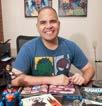
Mr. Classic is the CEO and designer of Mr. Classic’s Haberdashery at Thee Manor in Atlanta, Georgia. A one-stop shop for all things in custom made and classic menswear. From hats all the way down to shoes. His focus mainly being to help individuals develop their personal style. Through the education of fashion and in custom garment designs, he has become the go-to designer for the elegant and high class.
Ahna Phillips contributing editor

Ahna is the executive director of a community-based philanthropic arts organization in metro Atlanta. Her professional experience includes book publishing in Nashville, Tennessee, as a literary agent and freelance writer and editor, as well as in nonprofit leadership in Austin, Texas, at an art studio and gallery for artists with disabilities. She holds an MA in Theology and the Arts and is a singersongwriter with two independent albums.
Contributing editor nicole tallman


J.D. Isip
J.D. Isip is a full-time professor at Collin College and a writer. His poems, plays, fiction, and essays have appeared in a variety of national magazines and journals. His first collection of poems, Pocketing Feathers (2015), was released by Sadie Girl Press, and his second collection,Number Our Days, will be released by Moon Tide Press in 2023. He grew up in Long Beach, California, served in the U.S. Air Force, and worked for Disney before he started teaching.
Photography credits
Adelou Eletu
Alexis Antonio
Anthony Tran
Ari He Mam
Austin Loveing
Awar Kurdish
Edouard Tamba
Eduardo Gorghetto
Emily Hoehenrieder
Janos Patrik
Kinga Howard
Luke Pamer
Mubariz Mehdizdeh
An date
Atypeek Dng
Cottonbro
Danya Gutan
contributing editor
Nicole Tallman serves as Poetry and Interviews Editor for The Blue Mountain Review. She is the author of Something Kindred & Poems for the People (The Southern Collective Experience Press) and Poetry Ambassador for Miami-Dade County. Find her on Twitter and Instagram @natallman and nicoletallman.com.
kaitlyn young design & layouts
Georgia-native, Kaitlyn Young is a freelance graphic designer, specializing in both print and digital creative collateral.
Eberhard Grossgasteiger
Hein Kiler
Ibrahim Yosef
Jeremy Bishop
Ketut Subiyanto
Mohamed Almari
Nastyasensai
Olesia Lebdenko
Ron Lach
Wergio Souza
Shvets Production
Sonny Sixteen
Vidal Balielo Jr.
Yan Miranda
Yogendra Singh
Priscilla du Preez
Radek Grybowski
189
Thula na Toa Heftiba Todd Kent Yuri Efremov
clifford brooks editor-in-chief

Clifford Brooks is the CEO of the Southern Collective Experience and Editor-in-Chief of the Blue Mountain Review. He is also the journal’s content editor.

Aside from these duties, Clifford is the author of The Draw of Broken Eyes & Whirling Metaphysics, Athena Departs, and Exiles of Eden. These collections of poetry can easily be found online.

NICOLE parry SUBMISSIONS CONTENT COORDINATOR

Nicole Parry, M.Ed., BCBA, LBA is a Board Certified Behavior Analyst, licensed in the state of Virginia, who writes care plans for children with Autism and supervises the ABA therapy provided to her clients. She earned her B.S. in Psychology from Bridgewater College and her M.Ed. in Educational Psychology: Applied Developmental Science from the University of Virginia. In her free time, Nicole enjoys reading, writing, singing, and playing piano. She has always had a passion for editing and proofreading, be it academic papers or creative fiction.
Carmen Acevedo Butcher
contributing editor
Carmen Acevedo Butcher is the translator of The Cloud of Unknowing, a Georgia Author of the Year Awardee, and Practice of the Presence by Brother Lawrence, among others. Her dynamic work in spirituality and the power of language has garnered interest from various media, including the BBC and NPR’s Morning Edition. A Fulbright scholar at University of London and Fulbright Senior Lecturer at Sogang University, Carmen currently teaches in the College Writing Programs at UC Berkeley. Online at www.carmenbutcher.com and https://linktr.ee/carmenacevedobutcher
CLAYTON JONES contributing editor
Clayton Jones is a writer, singersongwriter, and professor living in Chickamauga, GA. His poetry and prose has appeared in many journals and magazines including The Cortland Review, Boston Literary Magazine, and American Songwriter. He has written and recorded several albums of original music. He is founder of Southwind Media (southwindmedia.net) where he offers editing and other literary services. He is a professor of English at University of Tennessee at Chattanooga and holds a M.F.A. in poetry from Georgia State University.
lynne kemen contributing editor
Lynne Kemen lives in Upstate New York. Her chapbook, More Than A Handful (Woodland Arts Editions, was published In 2020. Five of her poems appeared in Seeing Things Anthology, Edited by Robert Bensen. Her poems are in La Presa, Silver Birch Press, The Ravens Perch, Blue Mountain Review, Fresh Words Magazine. She was Runner Up for The Ekphrastic Journal’s competition of Women Artists. She is on the Board of Bright Hill Press in Treadwell, NY. Her latest collection of poetry, Shoes for Lucy, is due to realease Fall 2023.

190 BLUE MOUNTAIN REVIEW september 2023
Shannon Perri
Contributing editor
Shannon Perri holds an MFA in Creative Writing from Texas State University and a master’s degree in Social Work from the University of Texas. Her writing has appeared in various newspapers and literary magazines, such as Houston Chronicle, Austin-American Statesman, Joyland Magazine, and fields magazine. Her short story, “Liquid Gold,” was a finalist for the 2019 Texas Observer Short Fiction contest; her story, “The Resurrection Act,” was awarded a 2016 Joyland Magazine Publisher’s Pick; and her story, “Orientation,” was nominated for a Pushcart Prize. She lives in South Austin with her husband, son, and menagerie of pets.
baxter contributing editor
Megan’s first book ‘The Coolest Monsters, A Collection of Essays’ was published in 2018 by Texas Review Press. Her debut novel ‘Farm Girl’ is forthcoming. Megan has won numerous national awards including a Pushcart Prize. Her work has been listed in The Best American Essays of 2019. Recent publications included pieces in The Threepenny Review, Hotel Amerika, The Florida Review, and Creative Nonfiction Magazine. Megan serves as a mentor to young writers and loves developing cross-genre and innovative creative writing pedagogy for her workshops and classes. She is currently conducting research for an environmentally themed novel as well as writing personal essays and poems. Megan lives in New Hampshire where she loves walking her dogs, running, and cooking with local foods.
Evans Contributing editor

Rebecca Evans earned an MFA in Creative Nonfiction at Sierra Nevada University. She’s hosted and co-produced Our Voice and Idaho Living television shows, advocating personal stories, and now mentors teens in the juvenile system. She’s the co-host of Writer to Writer podcast on Radio Boise. Her poems and essays have appeared in The Rumpus, Entropy Literary Magazine, War, Literature & the Arts, 34th Parallel, and Collateral Journal, among others. She lives in Idaho with her three sons.

tom johnson
contributing editor
Tom Johnson was born in Roswell, Ga. He went to college focused on a career in Information Technology but to make ends meet, he worked in a few demanding sales jobs that taught him the ins and outs of marketing. He had always loved writing and he found that marketing gave him an outlet as well as a way to pay the bills. He enjoyed those aspects of his work so much that, after college, he decided on a career in sales instead of going straight into IT. Within a few months, he studied for and passed the Georgia Real Estate Exam. For the next four years he worked for Remax and later Lindsey and Pauly as a seller’s agent. After that, he became the Director of Marketing and Residential Support for a computer company. There he helped them to increase their visibility, develop new leads and on occasion, write content for client’s websites. In late 2009, he decided to go solo as a freelance copywriter for a wide array of clients. In recent years, he has been branching out into fiction and entertainment writing. His first book is slated to be published in 2020.
Mildred Kiconco Barya
contributing editor
Mildred Kiconco Barya is a writer from Uganda and Assistant professor at UNC-Asheville where she teaches creative writing and world literature. Her publications include three poetry books as well as prose, poems or hybrids in Tin House, poets.org, Poetry Quarterly, Asymptote Journal, Matters of Feminist Practice Anthology, Prairie Schooner, New Daughters of Africa International Anthology, Per Contra, and Northeast Review. Her nonfiction essay, Being Here in My Body won the 2020 Linda Flowers Literary Award and is forthcoming in the North Carolina Literary Review. She received a Ph.D. in English from the University of Denver, MFA in creative writing from Syracuse University, and B.A. in Literature, Makerere University. Visit her blog: http://mildredbarya.com/
asha gowan contributing editor



Asha Gowan, poetry editor, hails from Chapel Hill, NC. She writes poetry, fiction, and non-fiction. Her subject matter usually revolves around matters of the heart, but natural world and its imagery also figure prominently in her work. She has publications in The Coraddi, Blue Mountain Review, The Gathering of Poets, and other magazines and journals.

191
Megan
rebecca
Dusty huggings
Music editor
Dusty Huggins is a family man, musician, writer, and lover of literature. His interest in writing surfaced during his freshman year at Young Harris College due to an English professor nurturing his interest, stimulating passion, and building the confidence required to find his way as a writer. Dusty is the founder of the Atlanta blues-based, Southern rock band The Ides of June, and also performs as both the lead vocalist and bassist. He is a member of The Southern Collective Experience acting as the music editor for its journal of culture The Blue Mountain Review. In his spare time Dusty enjoys touring with The Ides of June throughout the southeast.
contributing editor

Emily Kerlin has published poems in Intima: A Journal of Narrative Medicine, Bridge, Cider Press Review, Storm Cellar, The Pittsburg Poetry Journal and Blue Mountain Review. Her chapbook, Eighteen Farewells, won second place in the 2020 Women of Resilience Chapbook Contest. She attended Antioch College and holds a Master’s degree from the University of Illinois in Bilingual Education. Her current home is in Urbana, Illinois where she works with international students and families. You can find her at emilykerlin.com
contributing editor drew robertston
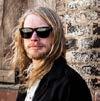
Drew Robertson is studying journalism and creative writing at Mercer University. When she’s not doing schoolwork, she can be found giving tours of campus, having a movie night with friends, or curled up reading a book. Her own fiction writing is interested in exploring small stories about real people, snapshots into the lives of women grieving, creating themselves, and reckoning with the force of commitment in modern female lives. She has been published in Discovering Bulloch, Prometheus Dreaming, and The Dulcimer. Upon graduation, she hopes to attend an MFA program in creative writing and pursue a career in academia or publishing.
whitehorne contributing editor



Andy Whitehorne is a writer and live music fanatic residing in Atlanta, Georgia. He spent two-and-a half-decades regularly attending live concerts and working in the hospitality industry. He holds a BFA in theatre, currently works in customer success, and is the Music editor of the Blue Mountain Review.
Angela dribbens Contributing editor

Angela Gregory-Dribben lives with her two favorite redheads down in a bottom in Southside Virginia where they are hard at work growing the fattest sandwich tomato in the Piedmont’s trademark red clay. Her poetry and essays can be found or are forthcoming in Main Street Rag, Deep South, Blue Mountain Review, San Pedro River Review, Motherscope, Crab Creek Review, Crack the Spine, Cirque, decomp, New Southern Fugitive, and others. A Bread Loaf alum, she is currently a student in Randolph College’s MFA.

Heather M. Harris is an emerging writer of memoir, poetry, short-stories, children’s books, and an illustrator who lives and writes in the New Orleans area. Heather holds a Master’s of Arts and Teaching and a Bachelor’s of Arts and Sciences in Psychology both from Southeastern Louisiana University. Heather is a contributor for The Blue Mountain Review, and a member of The Southern Collective Experience.
Laura Ingram is poetry editor and social media manager for the Southern Collective Experience. She has had work published in one hundred journals and magazines, among them Gravel and Juked. She is the author of four poetry collections: Junior Citizen’s Discount, Mirabilis, The Ghost Gospels, and Animal Sentinel.
192 BLUE MOUNTAIN REVIEW september 2023
andy
Emily Kerlin
Heather Harris contributing editor
Laura Ingram contributing editor
Debbie hennessey contributing editor

Debbie Hennessey was named AC40
Female Artist of the Year by New Music Weekly and scored a Top 20 Hit on their AC40 Charts. A song she cowrote recently hit the Top 5 on Roots Music Report’s Americana Country chart. Her songs have been honored by Great American Song Contest, International Songwriting Competition, Billboard World Song Contest, and others. Her music and videos have aired on USA/UHD Networks, NBC, GAC, Extra, and The Next GAC Star. She has over a dozen releases on her label Rustic Heart Records and is a voting GRAMMY member. In addition, Debbie was the managing editor of LA411 & NY411 for Variety and has created several magazines and directories for various industries over the years. Through her company Entertainment Editorial, she works with a diverse range of clients to meet their editorial needs. She also writes for Dante’s Old South Radio Show blog and the Blue Mountain Review. You can find Debbie at www.entertainmenteditorial.com and www.debbiehennessey.com.
contributing editor
Slade Gottlieb is a fiction writer born in Atlanta and raised in Milton, Georgia. He received his BA in creative writing from Oberlin College and his MFA from California College of the Arts. He’s published short fiction in print editions of the Plum Creek Review and Wilder Voice Slade currently resides in Oakland, California, where he is at work on his debut novel. He currently co-edits fiction and poetry for The Blue Mountain Review.

Logan merill
contributing editor
Logan Merrill: Born and raised in a small town, I’ve made my way through trade. From drywall to drumset to bartending, I fell in love with the power of experiences; the dormant potential of every moment. We’re all humans, being the best we know how to and I believe life is meant to be enjoyed.

jennifer avery
Contributing editor
Jennifer Avery is an editor and writer from the foothills of Northwest Georgia. Her poetry has been published in the Blue Mountain Review and featured on Dante’s Old South. She spends much of her time attempting experiments in skincare and wordcraft. She is currently working on her novel, Ezra in Every Dimension.
Chris terry contributing editor

Chris Terry draws from his fanatic love of films & music when crafting his reviews. After receiving his Master›s in Fine Arts from the Savannah College of Art and Design, he’s gone on to work on numerous independent and major films along with producing film scores and music for a wide variety of genres. Chris is currently working with the film production company Fifteen Studios on upcoming projects.
Hester L. Furey
contributing editor
Hester L. Furey is a poet and literary historian who lives in Atlanta.

Jess Costello
contributing editor
Jess Costello is a fiction editor, writer, counseling student, and indie music nerd based in Massachusetts. In addition to The Blue Mountain Review, her work has appeared in Boston Accent and iO Literary, and she covers local art for Boston Hassle. She is at work on a novel.


edward austin hall contributing editor
Edward Austin Hall lives in Atlanta, where he writes whatever he can get away with.

193
slade gottlieb
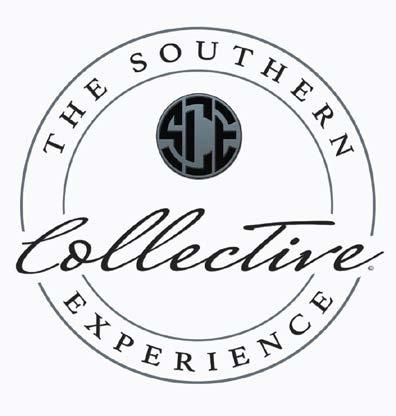
194 BLUE MOUNTAIN REVIEW september 2023



























 by NICOLE TALLMAN
by NICOLE TALLMAN
























































































 by CLAYTON JONES
by CLAYTON JONES






 by Kevin Cantwell
by Kevin Cantwell
 by Marissa Glover
by Marissa Glover
 by Cathryn Hankla
by Cathryn Hankla
 by Denton Loving
by Denton Loving








 by LYNNE KEMEN
by LYNNE KEMEN


















 by ALICIA BLUE
by ALICIA BLUE




 Christopher Castellani, author of Leading Men
Christopher Castellani, author of Leading Men















 BY JAY-DE ROBINSON A.K.A. MR. CLASSIC EDITED BY NICOLE PARRY
BY JAY-DE ROBINSON A.K.A. MR. CLASSIC EDITED BY NICOLE PARRY






 KATHRYN KULPA’S
KATHRYN KULPA’S

 REVIEWED BY LYNNE KEMEN
REVIEWED BY LYNNE KEMEN











































































































